
Q series
User Manual
V1.0

i
Contents
About This Document ........................................................................................................................ 4
Safety Instruction ............................................................................................................................... 5
1 Overview .......................................................................................................................................... 8
1.1 Introduction .................................................................................................................................................................. 8
1.2 Parts .............................................................................................................................................................................. 8
1.3 Ports ............................................................................................................................................................................ 11
1.4 Front Buttons .............................................................................................................................................................. 13
1.5 Remote Control ........................................................................................................................................................... 14
2 Installation Guide .......................................................................................................................... 17
2.1 Safety Precautions ...................................................................................................................................................... 17
2.2 Installation Precautions ............................................................................................................................................... 18
2.3 Installation .................................................................................................................................................................. 20
2.4 Installing the OPS (Optional) ..................................................................................................................................... 21
2.5 Installing Newline Assistant ....................................................................................................................................... 22
2.5.1 Introduction ............................................................................................................................................................. 22
2.5.2 Installation ............................................................................................................................................................... 22
3 Getting Started .............................................................................................................................. 23
3.1 Power On .................................................................................................................................................................... 23
3.2 Power Off ................................................................................................................................................................... 24
3.3 Calibration .................................................................................................................................................................. 25
4 Operating the Touch Screen ......................................................................................................... 28
4.1 Profile Logon .............................................................................................................................................................. 28
4.2 Home .......................................................................................................................................................................... 30
4.3 Sources ....................................................................................................................................................................... 35
4.4 Preview window ......................................................................................................................................................... 35
4.5 OPS ............................................................................................................................................................................. 36
4.6 Screen Sharing ............................................................................................................................................................ 36
4.7 Whiteboard ................................................................................................................................................................. 37
4.7.1 Whiteboard Functions .............................................................................................................................................. 39
4.7.2 Page Operations ....................................................................................................................................................... 48

ii
4.7.3 Whiteboard Setting .................................................................................................................................................. 49
4.8 Annotation .................................................................................................................................................................. 52
4.9 File Management ........................................................................................................................................................ 55
4.9.1 File Viewer Page ...................................................................................................................................................... 55
4.9.2 File Preview ............................................................................................................................................................. 56
4.9.3 File Search ............................................................................................................................................................... 56
4.9.4 File Filtering ............................................................................................................................................................ 56
4.9.5 New Folder .............................................................................................................................................................. 57
4.9.6 File Operation .......................................................................................................................................................... 57
4.9.7 File Name ................................................................................................................................................................ 58
4.10 Browser ..................................................................................................................................................................... 58
4.11 Apps folder ................................................................................................................................................................ 59
4.12 Add Shortcut ............................................................................................................................................................. 60
4.12.1 Add Shortcuts to Home Page ................................................................................................................................. 60
4.12.2 Add Quick Start Windows Programs in Smart System .......................................................................................... 63
4.13 Automatically Power Off .......................................................................................................................................... 65
4.14 System Settings ......................................................................................................................................................... 65
4.14.1 Network Settings ................................................................................................................................................... 65
4.14.2 Language and Input ............................................................................................................................................... 66
4.14.3 Date and Time Settings .......................................................................................................................................... 67
4.14.4 Storage ................................................................................................................................................................... 69
4.14.5 Applications ........................................................................................................................................................... 70
4.14.6 Display & Theme ................................................................................................................................................... 70
4.14.7 Tool Bar ................................................................................................................................................................. 71
4.14.8 Input and Output Setting ........................................................................................................................................ 72
4.14.9 Power Setting ......................................................................................................................................................... 72
4.14.10 Screen Eye Filters ................................................................................................................................................ 75
4.14.11 System .................................................................................................................................................................. 76
5 Quick Setting Menu ...................................................................................................................... 81
6 Serial Port Control ........................................................................................................................ 83
7 FAQs & Troubleshooting .............................................................................................................. 90
8 Specifications ................................................................................................................................. 93
9 More Information ......................................................................................................................... 96

Welcome to the world of Newline
Thank you for choosing the Q series Interactive Flat panel display. Please use this document
to get the most out of your screen.
This device complies with part 15 of the FCC Rules. Operation is subject to the following two
conditions: (1) This device may not cause harmful interference, and (2) this device must
accept any interference received, including interference that may cause undesired operation.
NOTE 1: This equipment has been tested and found to comply with the limits for a Class B
digital device, pursuant to part 15 of the FCC Rules. These limits are designed to provide
reasonable protection against harmful interference in a residential installation. This equipment
generates, uses, and can radiate radio frequency energy and, if not installed and used in
accordance with the instructions, may cause harmful interference to radio communications.
However, there is no guarantee that interference will not occur in a particular installation. If
this equipment does cause harmful interference to radio or television reception, which can be
determined by turning the equipment off and on, the user is encouraged to try to correct the
interference by one or more of the following measures:
Reorient or relocate the receiving antenna.
Increase the separation between the equipment and receiver.
Connect the equipment into an outlet on a circuit different from that to which the
receiver is connected.
Consult the dealer or an experienced radio/TV technician for help.
NOTE 2: Any changes or modifications to this unit not expressly approved by the party
responsible for compliance could void the user’s authority to operate the equipment.
The symbol of the crossed out wheeled bin indicates this product should not be placed in
municipal waste. Instead, dispose of waste equipment by taking it to a designated collection
point for electrical and electronic equipment recycling.
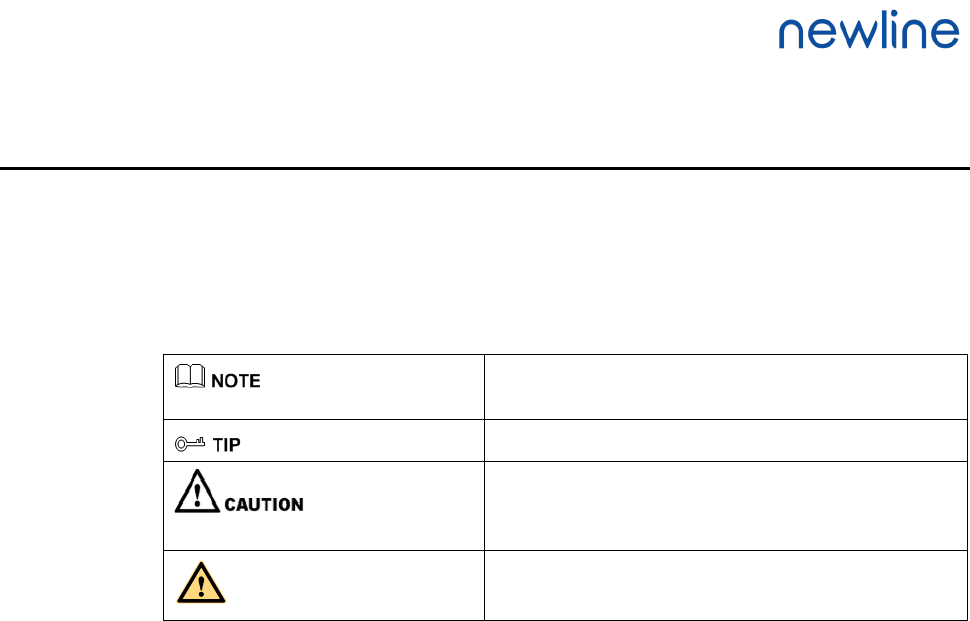
4
About This Document
This document describes multiple functions, instructions, and notes about the product.
Symbols are used in this document to indicate operations that need particular attention. The
symbols are defined as follows:
Provides additional information to supplement
operation in the main text.
Provides tips for operation.
Indicates a potentially hazardous situation that, if not
avoided, could result in equipment damage, data loss,
performance deterioration, or unanticipated results.
Indicates a hazard with risk that, if not avoided, could
result in death or injury.
WARNING
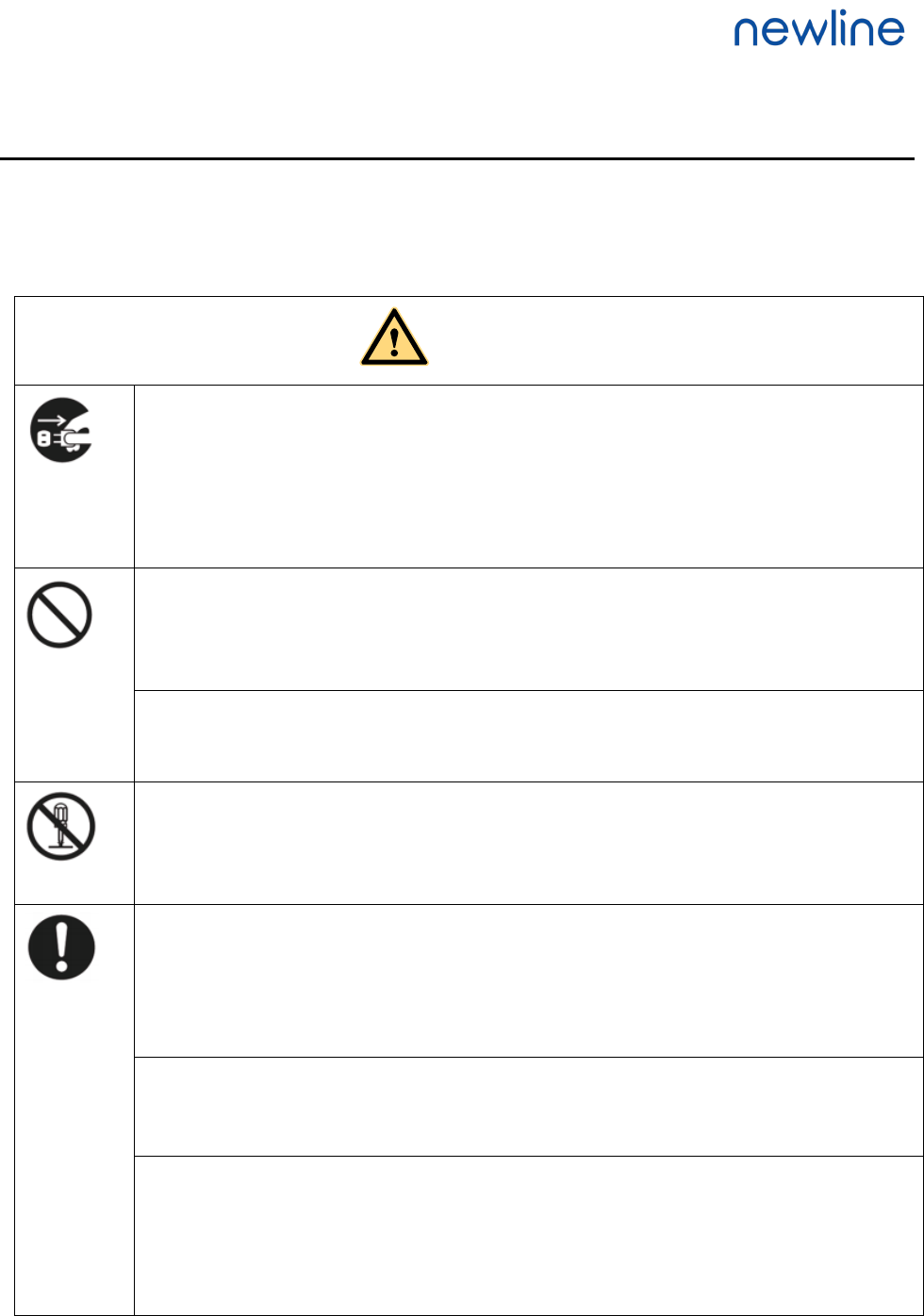
5
Safety Instruction
For your safety, please read the following instruction before you use the product. Serious injury or property
damage may be caused by improper operations. Do not try to repair the product on your own.
Disconnect the product from the power supply immediately if major failures occur.
Major failures include the following:
If smoke, a peculiar smell or an abnormal sound is discharged from the product.
No image or sound is displayed, or the image error occurs.
In the preceding scenarios, do not continue to use the product. Disconnect power supply
immediately and contact professional staff for troubleshooting.
Do not drop any liquids, metal, or anything combustible onto the product.
If any liquids or metal are dropped onto or into the product, power off the product and
disconnect the power supply. Then contact professional staff for solutions.
Pay attention to children when they are close to the product.
Put the product on a stable surface.
An unstable surface includes, and is not limited to, an inclined plane, a shaky stand, desk or
platform, that might cause the product to turnover and be damaged.
Do not open the panel or change the product on your own.
High voltage components are installed in the product. When you open the panel, high voltage,
electric shock, or other dangerous situations may occur.
If inspection, adjustment, or maintenance is required, contact the local distributor for help.
Use the provided power supply.
To prevent the product from being damaged, do not use any types of power cables other than
the one provided with the product.
Use a three-wire socket and ensure that it is properly grounded.
Pull out the power plug from the socket if the product is not used for a long period.
Clean the power plug regularly.
Fire or electric shock may be caused if the product is powered on while you are cleaning.
Pull out the power plug before cleaning it with a dried cloth.
Power output port is 5V/2A.
The voltage/current of the rear power output port is 5V/2A (maximum). Purchase the power
code/AC adapter according to customer needs. The port can be used for the Newline X10D
Android box. Please do not connect any products with different power requirement. Otherwise,
it may cause damage to products or fire.
WARNING
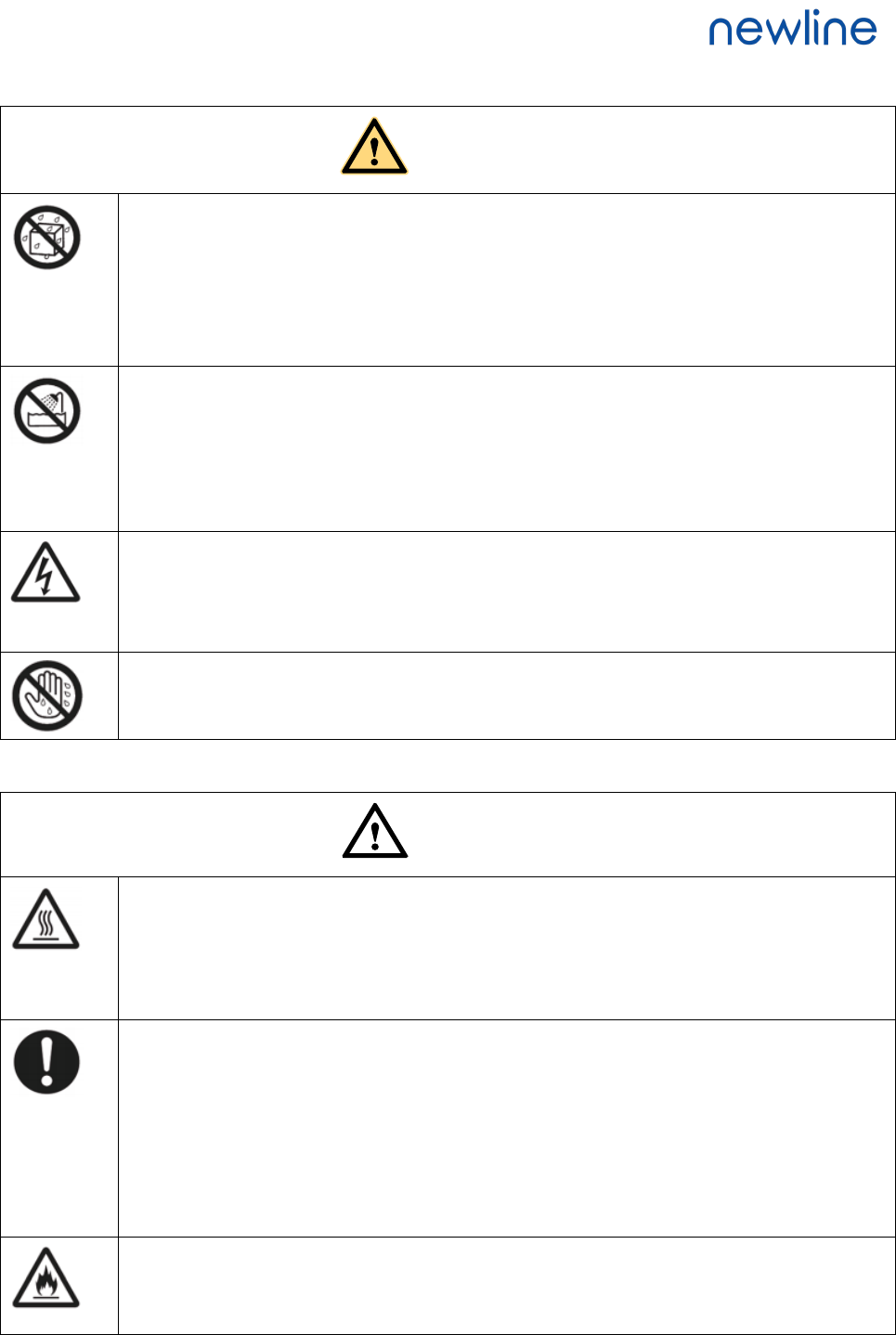
6
Do not put items on the top of the product.
Do not put items, such as a container for liquid (a vase, flowerpot, cosmetics, or liquid
medicine) on the top of the product.
If any water or liquid is spilled on the product, the product may short circuit and cause fire or
electric shock.
Do not walk on or hang any items on the product.
Do not install the product in an improper place.
Do not install the product in humid places, such as the bathroom, the shower room, near
windows, or outdoor environments that experience rain, snow, or other harsh weather. Avoid
installation near hot spring vapor. The preceding environments may cause faults in the product
or electric shock under extreme conditions.
Do not put an exposed fire source, such as a lit candle, on the product.
Pull out the power supply during thunderstorms.
Do not touch the product during a lighting storm, you may experience an electric shock.
Install or place components that supply high enough voltage to cause personal injury out of the
reach of children.
Do not touch the power cable with wet hands.
Do not install the product in high temperature environments.
Do not install the product near a heat source, such as a radiator, a heat reservoir, a stove, or
other heating products.
Do not expose the product to direct sunlight, which may cause high temperatures and
subsequent faults in the product.
When transporting the product:
Pack the product for transport or maintenance by using the cartons and cushioning material
provided with the product.
Move the product vertically during transport. The screen or other components are easily
broken if the product is moved in an improper way.
Before you move the product, disconnect all external connections and separate all topple
preventing products. Move the product carefully to prevent it from being hit or squeezed,
especially the screen, which may cause injury if broken.
Do not cover or block up any vents on the product.
Any overheated components may cause fire, damage the product, and shorten the service life.
Do not lay the product down in a way where the venting surface will be covered.
WARNING
CAUTION
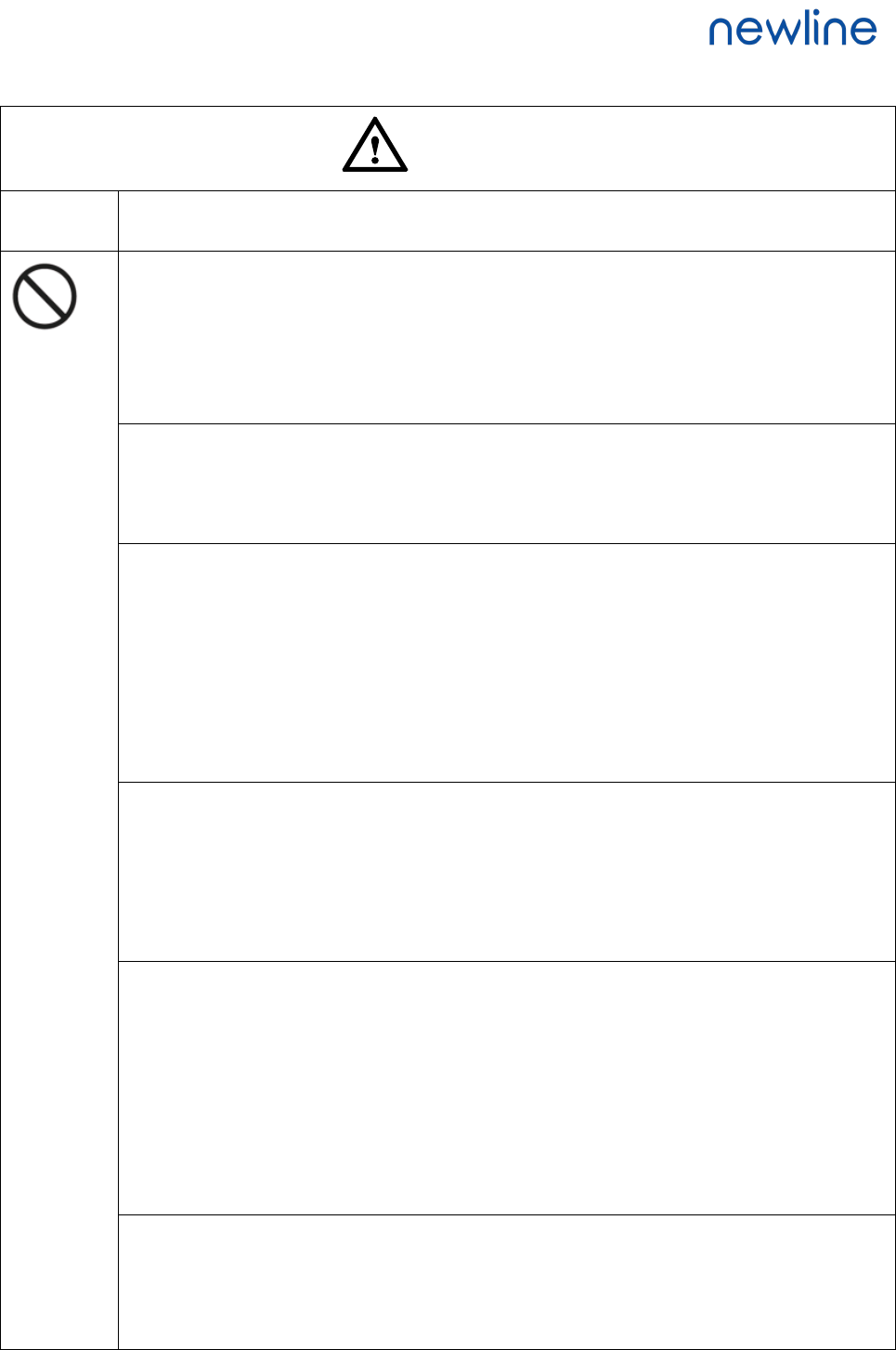
7
Do not install the product on carpet or cloth.
Do not use a cloth, such as table cloth, to cover the product.
Keep the product away from the radio.
The product complies with the international EMI standard to pervent radio interference.
However, interference may still exists and causes noise in the radio. If noise occurs in the radio,
try the following solutions.
Adjust the direction of the radio antenna to avoid the interference from the product.
Keep the radio away from the product.
If the screen glass is broken or falls off:
Keep all personnel 10 feet away from the screen to ensure safety.
Do not perform any installation or disassembly while the screen glass is broken or has fallen
off.
Use the battery correctly.
Galvanic corrosion, electric leakage, and even fire may be caused by improper battery usage.
It is recommended to use the designated type of battery and install the battery by the correct
electrodes (positive and negative).
Do not install and use a new battery with a used one.
Take out the battery if the remote control is not used for a long period.
Do not expose the battery to overheated environments, such as sunlight or heat sources.
Dispose of the used battery based on your local regulations.
Do not damage the power cable.
Do not damage, change, twist, bend, or forcibly drag the power cable.
Do not put weights (such as the product itself) on the power cable.
Do not forcibly drag the cable when you pull out the power plug. If the power cable is
damaged, please contact the local distributor to repair or replace it.
The power cable in the accessory box is for this product only. Do not use it on other products.
Additional advice:
Use the product in an environment with comfortable lighting. It is harmful to your eyes to
watch in a too bright or too dark environment.
Relax your eyes watching for a period of time.
Keep sufficient distance from the product to protect your eyes and prevent eyestrain.
Adjust the volume to an appropriate level, especially at night.
Use amplifier equipment as the audio input source with caution. If you must use amplifier
equipment, the input power should not exceed the maximum of speaker power. Otherwise, the
speaker can become overpowered and damaged.
About USB port.
Front USB ports and rear USB 3.0/USB 2.0 ports switch connections based on signal sources. If
the current signal source is reading the data from an external product connecting to the port,
please switch the signal source after the data reading is complete. Otherwise, the data or product
may be damaged.
CAUTION
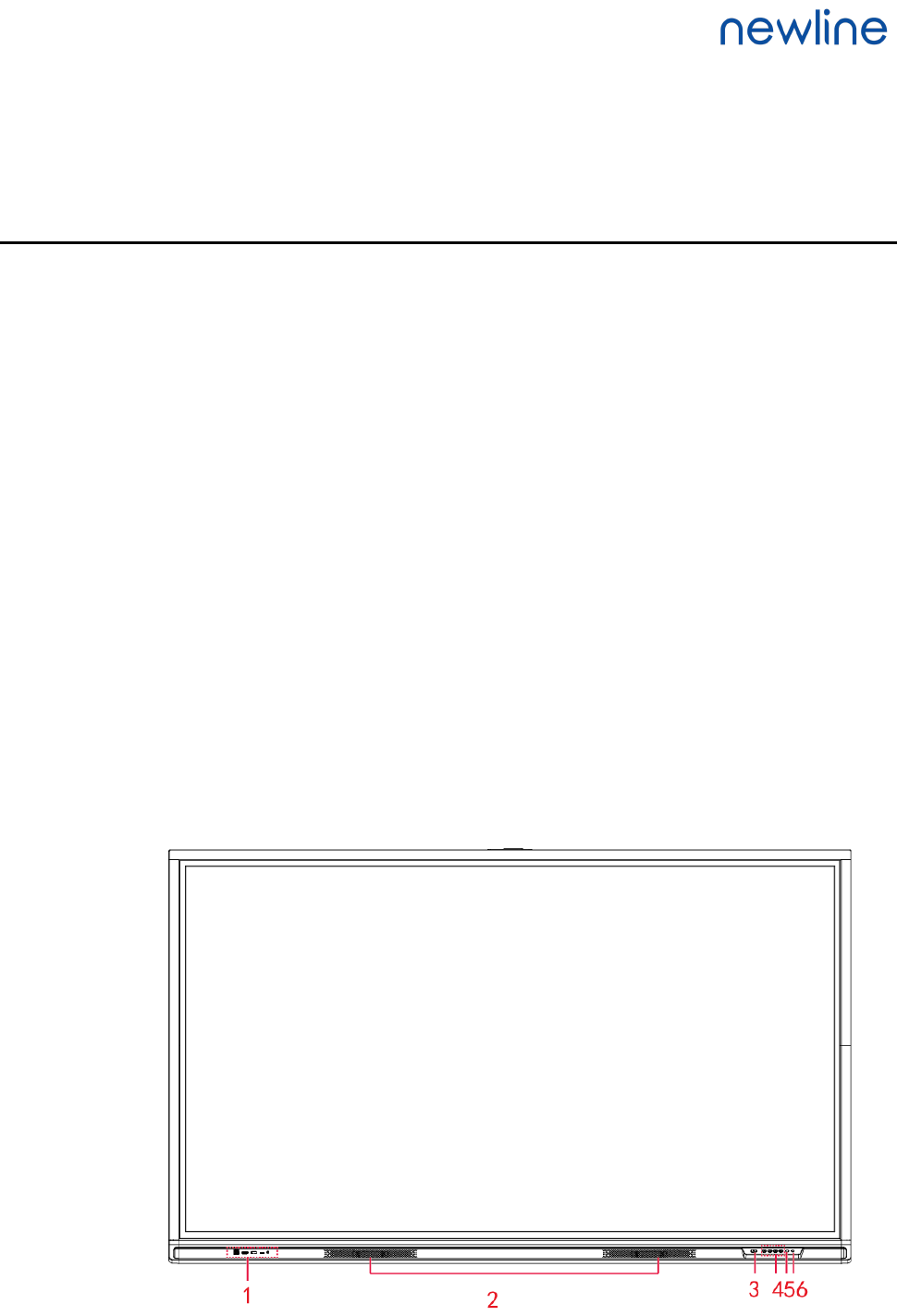
8
1 Overview
1.1 Introduction
Take collaboration to the next level with the Q series interactive display.
Increase productivity and collaboration across the board with a display that uses advanced
touch technology.
Each product can be customized to fit your needs. The non-proprietary nature lets you use the
software you prefer, take notes on local files, wirelessly cast to the screen from smaller
devices, run your favorite apps, and view multimedia files, all while making your experience
better than before.
The newline's 4K Ultra High-Definition LED screen also provides a fluid writing experience.
Annotate over anything on the screen, whether in the embedded whiteboard or while using
any other device. IntelliTouch automatically identifies pen thickness and color, saving you
time.
1.2 Parts
Front View
65" / 75" / 86" /98"
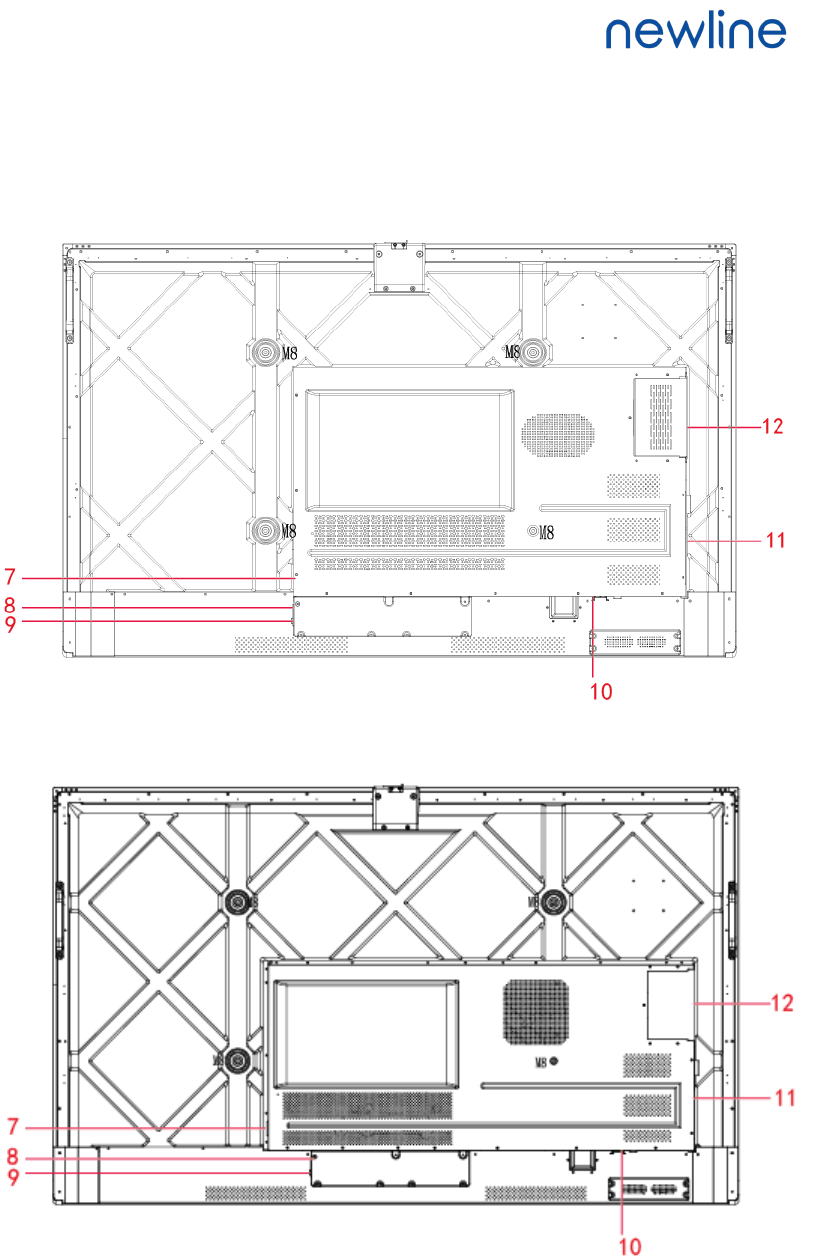
9
Rear View
65"
75
"
86" /98"
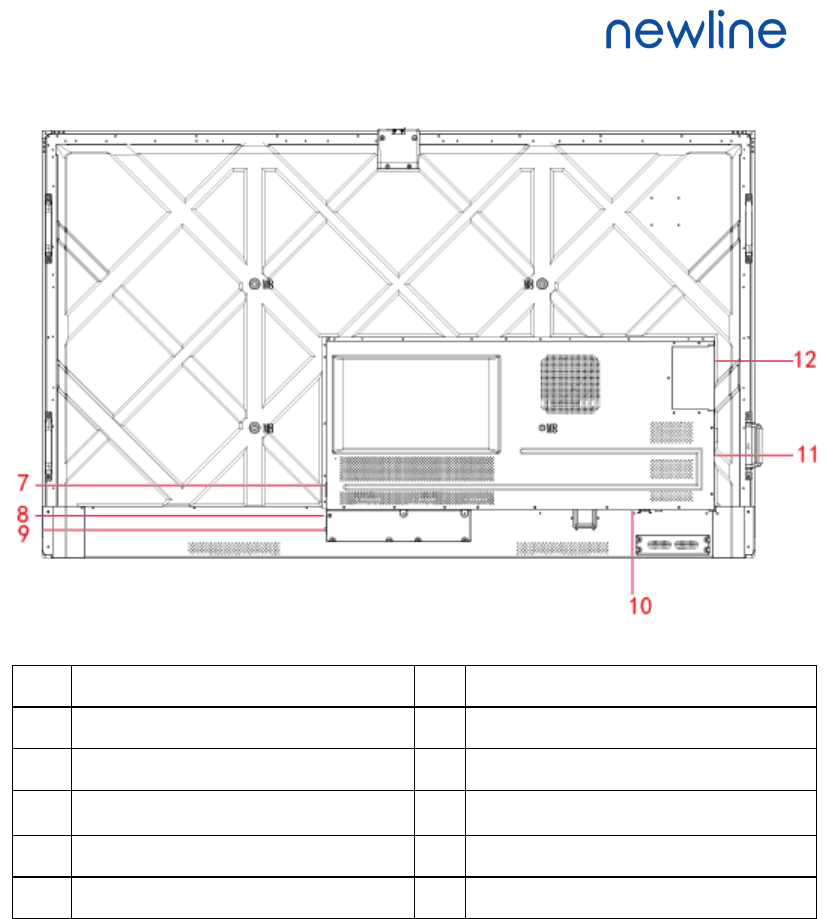
10
1 Front Ports 7 Power Output Plug
2 Speakers 8 Power Supply Plug
3 Power On/Off 9 Power Switch
4 Front Buttons 10 Rear Ports 1
5 Remote Control Receiver 11 Rear Ports 2
6 Light Sensor 12 OPS Port
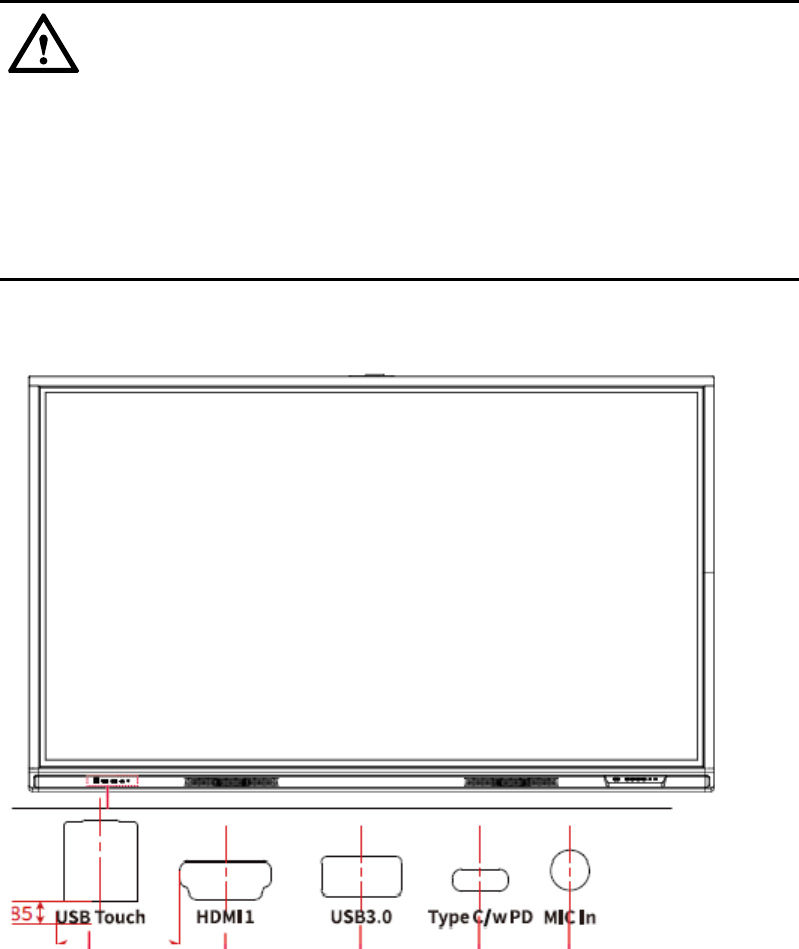
1.3 Ports
Front USB ports and rear USB 3.0/USB 2.0 ports switch connections based on signal
sources. If the current signal source is reading the data from an external product
connecting to the port, please switch the signal source after the data reading is complete.
Otherwise, the data or product may be damaged.
For USB use, USB 2.0 provides up to 500Ma whereas USB 3.0 provides up to 900Ma of
power. Please make sure the USB flash drive is formatted to FAT32 before inserting into
the panel.
Front Ports
CAUTION
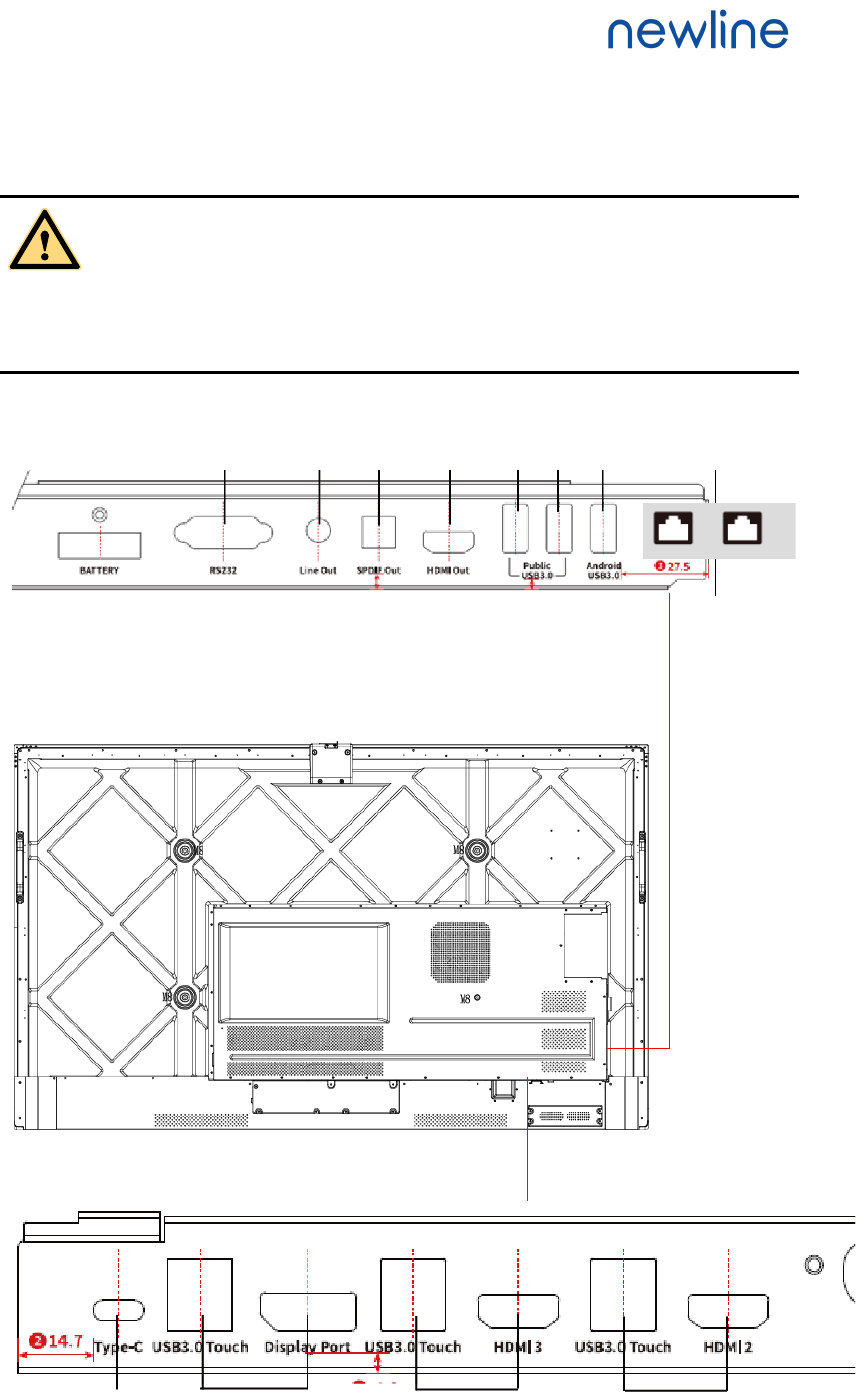
12
Rear Ports
The rear power output port is supplies 5 V/2 A (maximum) power. Please contact Newline to
purchase the power AC adapter for powering external devices. Please do not connect any
products which require power than listed. Doing so may cause injury or damage to the panel.
65
" / 75" / 86"
WARNING
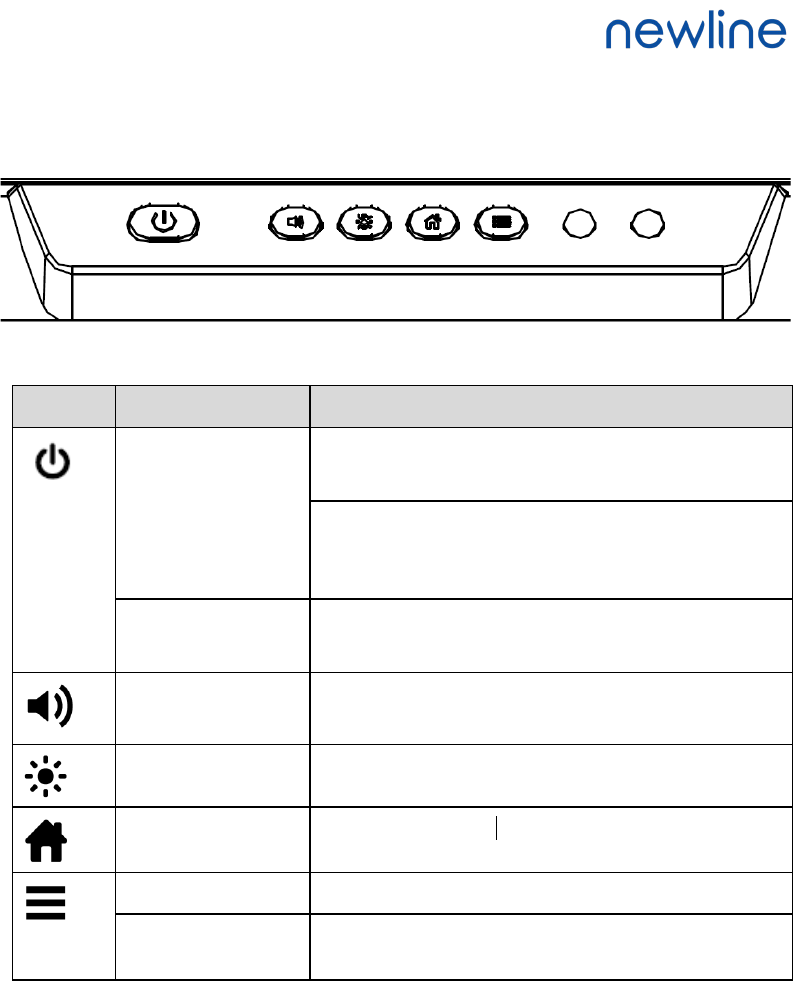
13
1.4 Front Buttons
Buttons Operations Functions
Short press Power on
Solid white color : Display is on and working
Sleep mode
The red and white lights flicker alternately: Display
enter Sleep mode.
Long press for more
than 2 seconds
Power off
Solid red color : Display is in shut down mode
Short press Adjust the Volume
Short press Adjust the Brightness
Short press Go to the home page
Short press Open the Quick Setting menu
Long press for 5
seconds
Activate/Exit the power button Lock Function
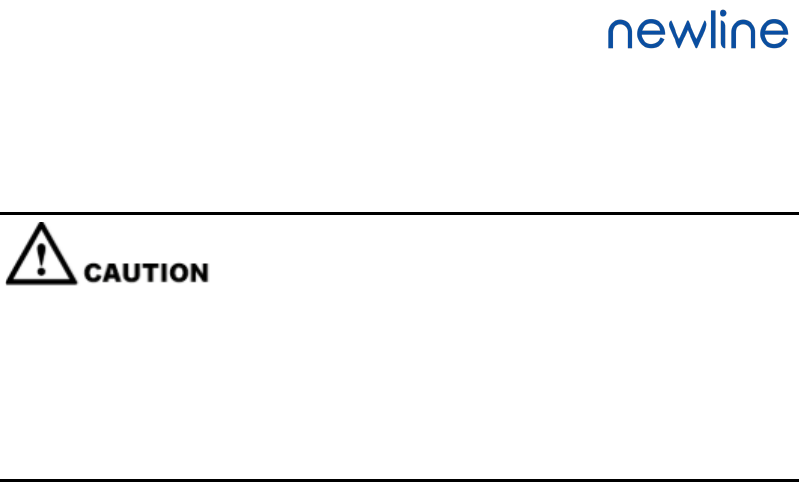
14
1.5 Remote Control
Carefully read the following instructions before using the remote control to avoid possible
faults:
Do not drop or damage the remote control.
Do not spill water or other liquids on the remote control.
Do not place the remote control on a wet object.
Do not place the remote control directly under sunlight or near a heat source.
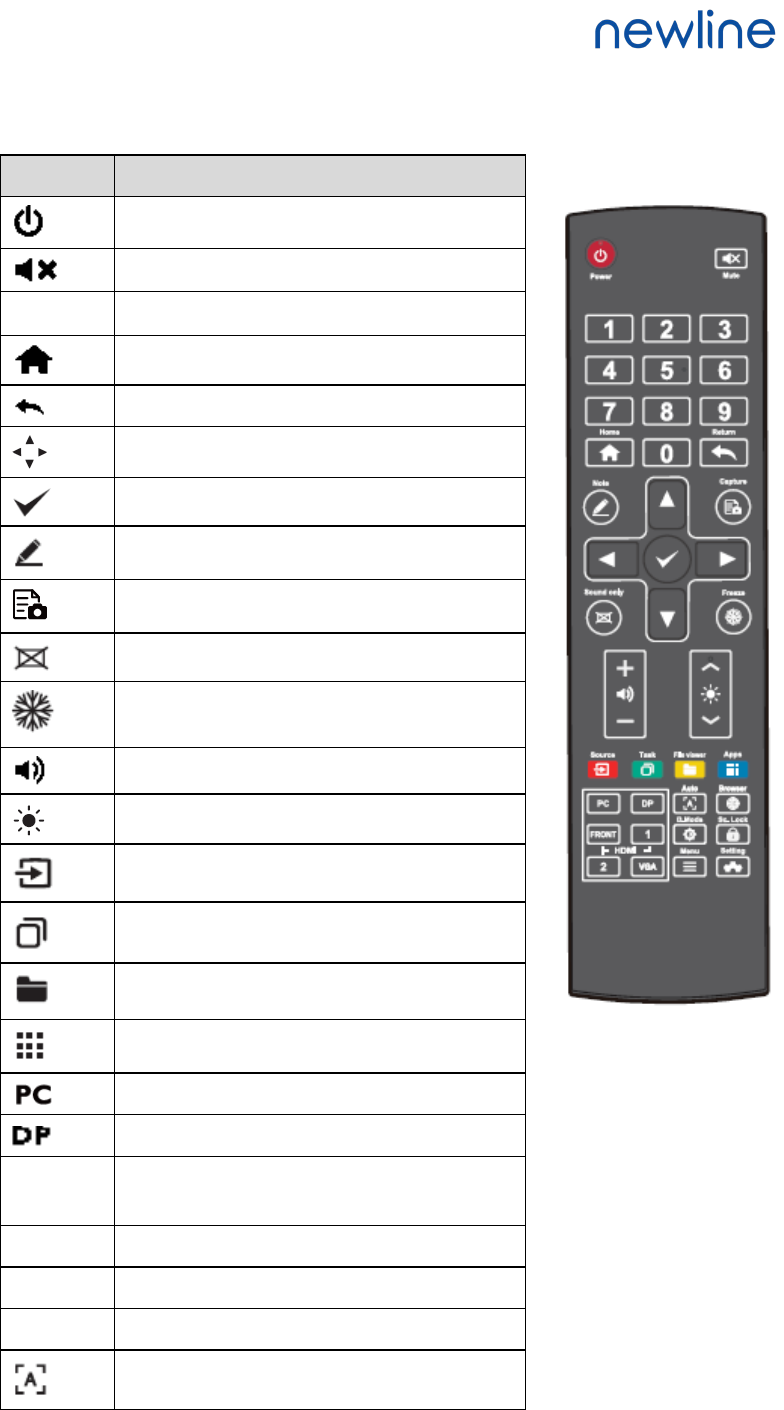
15
Buttons Operations
Power On/Off
Mute/Unmute Audio
0-9
Number Keypad
Go to the Home Page
Return to Previous/Exit
Directional Pad
Confirm/OK
Start Whiteboard Mode
Take a Screenshot
Enable Sound Only Mode
Press once to freeze the current screen. Press
again to exit freeze function
Adjust the Volume
Adjust the Brightness
Enter the Source Selection Page
App switcher
Open the File Viewer
View all Pre-installed Applications
Switch Source to OPS
Switch Source to Display Port
HDMI
FRONT
Switch Source to HDMI Front
HDMI 1 Switch Source to HDMI 1
HDMI 2 Switch Source to HDMI 2
VGA Reserved button
Reserved button
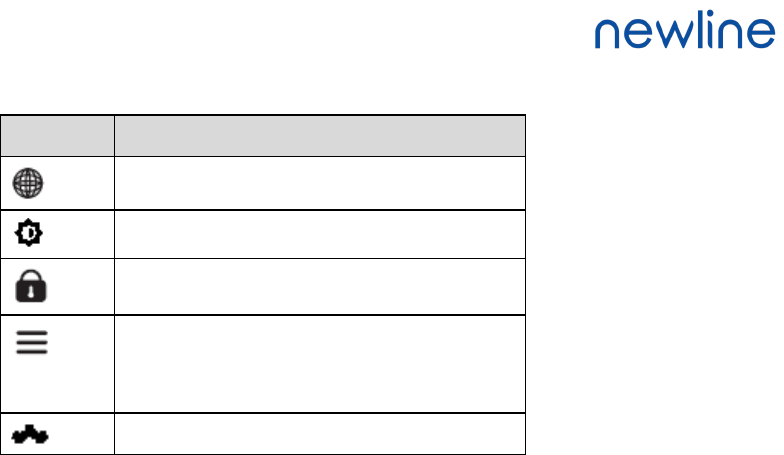
16
Buttons Operations
Open the Browser Application
Toggle Display Backlight Mode
Enter the Screen Lock interface
Open the Quick Setting menu on the
embedded os system.
Open the menu in Windows system.
Open the System Settings
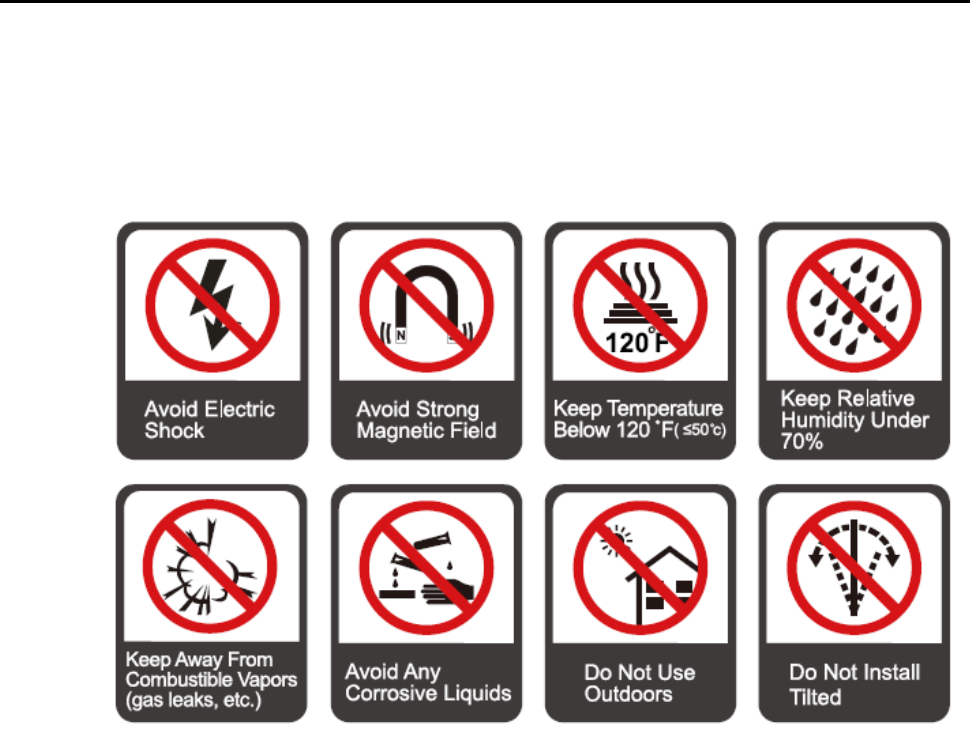
17
2 Installation Guide
2.1 Safety Precautions
Installation Environment
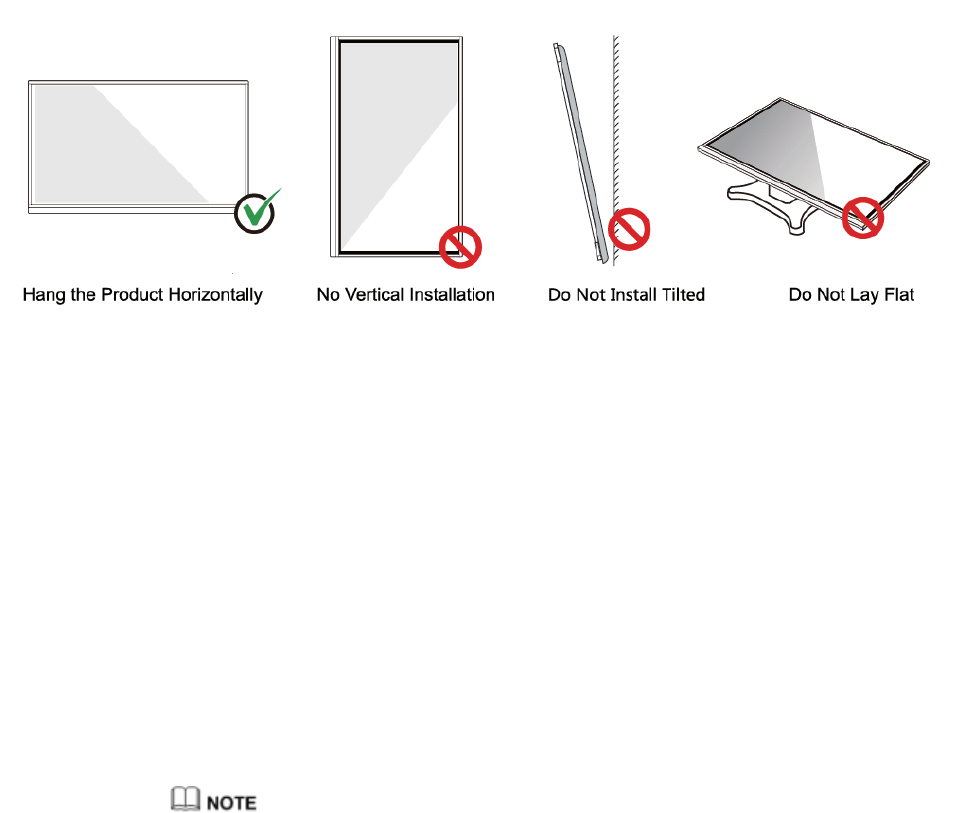
18
Installation Direction
2.2 Installation Precautions
Weight Loading
Weight of the product: 143lb/ 65kg (86INCH), 115lb/52 kg (75INCH), 86lb/ 39kg (65INCH)
When using a mobile stand, ensure that the weight of the product is less than the loading
capacity of the mobile stand.
When using the wall-mount bracket, ensure that the wall can support the weight of the
product. We recommend that the wall surface be reinforced and have a loading capacity
4 times of the weight of the product. Consult a professional installer for wall-mount
installation.
The company does not undertake relevant legal responsibility for any problems caused by improper
operation if the third party mobile stand, or wall-mount bracket is beyond the scope of the product.
Do not install the product where it might be hit by an opening or closing door.
Vertical installation
When installing the panel, try to keep the panel vertical. An excessive tilt angle may cause
damage to the glass or other internal components.
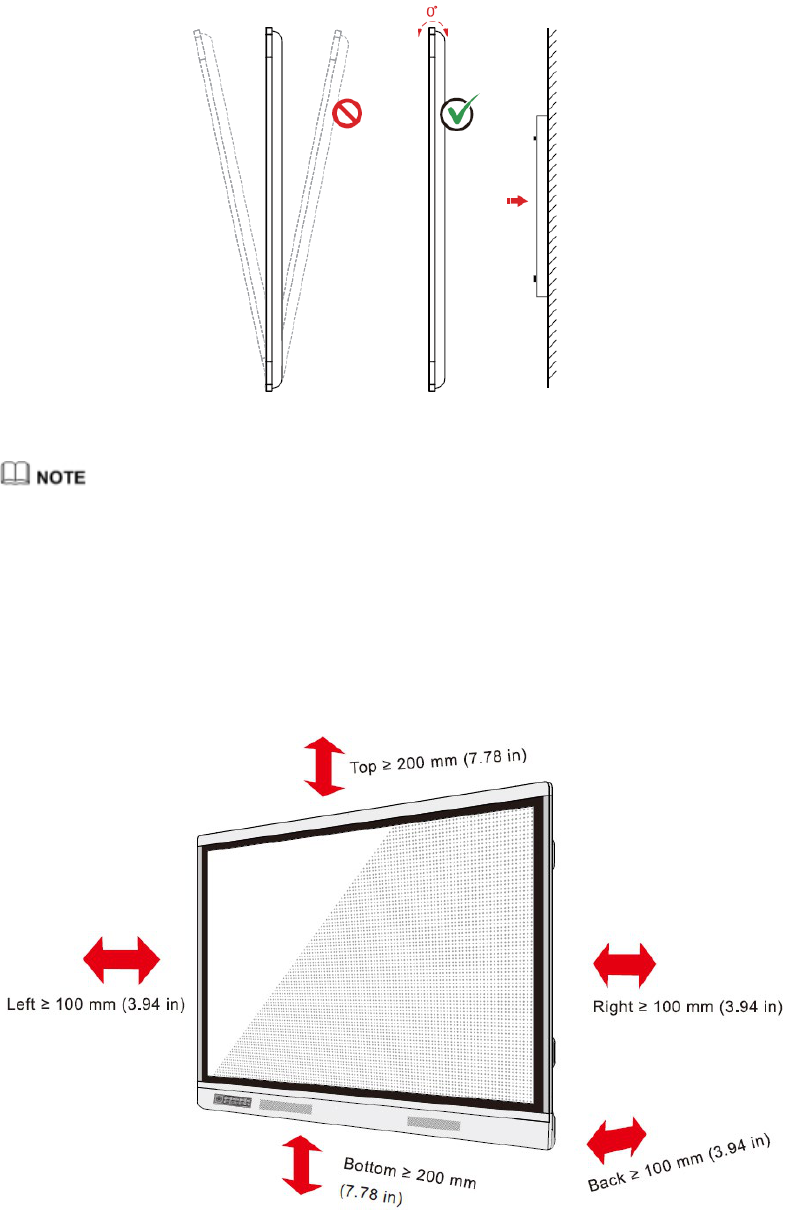
19
For any problem, please contact our support desk. Our company is not responsible for any damage or
losses incurred by users if the users fails to follow the instructions.
Ventilation
Ensure adequate ventilation and/or an air conditioned environment. We recommend keeping
certain distances from the side of the product to the wall or panels. Ventilation requirements are
shown in following figure:
(
Tips
:
Updated to Q Series front panel figure
)
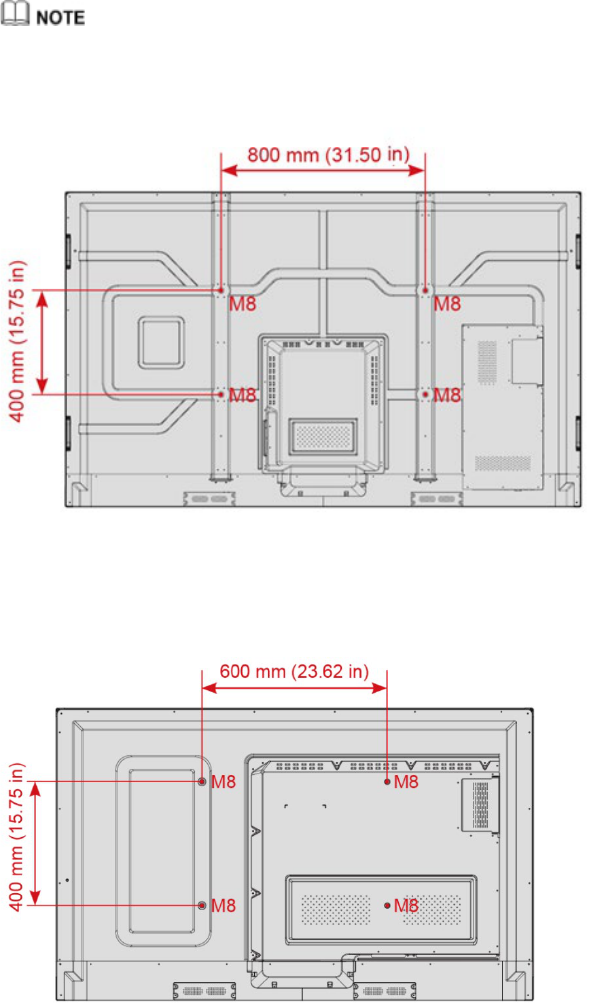
20
2.3 Installation
The dimensions of the four bracket mounting holes on the back panel are VESA MIS-F
compliant (86 inch or 75 inch: 800 x 400 mm/31.50 x 15.75 in; 65 inch: 600 x 400 mm/23.62
x 15.75 in). Use metric M8 screws with a length of 10 mm to 15 mm (0.40 to 0.59 in) to
secure the touchscreen to the mounting system. Dimensions of the mounting holes on the
back panel are shown on the following figure:
Consult a professional installer to install the display product.
75"/86"/98":
(
Tips
:
Updated to Q Series Back panel figure
)
65 inch:
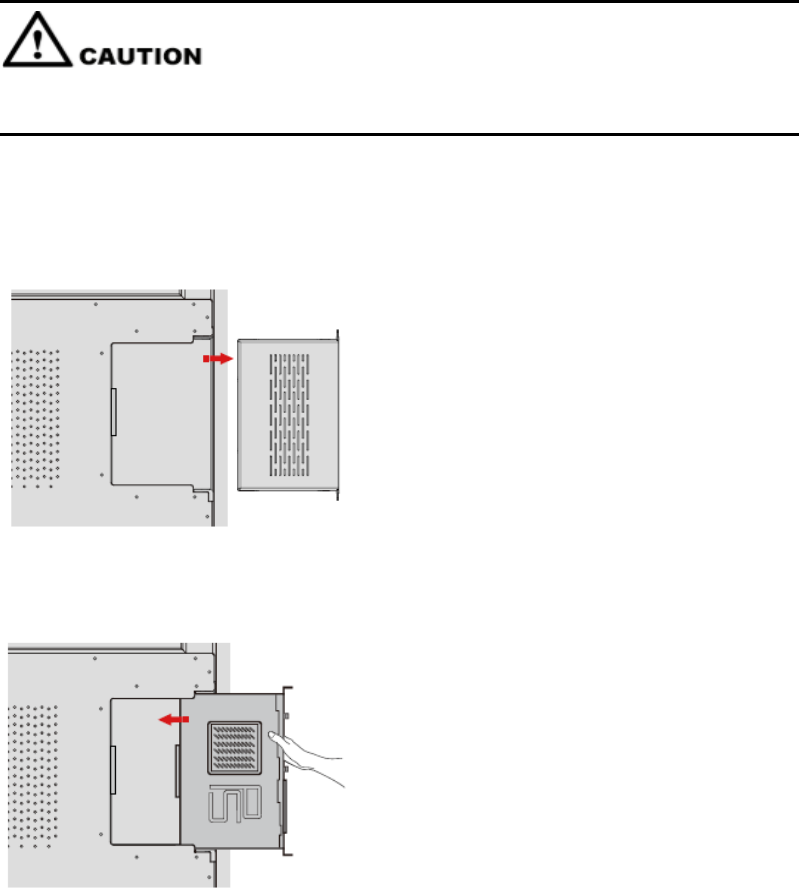
21
(
Tips
:
Updated to Q Series Back panel figure
)
2.4 Installing the OPS (Optional)
The OPS does not support hot plugging. Therefore, you must insert or remove the OPS when
the display is powered off. Otherwise, the display or OPS may be damaged.
You will need to purchase the OPS separately. Perform the following steps to install the OPS:
Step 1 Unscrew the M3 screws by hand to remove the OPS protective cover.
Step 2 Slide the OPS into the OPS port on the rear of the panel until firmly seated.
Step 3 Secure the OPS to the display by using the M3 screws.
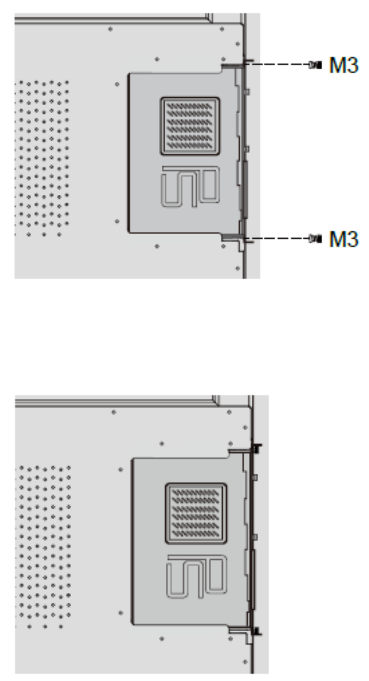
22
Step 4 Ensure the installation is correct before powering on the panel.
2.5 Installing Newline Assistant
2.5.1 Introduction
The Newline Assistant agent is a tool used as a bridge between the embedded operating
system and the OPS. It helps add Windows software shortcut to the Home Page, as well as to
protect USB data when switching between sources.
Therefore we strongly recommend users install the Newline Assistant after installing the OPS.
2.5.2 Installation
Step 1 Install select the OPS correctly (See "Installing the OPS (Optional) ").
Step 2 On the Home Page, tap OPS and the source will switch to the Windows operating system.
Step 3 Visit our website at www.newline-interactive.com and choose Products > Q series >
download to download the Newline Assistant installation package.
Step 4 Install the
Newline Assistant as instructed.

23
3 Getting Started
3.1 Power On
Step 1 Ensure the power cable is fully seated into the panel and wall outlet before powering on the
panel. Please confirm your wall outlet supports a power range of 100V to 240V with
frequency at 50 Hz/60 Hz ± 5% and is fully grounded.
The power outlet should be installed near the equipment and should be easily accessible.
Step 2 Flip the power switch located on the side of the product to “I”.
65" / 75" / 86" / 98":
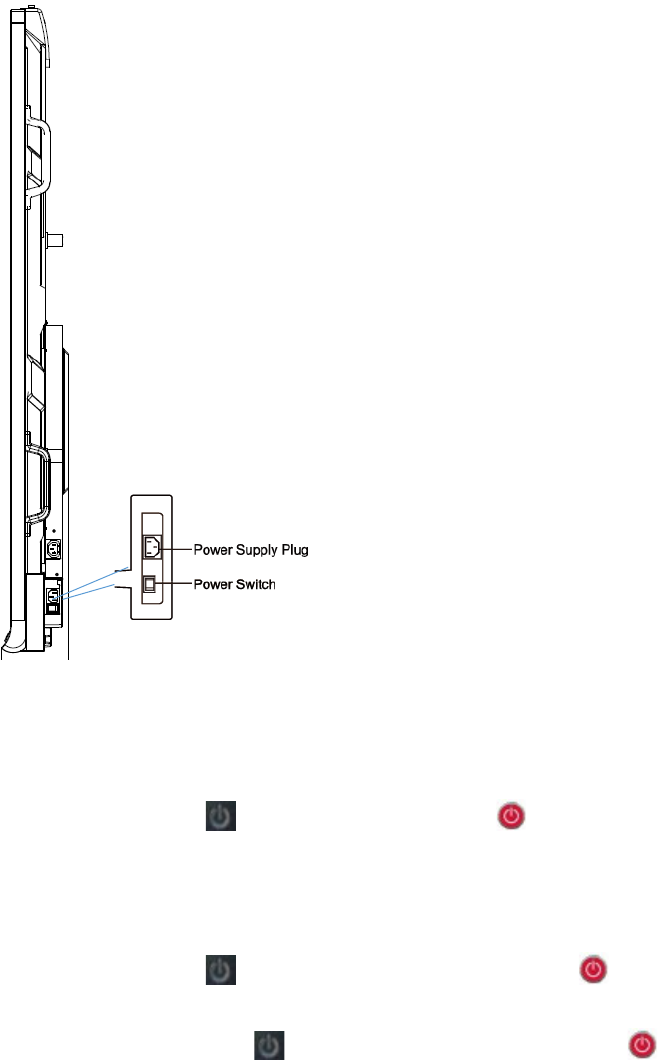
24
(tips
:
Image to be updated)
Step 3 Press the power button on the front control panel or on the remote control.
3.2 Power Off
Step 1 Press the power button on the front panel or the power button on the remote
control to enter sleep mode.
Step 2 Long press the power button on the front panel or the power button on the remote
control, The Warning dialog box will be displayed as shown in the following figure.
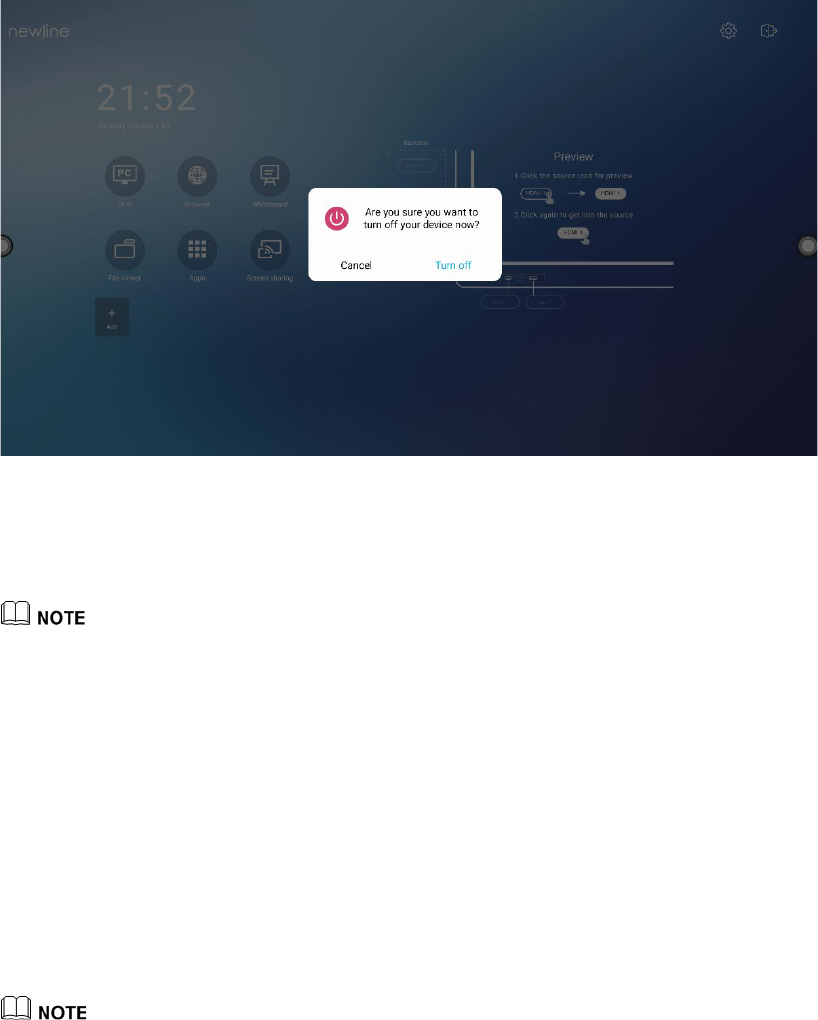
25
Step 3 In the Warning dialog box, tap Cancel to return to working mode. Tap Turn off to turn off
the panel, and the power indicator will turn to red.
Step 4 If you want to completely turn off the product, turn off the rocker switch behind the panel
(next to the power socket) and unplug the power cord.
If an OPS is installed, the OPS and the screen will simultaneously powered off when the power is
shutoff.
Please properly shut down the panel before disconnecting the power source or it may cause damage.
Accidental power failure may cause damage to the panel.
Do not repeatedly turn the power on & off in a short period of time as it may cause malfunction.
3.3 Calibration
If the cursor position has a big deviation from the actual touch point, calibration is used to
eliminate the deviation. Calibration is required in the following scenarios:
The OPS is used.
A computer is connected through the HDMI or Display Port interface.
Interface operation on the embedded operating system does not need positioning. External products with
Microsoft Windows 7 or later versions will require positioning.
If the positioning is not correct, perform the following operations to calibrate again. The
following takes Windows 10 as an example:
Step 1 Ensure that the HDMI or DP interface and external products are connected properly.
Step 2 Select the corresponding Windows signal from the signal source menu. The Windows page
will be displayed.
Step 3 Select Tablet PC Settings on the Control Panel page.
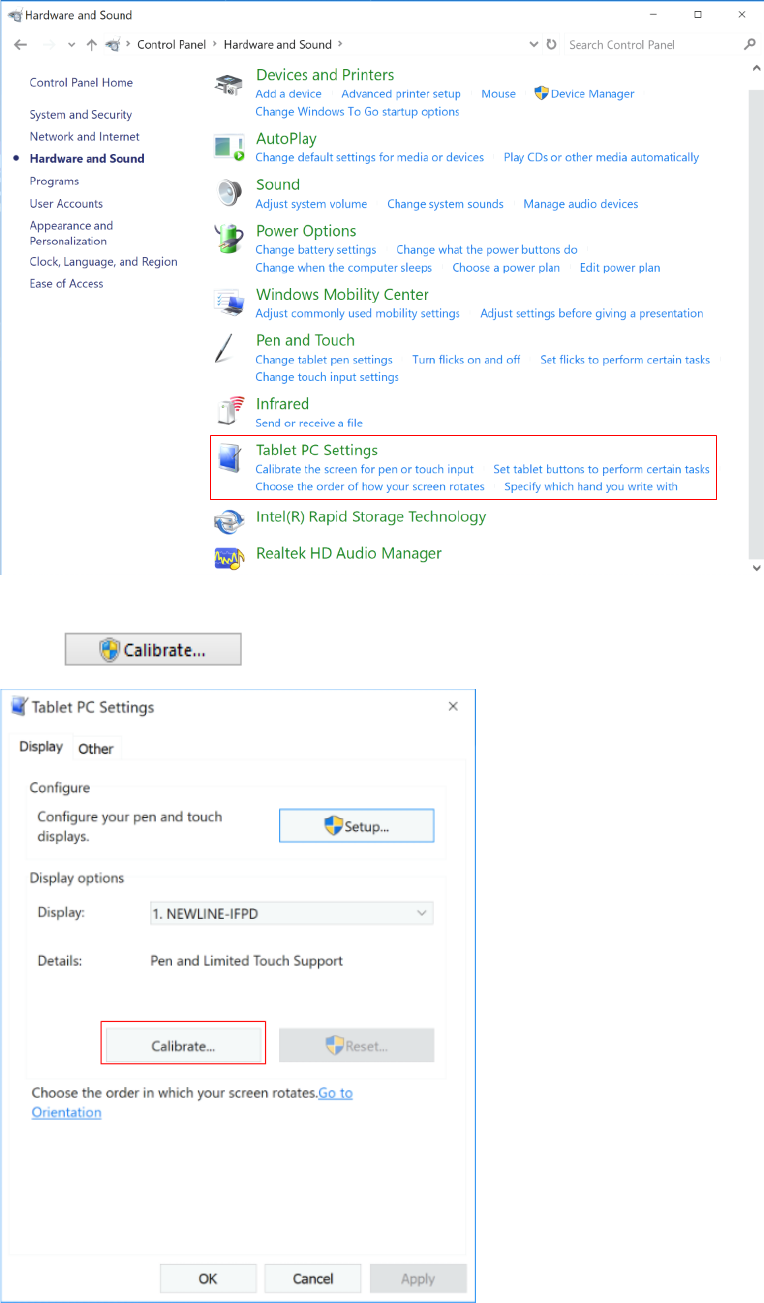
26
Step 4 Select in the Tablet PC Settings window.
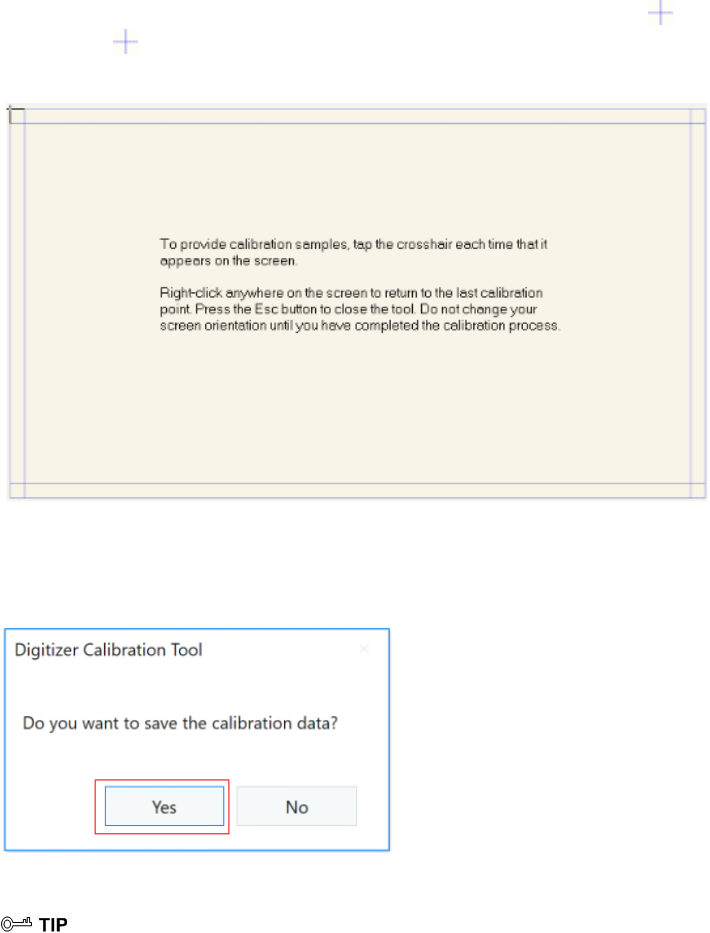
27
Step 5 Select Touch input from the option and start calibration.
Step 6 Use your finger or a pencil to click and hold the center of the flickering cross . Do not
release until moves to the next positioning point. Complete the calibration process as
instructed.
Step 7 After the calibration is complete, the Digitizer Calibration Tool dialog box will be
displayed. Click Yes to save calibration data.
To ensure writing accuracy, use the pencil or stylus included with the product for proper positioning.
Positioning errors may cause failure of touch functions of the display. In that case, please perform
calibration again.
Step 8 The Tablet PC Settings dialog box will be displayed again. Tap OK. The calibration will be
complete.
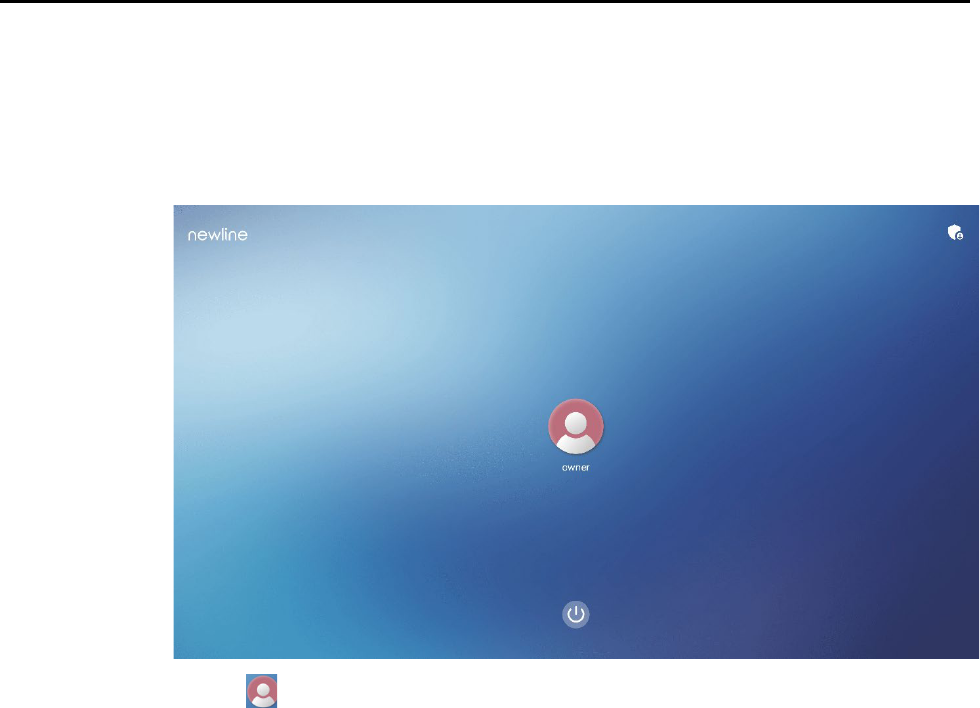
28
4 Operating the Touch Screen
4.1 Profile Logon
When the panel is powered on, the panel will show all the registered accounts as shown in the
following figure:
Tap the icon to enter the 6 digits passkey and log into the system homepage. Default
passkey is 2364606633.
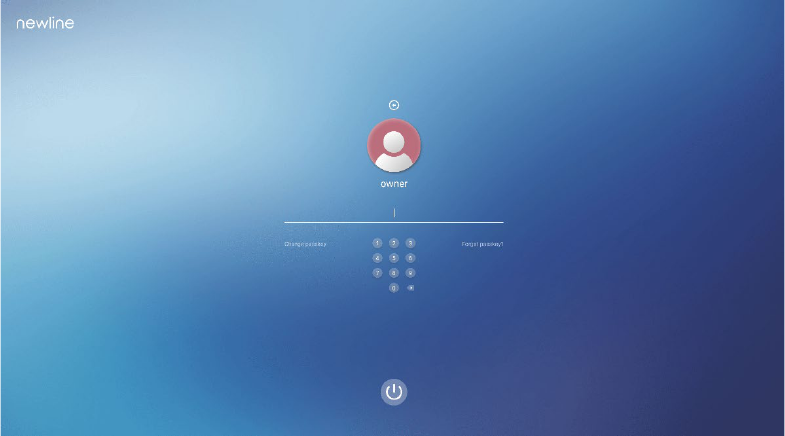
29
Notes:
The passkey is only limited to 6 digits, English letters are not allowed. After passkey enabled,
every time you boot up the screen, system will request the passkey.
If you forgot your passkey, please contact your administrator to reset your passkey.
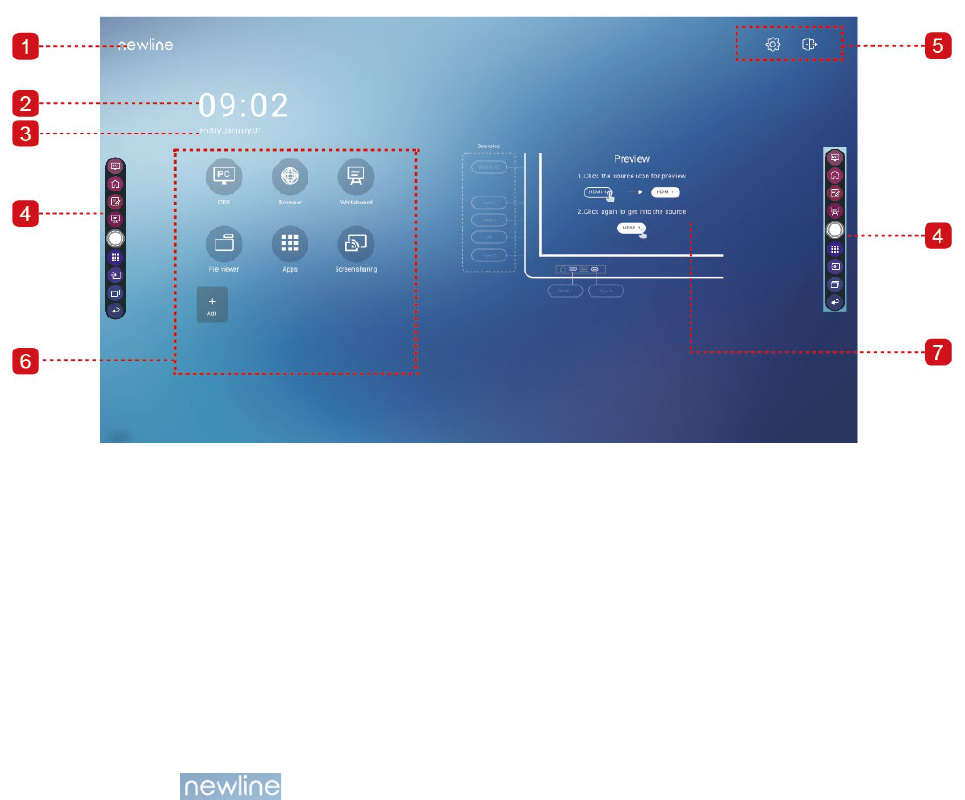
30
4.2 Home
Once logged into the system, the user will be taken to the Home page as shown in the
following figure:
1: Logo (Shortcut to Settings) 2: Clock (Shortcut to Clock)
3: Date and Week(Shortcut to Calendar) 4: Side Toolbar 5: Status Bar and Settings
6: Main Icon 7: Preview Window for Signal Source
Shortcut for Logo & Wallpaper Settings
Tap the icon on the Home Page to enter the Display & Theme page, you can
tap Set logo to set the logo image, as shown in the following figure:
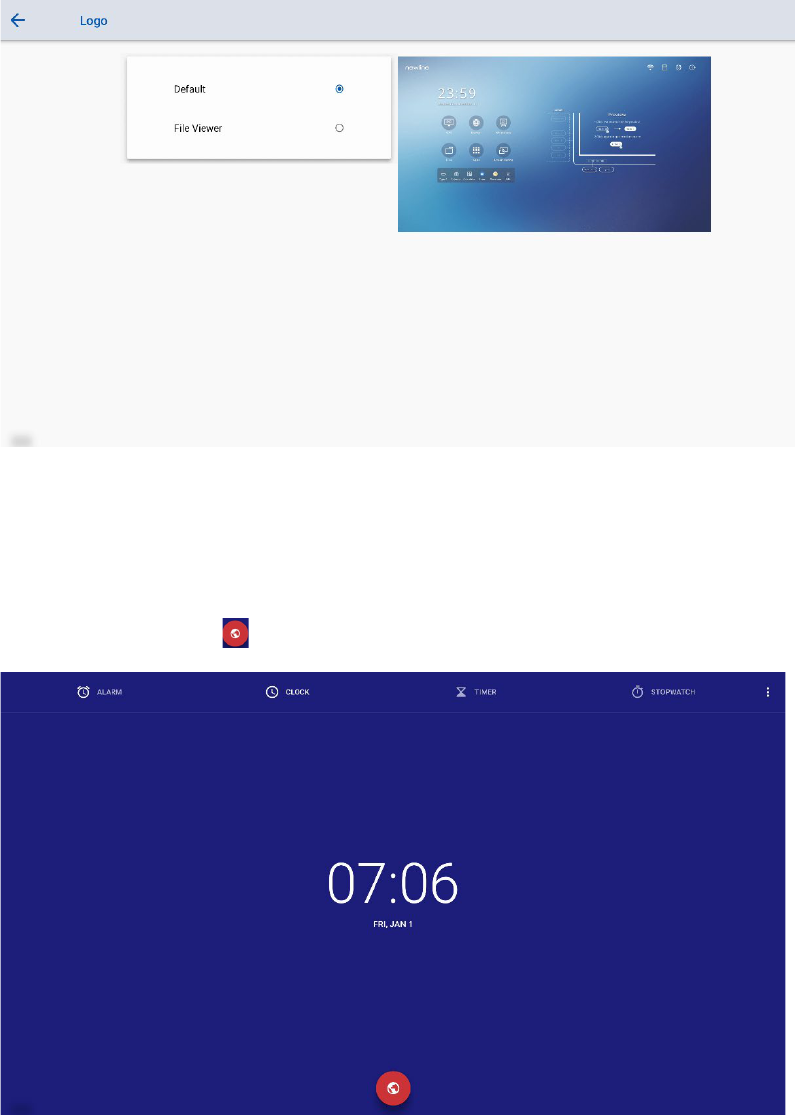
31
Shortcut for Clock
Tap the time icon on the Home page to start the clock application. Using the icons on the top,
you may switch from clock mode to alarm mode, or to timer and stopwatch mode. In the
clock mode, you may tap to add other time zones as shown in the following figure:
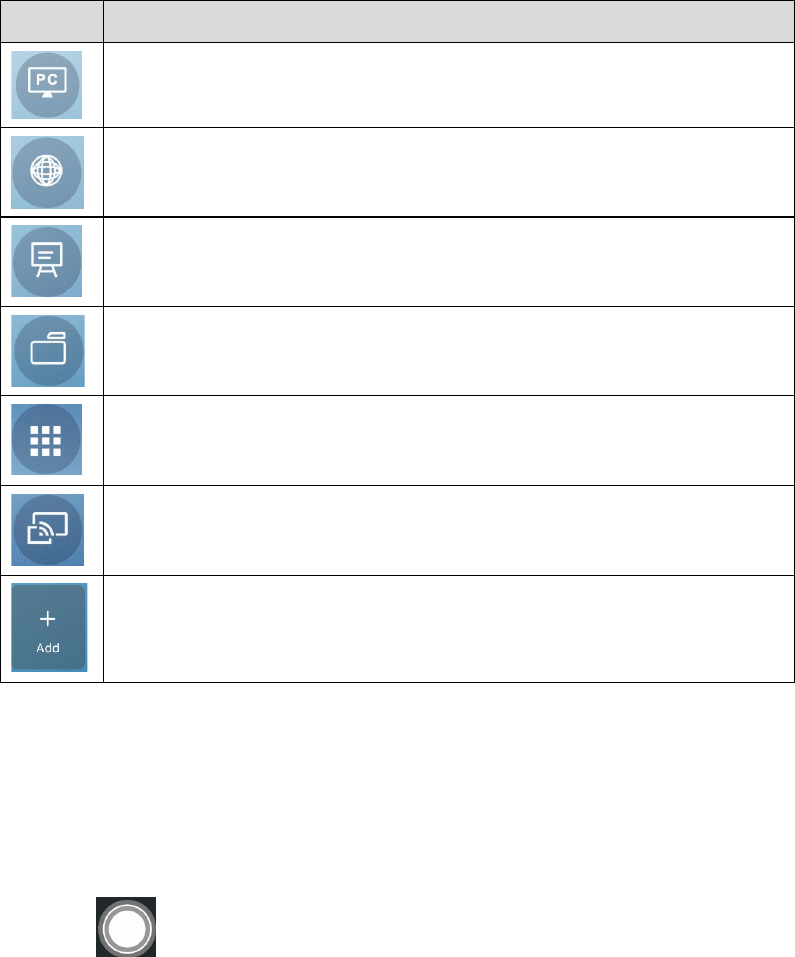
32
Main Icon
Icon Functions
Tap to switch to the OPS source.
Tap to open the browser.
Tap to open the whiteboard function.
Tap to open the File viewer application to explore internal and external files on
the panel.
Tap to enter the app interface. Apps displays all pre-installed applications,
including Calculator, Calendar, Clock, Settings, Newline Cast, File Viewer,
Office Suite, and…etc. Tap the icon of an application to run the application.
Tap “Screen Sharing” icon to enable the wireless screen sharing function.
Note: By default, the “Screen sharing” icon is displayed after startup.
Tap Add icon to customize the main icon. You can add up to 5 shortcuts to
your Apps. (See more detail in “Add Shortcuts to Home Page”)
Side Toolbar
By default, the toolbars display the OPS source, Home, Annotation Mode, Whiteboard, Apps,
Sources, App Switcher and Return icons on both sides of the screen. You can hide one or both
toolbars in the Settings, slide them up and down, minimize or maximize them by simply
tapping the " " icon.
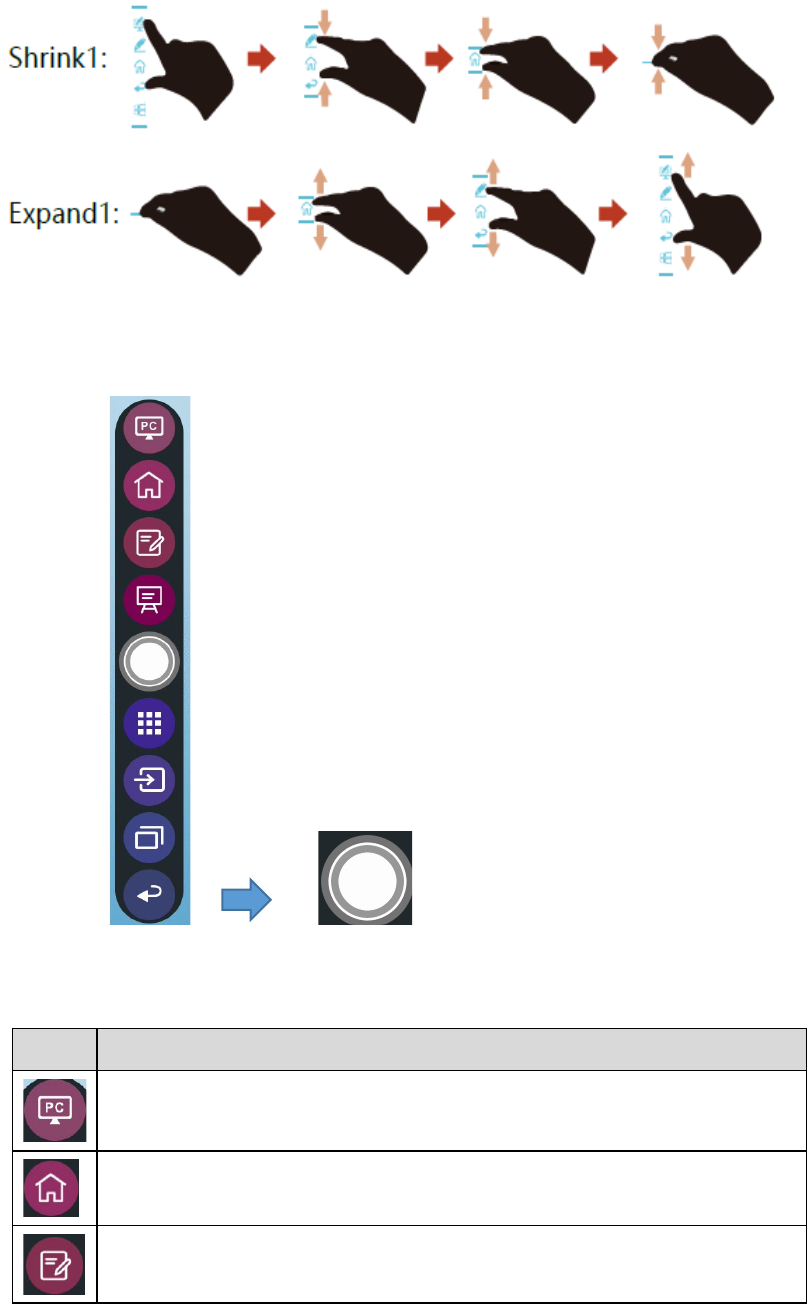
33
(Tips: Image to be updated)
Shrink 2
(Tips: Image to be updated)
The functions of the side toolbar are as follows:
Icon Functions
Switch to the OPS source.
Go to Home page.
Tap once to start annotation mode, tap again to stop annotation and take a
screenshot.
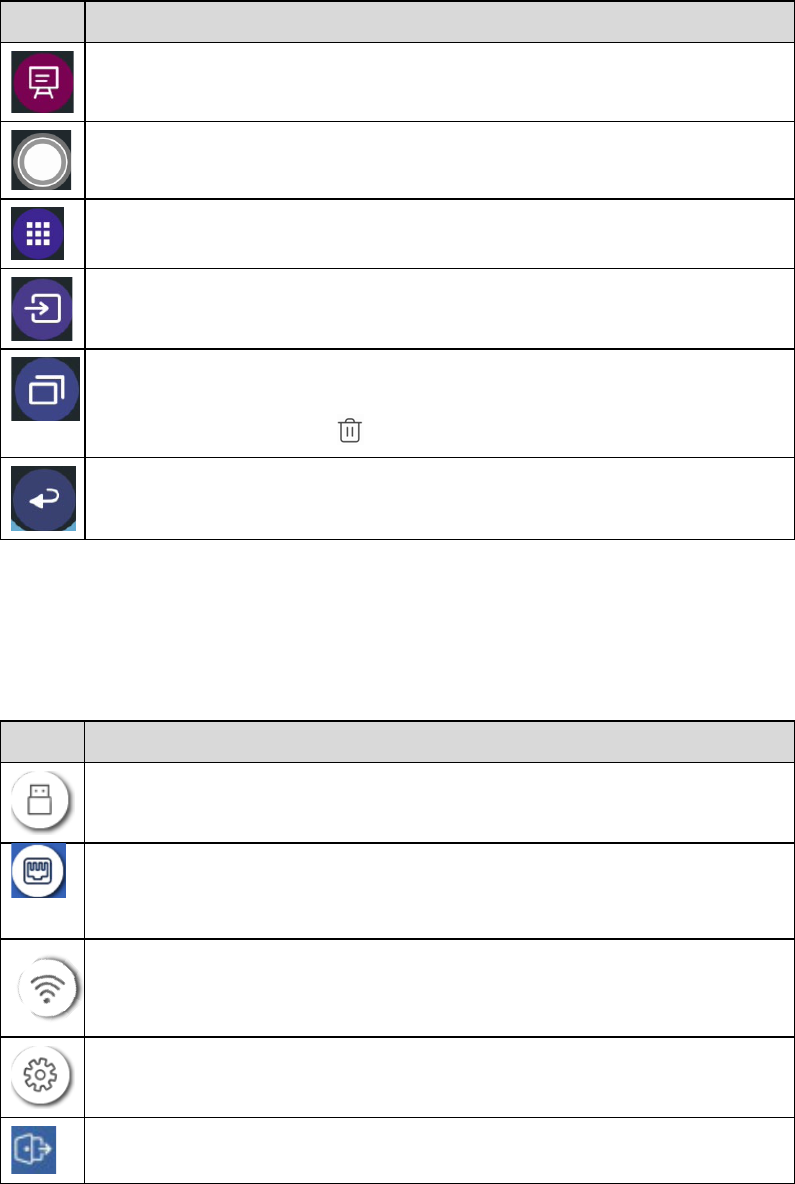
34
Icon Functions
Switch to whiteboard mode.
Minimize or maximize the toolbar.
Go to Apps folder.
Tap to view the external internal sources, including HDMI 1, HDMI 2,
HDMI 3, Front Type C, Type C and Display Port.
App switcher allows the user to manage currently running applications.
Swipe up or down to view currently running applications, swipe left or right to
close the application or tap “ ” icon to close all the applications.
Return to the previous menu or exit an app.
Status Bar and Settings
The upper right corner of the home page displays three working status icons (including USB
drive(s), Ethernet, and Wi-Fi), system setting shortcut and log out icon.
Icon Functions
If a USB drive is connected to the USB port, this icon will appear highlighted.
If the product is connected to Ethernet, the icon will appear.
If the product is connected to a wireless network, the icon will appear.
Tap to enter the system setting page.
Account log out and return to the lock screen.
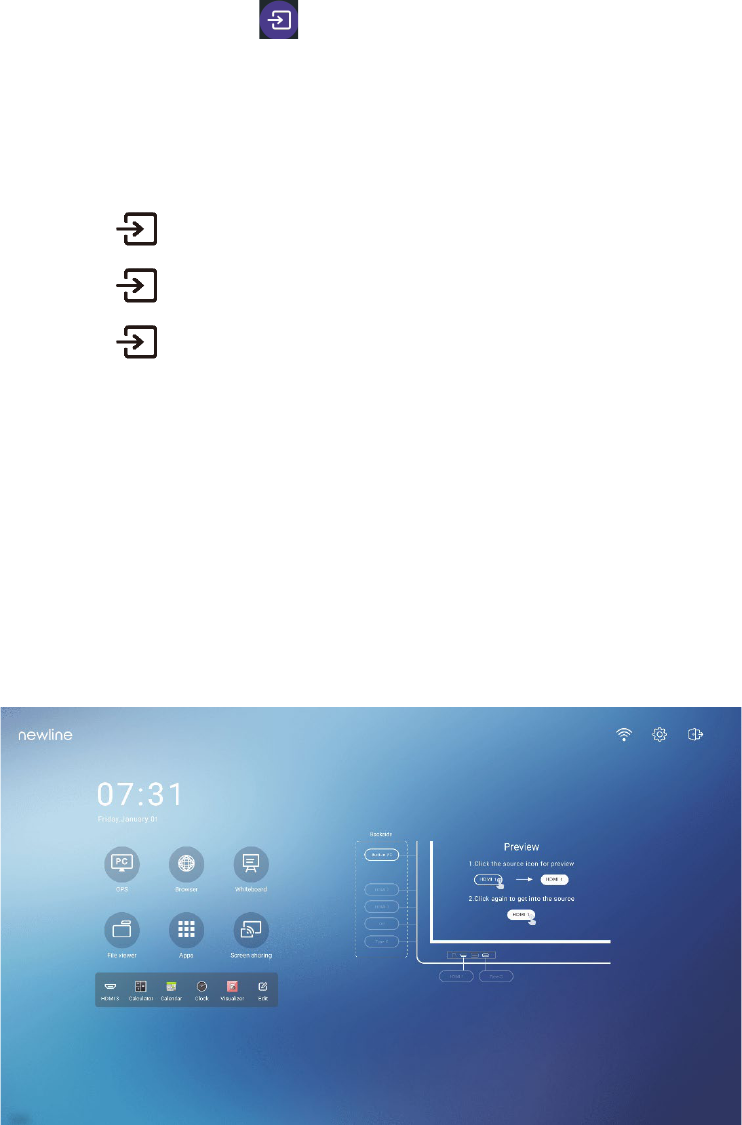
35
4.3 Sources
On the side toolbar page, tap to enter the signal source selection, including Front Type
C, Type C, HDMI 1, HDMI 2, HDMI 3 and Display port.
The icon without signal source connected is gray, and the icon with signal source connected is
white. After you choose white icon, the content of the signal source can be displayed in the
preview window for real-time preview.
You can enter sources interface by the following methods:
Tap the icon on the side toolbar;
Tap the icon on the quick settings;
Tap the icon on the remote control.
4.4 Preview window
On the Home page, signal source preview window including build-in PC, Front Type C, Type
C, HDMI 1, HDMI 2, HDMI 3 and Display port.
An icon without an active signal source connected will be gray, an icon with an active signal
sources connected will be white, and the icon of the signal source currently being previewed
will be blue. After you choose a white icon, the content of the signal source can be displayed
in the window for a real-time preview, the icon color will change from white to blue, and the
name of the preview window for the signal source will change to match with the signal source
being previewed.
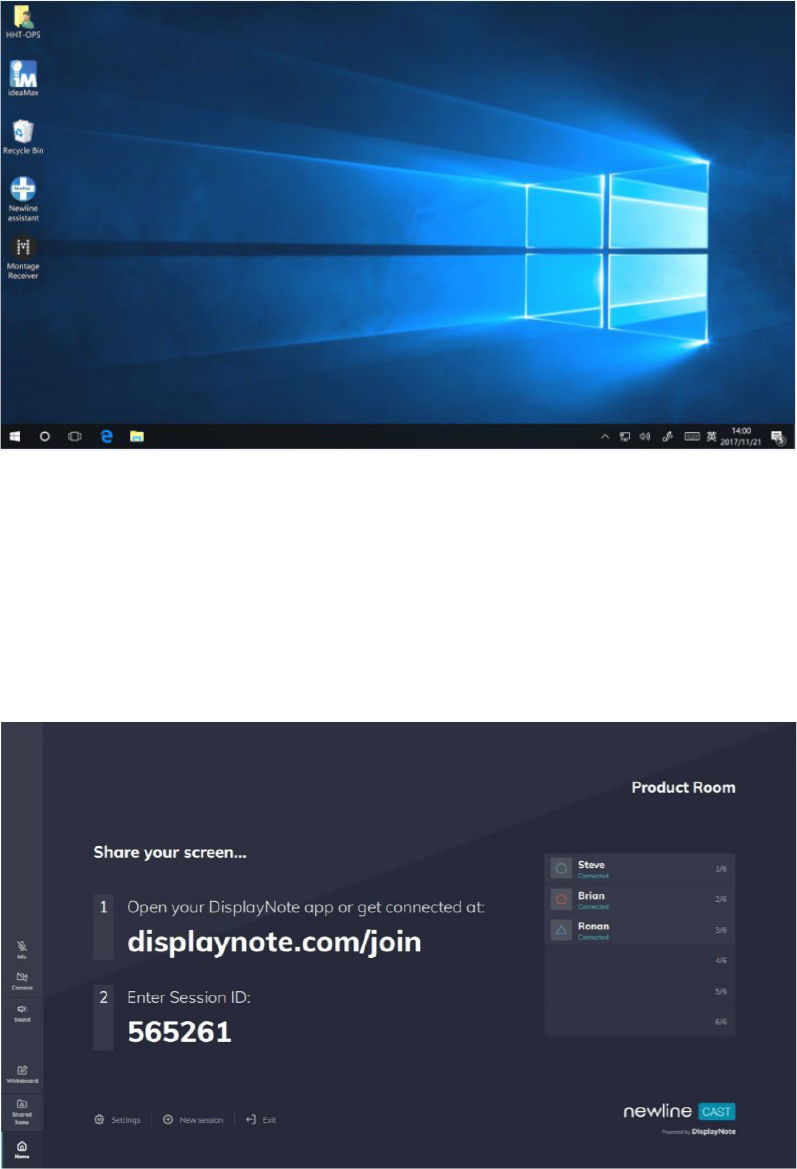
36
4.5 OPS
On the Home Page, tap OPS to enter the OPS source, as shown in the following figure. If the
display is not equipped with an OPS, "No Signal" is displayed.
4.6 Screen Sharing
Multiple devices can be cast wirelessly to the display through several casting modes (Airplay,
Google Cast…). To cast: tap Screen Sharing on the Home Page to enter Newline Cast. On
screen directions will appear for you to follow in order to wirelessly cast to the display, as
shown in the following figure:
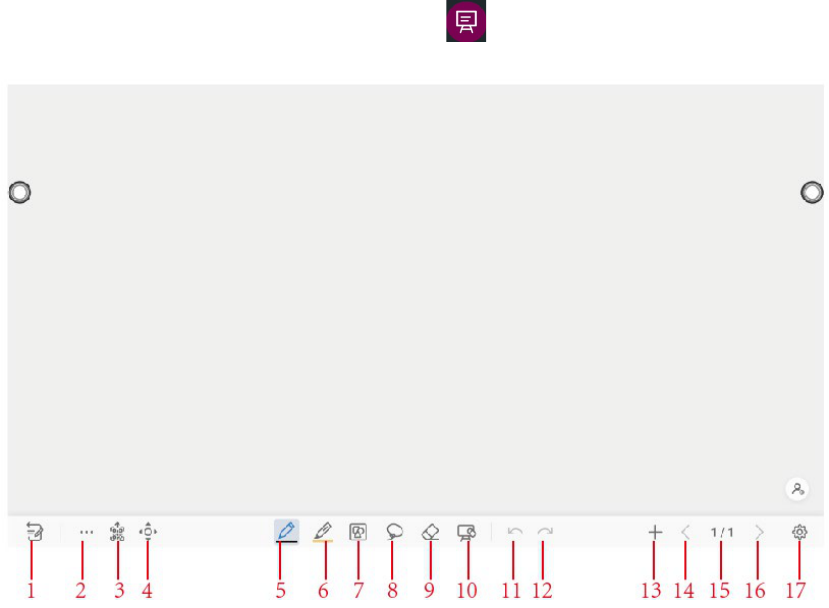
37
4.7 Whiteboard
The whiteboard function is designed to present conference writing to attendees in a quick and
easy manner. The whiteboard has the following functions:
Discussion and screen annotation
On the whiteboard page, you can select pen type, width, and color to write or annotate on
the screen. You can also erase selected content or clear all content on the screen.
Page navigation
Preview or delete pages.
Palm rejection
When Palm rejection is turned on, fingers and pen can write and draw, but palm and fist
would not be recognized.
Palm eraser
When Palm eraser is turned on, fingers and pens can also be recognized, and palm and
fist will be recognized as large eraser.
Note:
The Palm reject and Palm eraser function are available for whiteboard and annotation
application, both of which are mutually exclusive and cannot be turned off
simultaneously. You can turn on/off Palm reject and Palm eraser function on the quick
setting menu.
Whiteboard Mode
Tap whiteboard icon on the Home page or tap on either side toolbar to enter the
embedded whiteboard mode, as shown in the following figure:
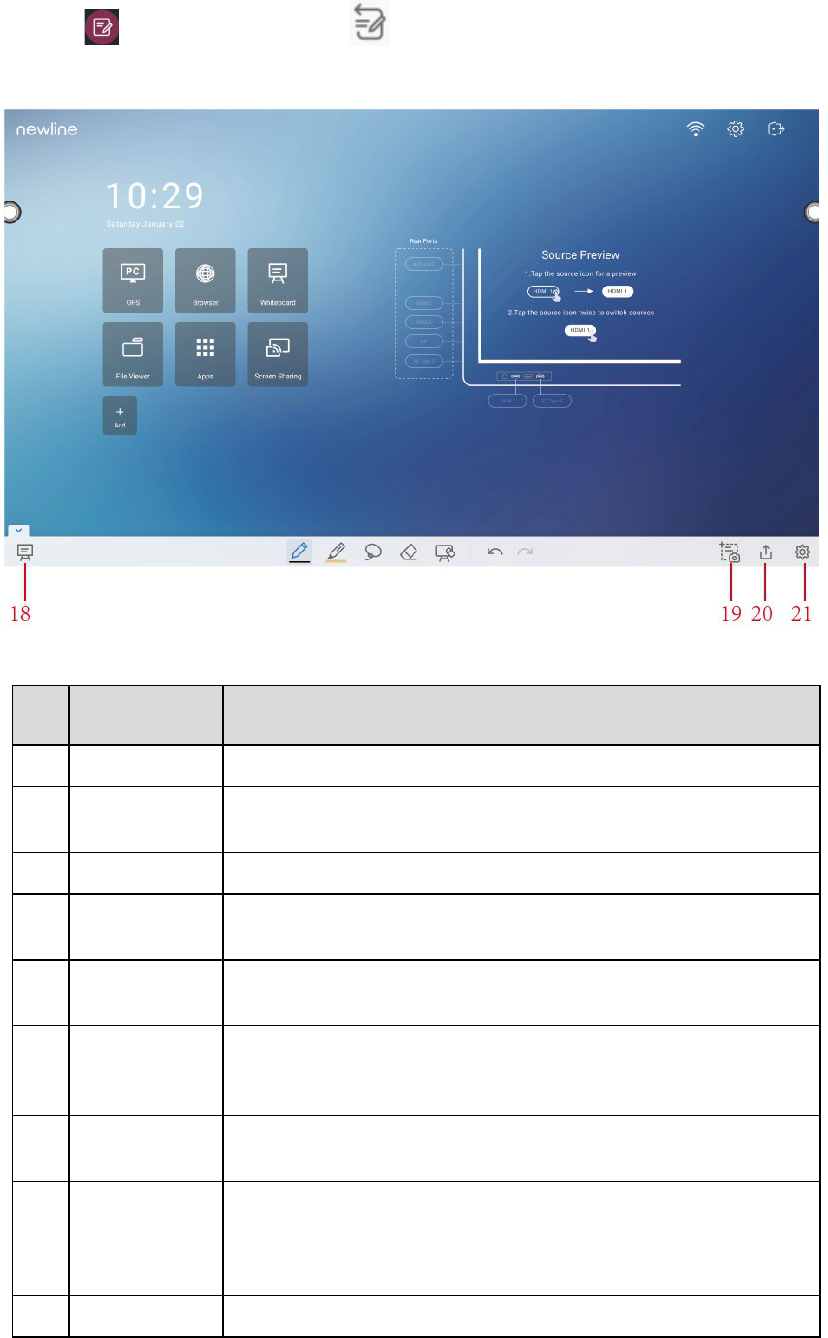
38
Tap on the side toolbar or tap in discussion mode to enter annotation mode.
In annotation mode, a transparent layer lays over the screen, letting you write over
whatever is on the screen until you exit annotation mode.
SN Icon Name Icon Function
1 Mode Switch Tap to switch to annotation mode.
2
More
Tap to enter options interface. Users can insert image, Text, Sticky
note, Search Image or Search Web etc.
3 QR Code Tap to export the whiteboard data into QR Code.
4
Move Canvas
Tap to enter move canvas function, press and move your finger in
the page to move canvas and content on it
5 Pen Tap to use the pen function, and the icon turns into blue. Tap and
hold the icon for two seconds to set the size and color.
6 Highlighter Tap to use the highlighter function, and the icon will turn blue. Tap
and hold the icon for two seconds to set the highlighter size or
color.
7 Insert Auto
shape
Tap to enter the auto shape selection interface. Users can insert the
shapes and set the shapes color.
8 Select
Tap to select and edit the whiteboard content.
When the object is selected, users can move, zoom in/out, copy, cut,
rotate, lock, change layer or delete object.
9 Eraser Tap to select the eraser function and the icon will turn blue. Tap and
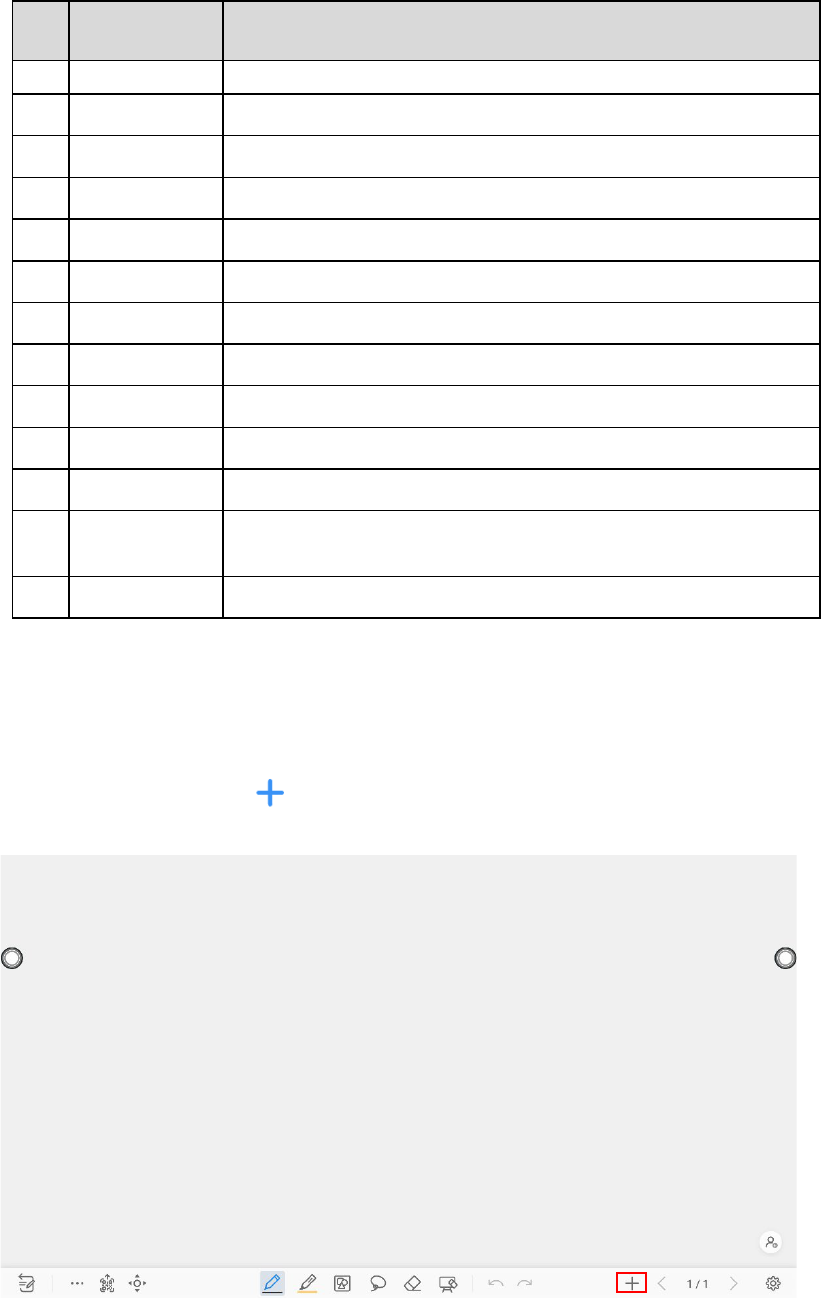
39
SN Icon Name Icon Function
hold the icon for two seconds to set the way of eraser.
10 Clear Clear all data on this page.
11 Undo Back to the previous step.
12 Redo Tap to restore the action that was cancelled in the previous step.
13 New Page Tap to add a new page.
14 Previous Page Tap to back to the previous page.
15 Next Page Tap to go to the next page.
16 Navigation Tap to show the page thumbnails.
17 Settings Tap to enter the whiteboard setting interface.
18 Mode Switch Tap to switch to discussion mode.
19 Save Tap to enter saving screenshot interface.
20 Screenshot
Tap to take a screenshot, and save the data to file viewer > picture >
screenshot.
21 Settings Tap to enter the annotation setting interface.
4.7.1 Whiteboard Functions
New Page and Settings
Create a new page
In discussion mode, tap to create a new page. Up to 20 pages can be created. See
the following figure:
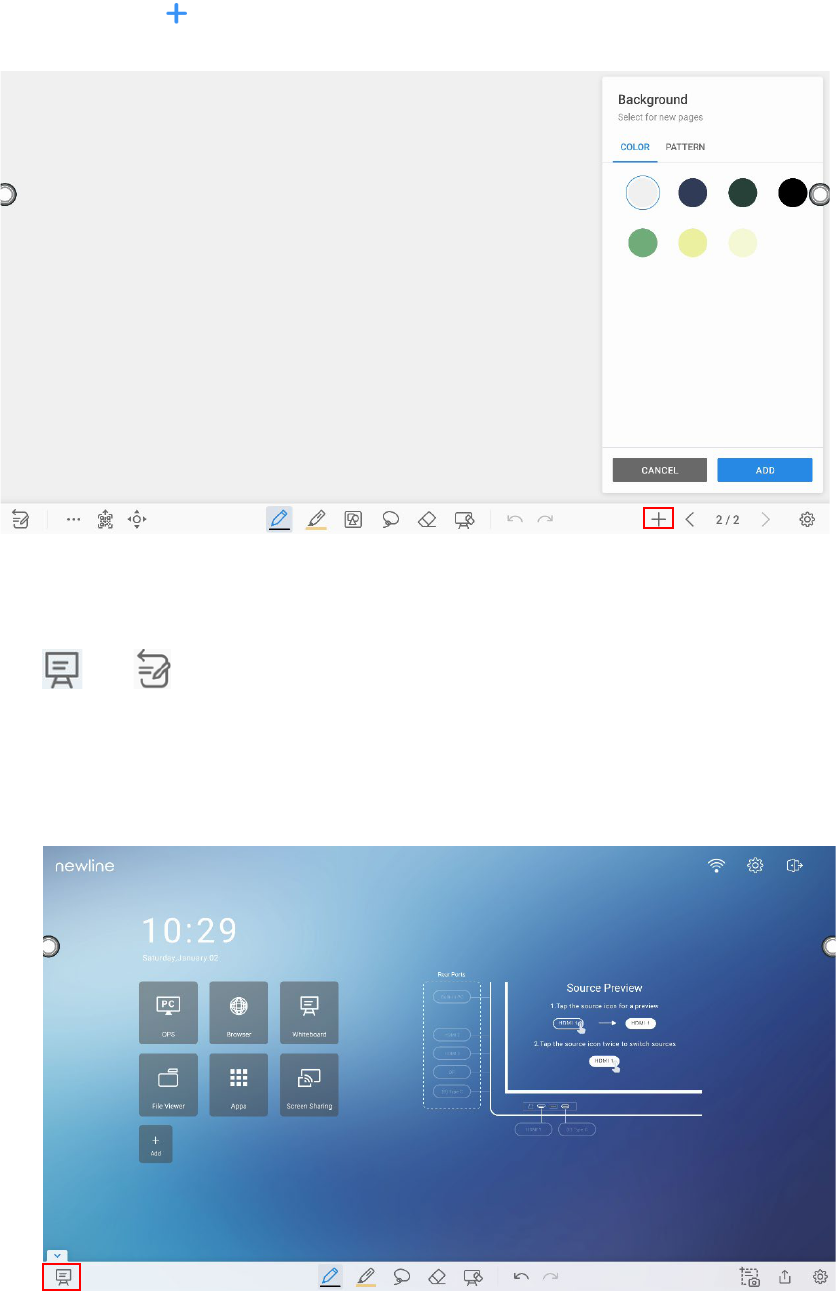
40
Page settings
Tap and hold for two seconds to set the color and the pattern of the new page, as
shown in the figure below.
Mode Switch
Tap and in the lower left corner of the discussion mode to switch between
whiteboard modes.
Annotation mode
The background is transparent and the real-time image of the current signal source will
be displayed. You can comment on presentation content such as Office documents and
pictures as shown in the following figure:
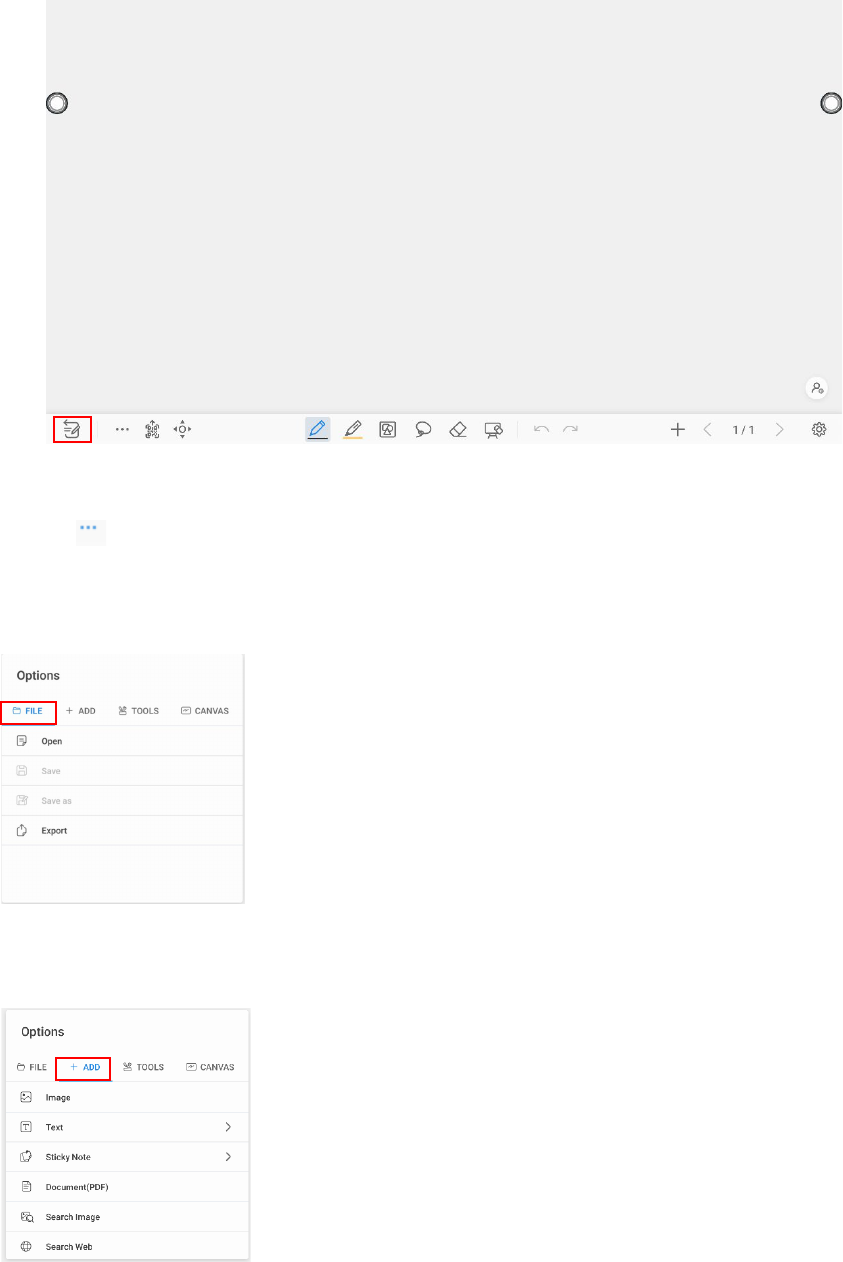
41
Discussion mode
The background is a single color, as shown in the following figure. You can write content
on the page as you wanted.
Options
Tap the icon to enter options interface. Users can manage files, add Text, Sticky note,
Search Image or Search Web etc.
On the FILE items, you can import data from file management, save whiteboard files and
export whiteboard page.
On the ADD items, you can import the pictures, Text, Sticky note, PDF document from
system files, USB, network. You also can import the Search Image or Search Web in the
internet.
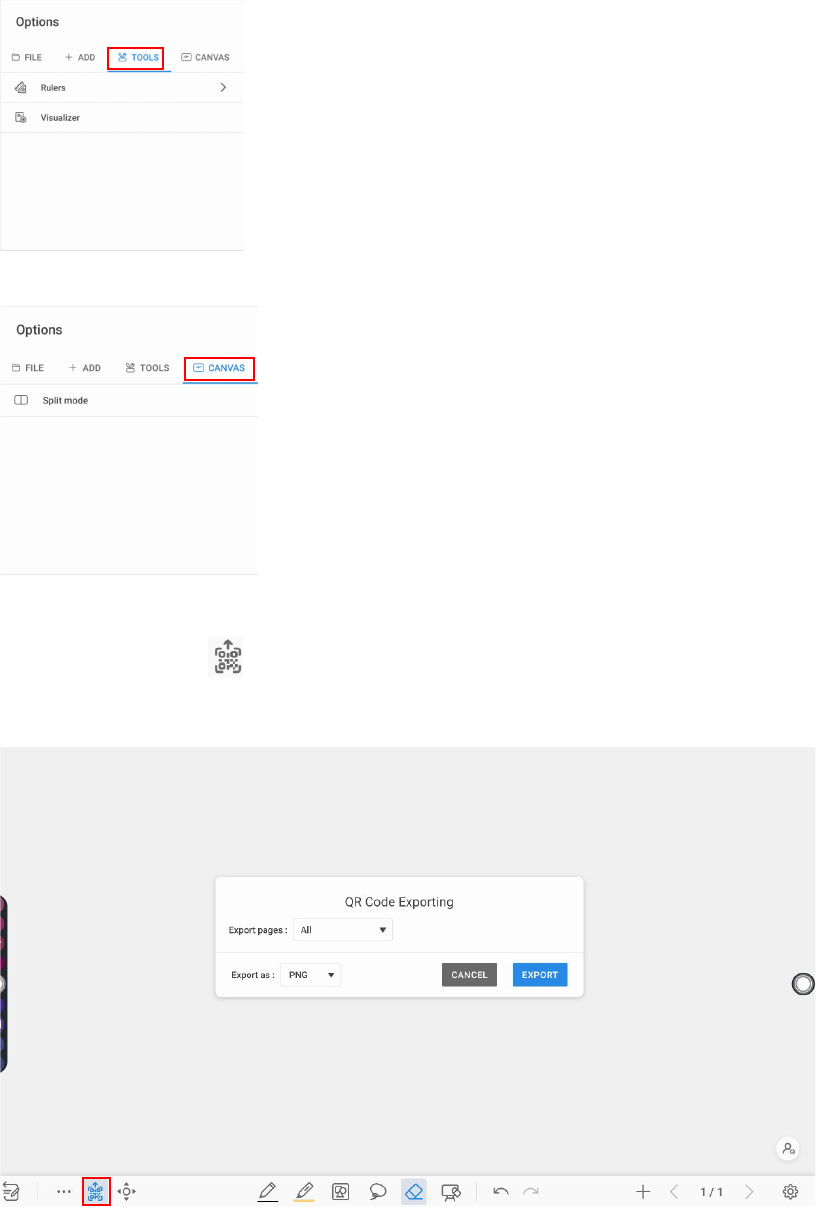
42
On the TOOLS items, you can use rulers to draw line or shape on the page, import the
visualizer image etc.
On the CANVAS items, you can choose split mode to set the split application.
QR code export
On the Whiteboard, tap to pop up QR code exporting windows. You can export the
whiteboard page into QR Code, before that, you can customize the number of export page,
change the export format at first.
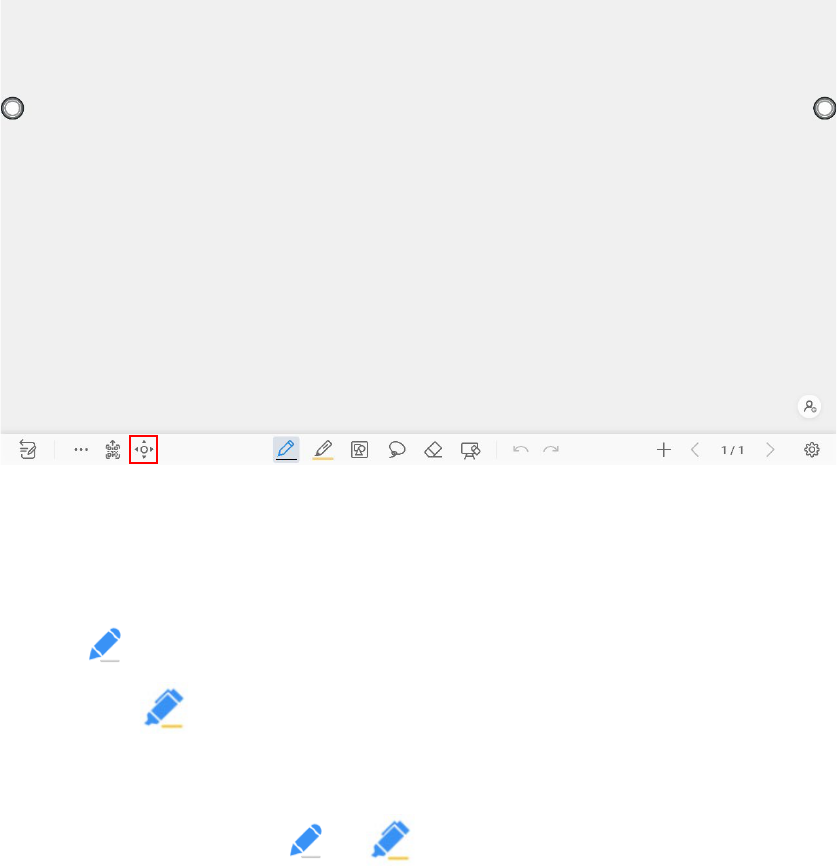
43
Move canvas
On the whiteboard, tap the icon to enter move canvas function, press and move your finger in
the page to move canvas and content on it.
Pen Type
On the Whiteboard, two types of pens are supported: Pen and highlighter.
Pen : used to write.
Highlighter : used to highlight. Characters covered by comments are still visible.
Line Size and Color
On the Whiteboard, tap and hold or for two seconds to set the size and color.
You can select the line size and color for writing, as shown in the following figure:
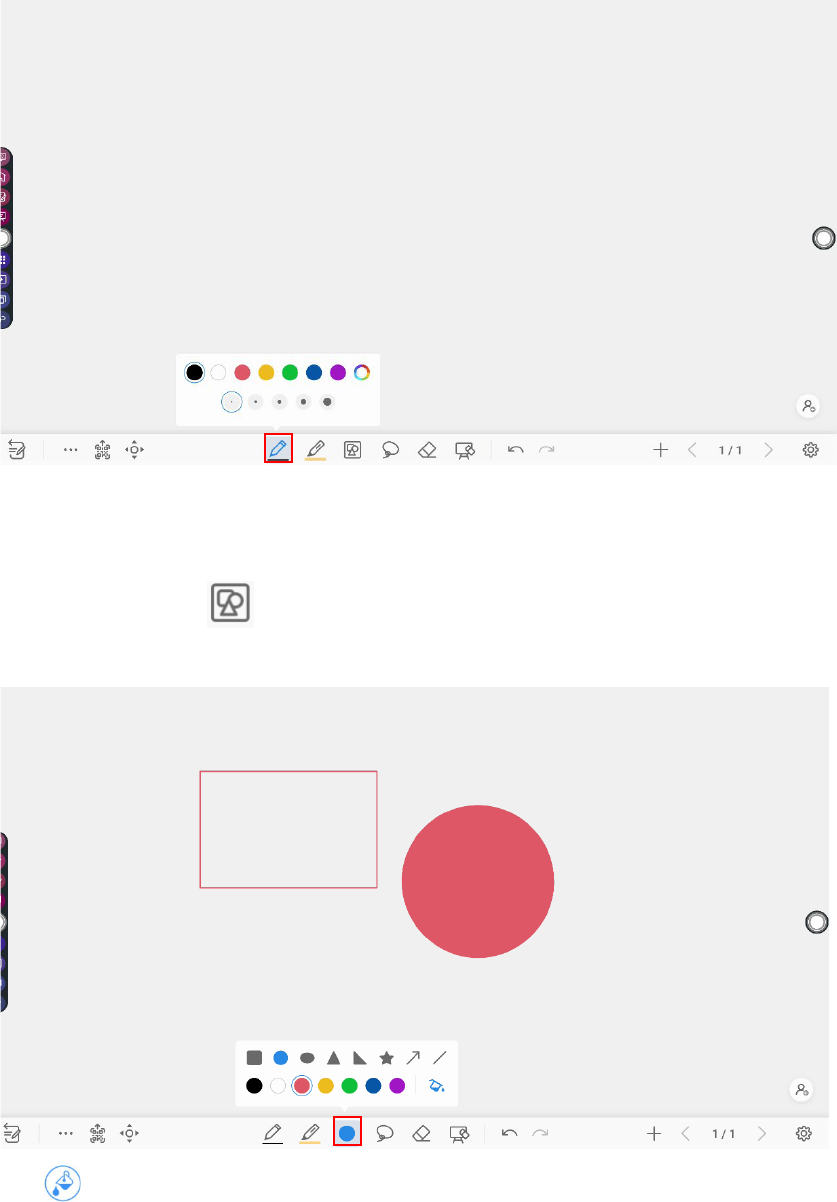
44
Insert auto shape
On the Whiteboard, tap to insert the shape or set the shapes and color.
Shapes: Circular, ellipse, square, equilateral triangle, right triangle, star, arrow, line
The icon supports three status:
Unavailable: The icon is unavailable when users insert arrow and line;
Unselected: The edge of shapes are colored when the icon is not selected;
Selected: the shape will be filled with colors when you import the shape;
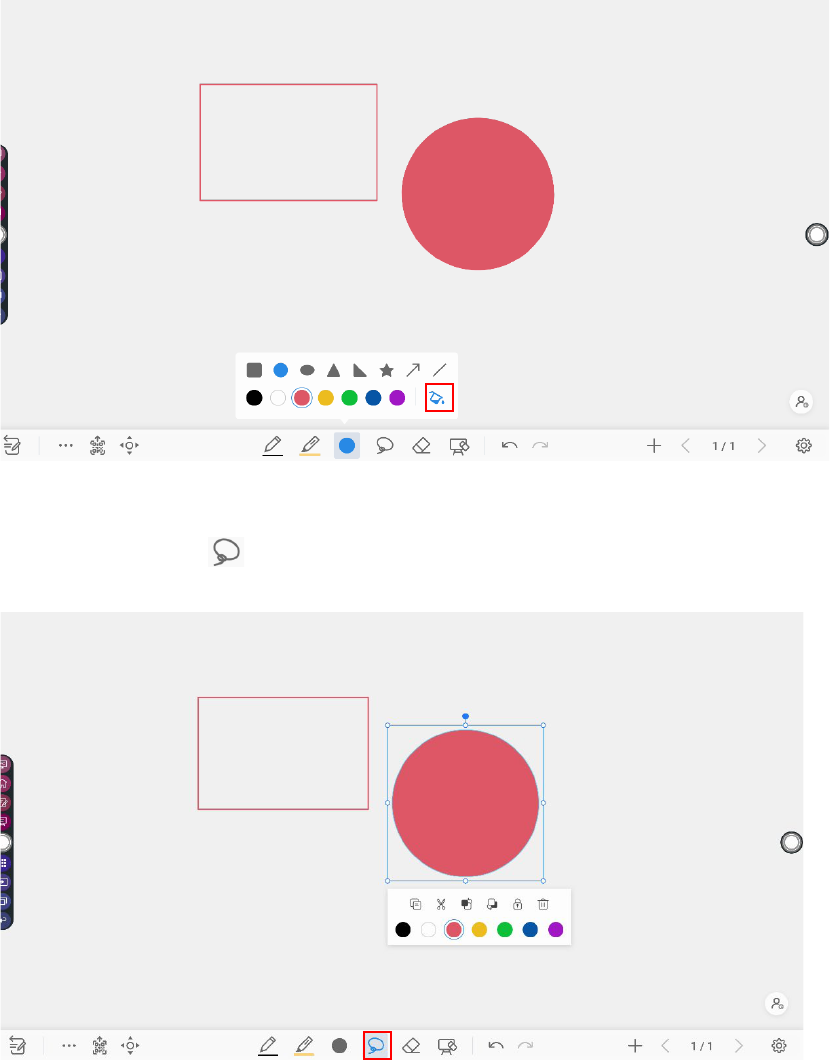
45
Select
On the Whiteboard, tap and user could choose the data on the page to move/ zoom in/
zoom out/ rotate/change colors.
Finger gesture
Rotate:
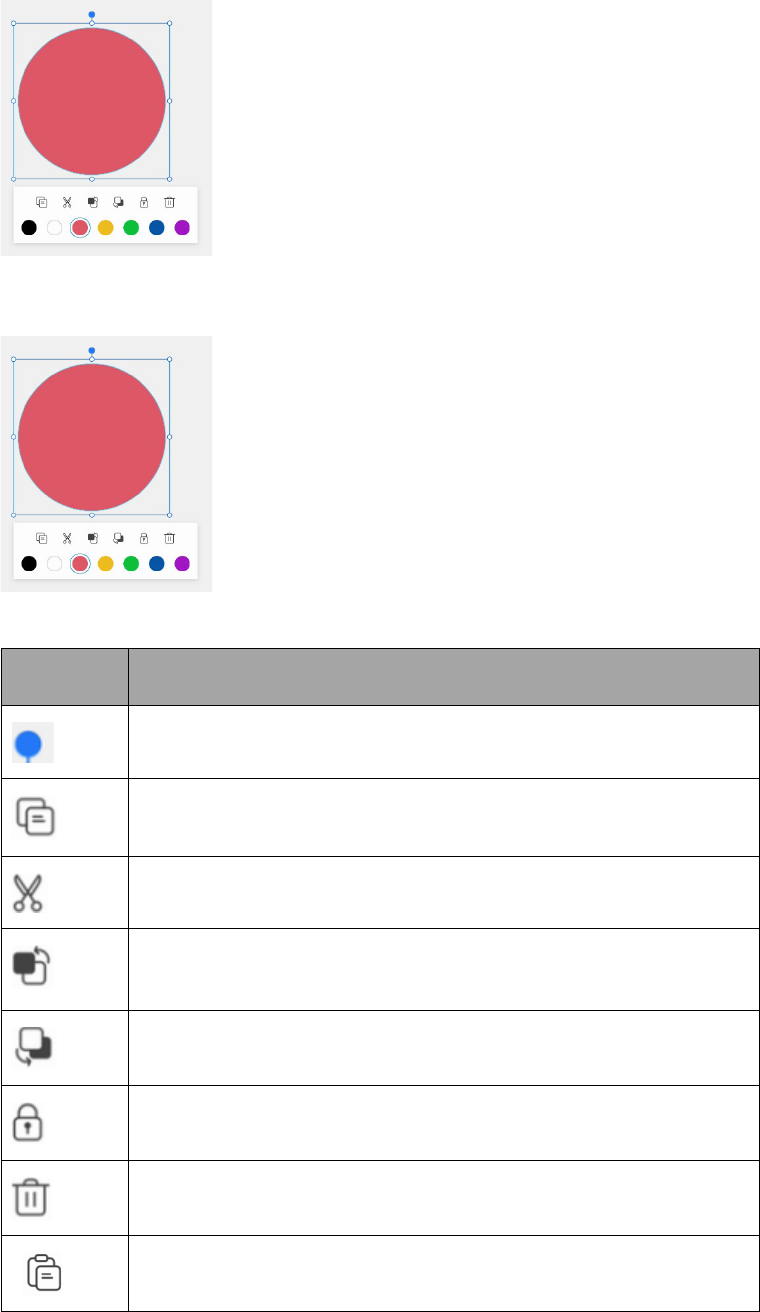
46
Zoom in/out:
Icon Functions
Long press this icon to Rotate the selected items
Tap this icon to copy the items.
Tap this icon to cut the items.
Tap this icon to Push to top layer.
Tap this icon to Push to bottom layer.
Tap this icon to lock the layer.
Tap this icon to delete the items.
Paste (long press the screen around two seconds, the icon will appear only
after one item copied or cut)
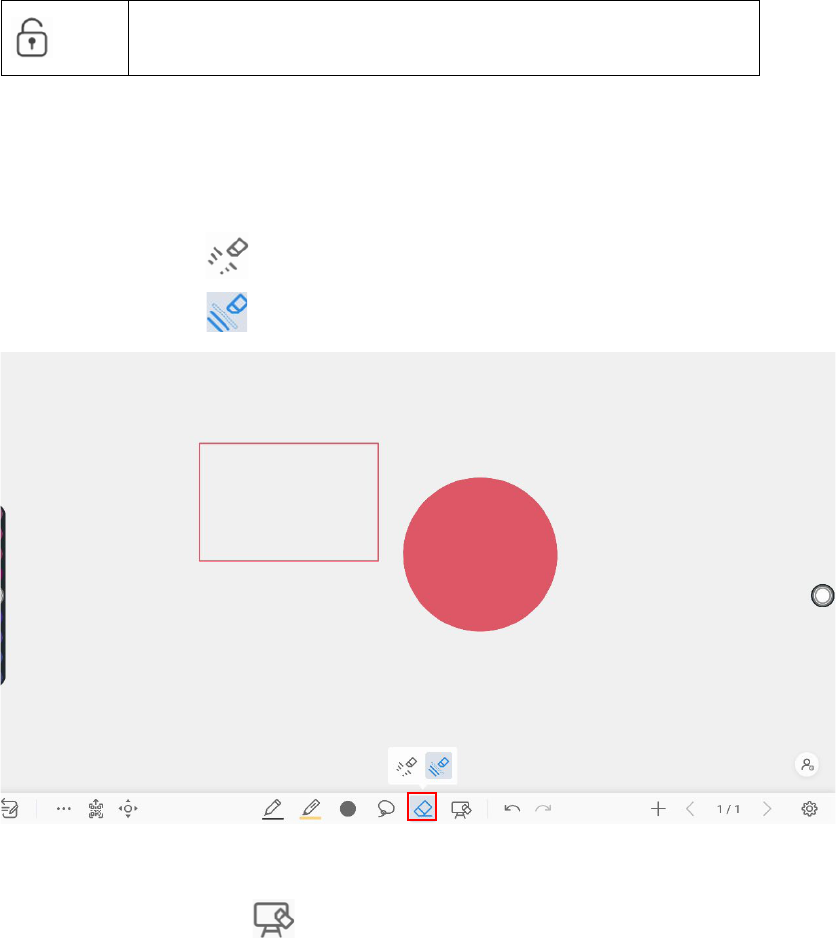
47
Tap this icon to unlock the layer. (the icon will appear only after one item
locked)
Eraser
Two methods are available to erase written errors or content as follows:
Partial eraser: Tap to clear the passing part of eraser.
Object eraser: Tap to clear the whole object.
Clear All
On the Whiteboard page, tap to show the pop-up windows to clear all content on the
current page, as shown in the following figure:
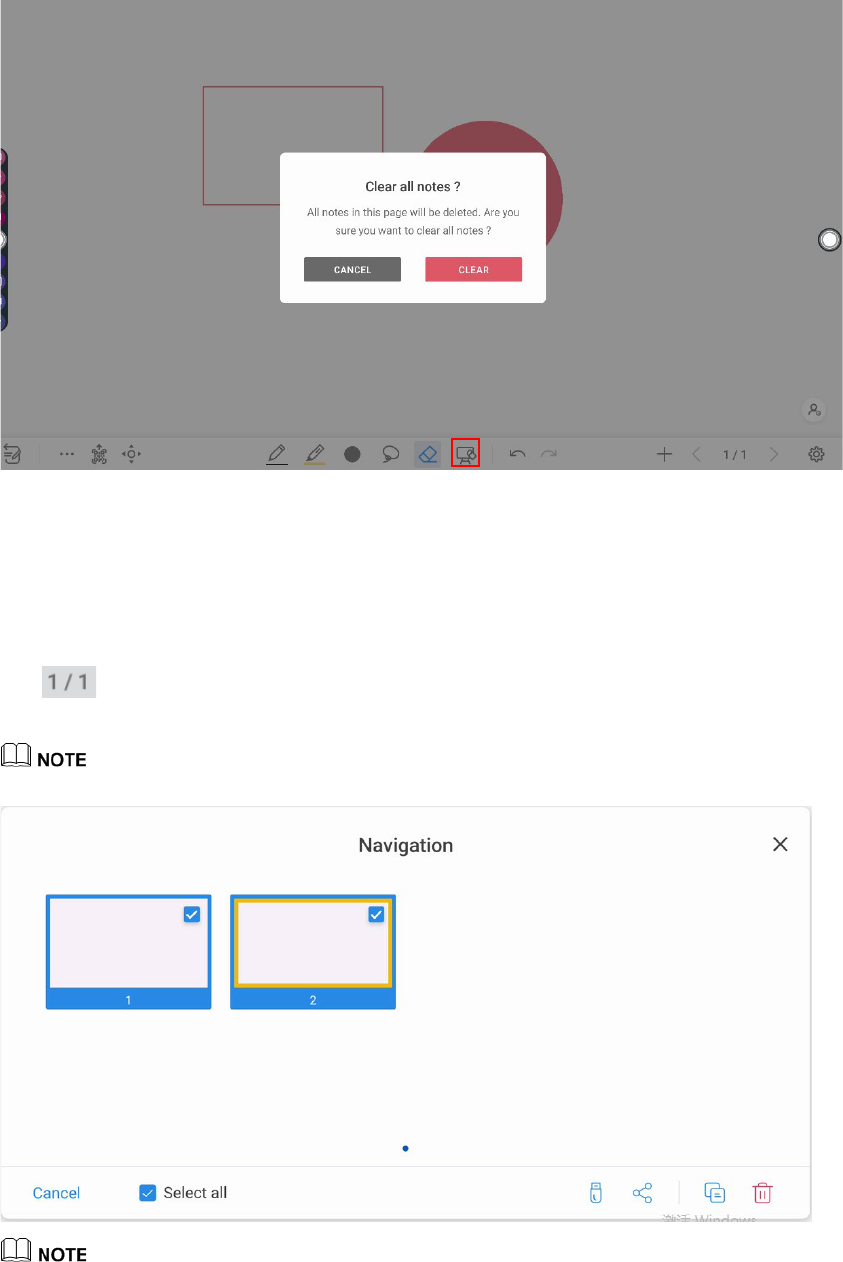
48
4.7.2 Page Operations
You can preview, select, and delete the writing page, you also can save the page to you USB
Flash device or local files.
Page Preview
Tap at the lower right corner in the whiteboard mode. All pages will be displayed. Tap
one page to switch to that page for more operations, as shown in the following figure.
Only 8 pages are displayed at once, and you can slide left by one finger to see more.
Only 8 pages are displayed at once. You can slide right or left using one finger to see more.
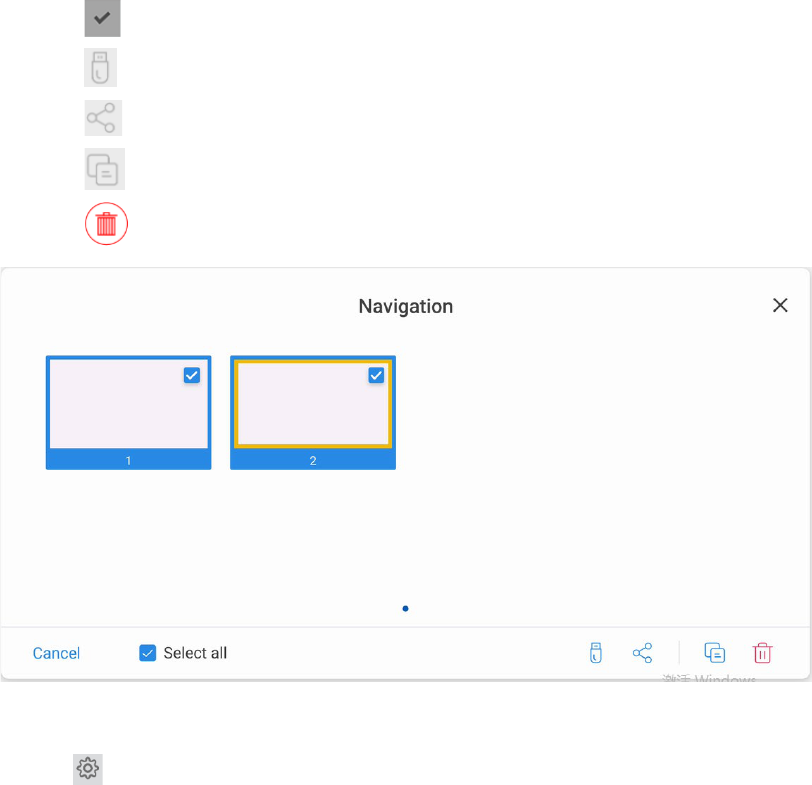
49
Page Operation
On the Navigation page, you can select or delete writing pages according to requirements, as
shown in the following figure:
Tap to select all pages.
Tap to save the writing pages to USB flash device.
Tap to share the writing pages to local file or AquaMail.
Tap to copy the page.
Tap to delete selected pages.
4.7.3 Whiteboard Setting
Tap the icon to enter the settings bar, users can set the object recognition, action hint and
default settings.
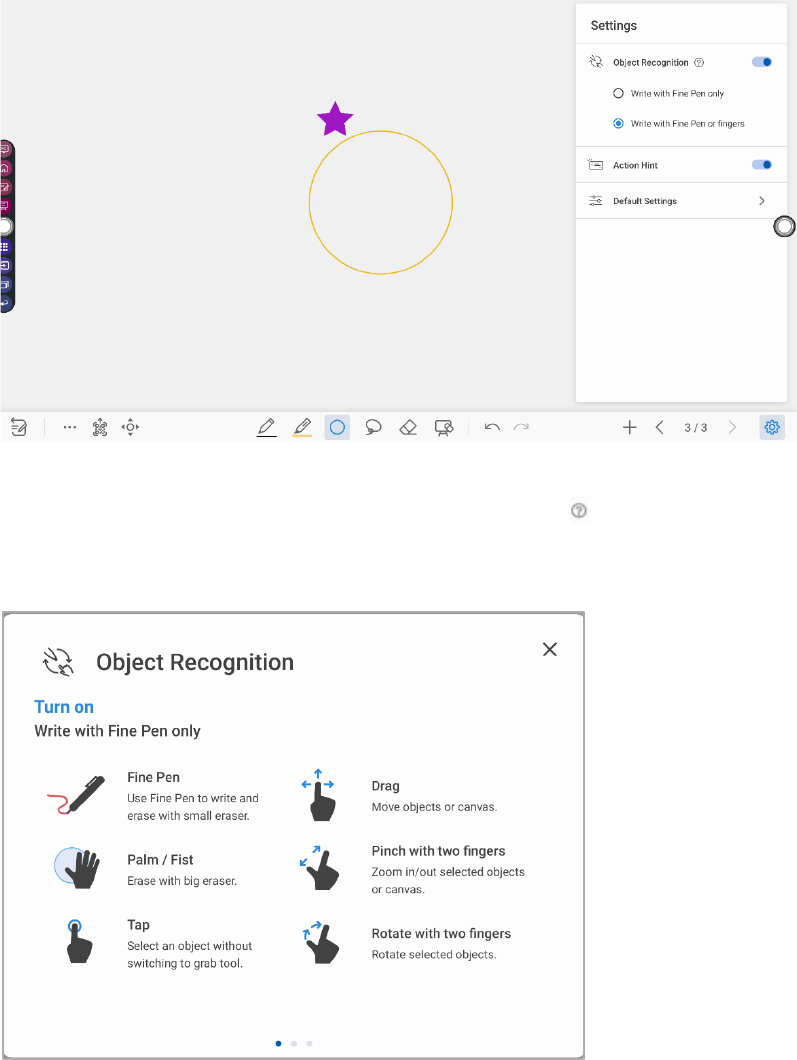
50
Object recognition
Users can drag the slider to enable the object detection function, tap icon to view details
functions, as shown in the following figure:
Example 1: Turn on write with Fine Pen only
Fine Pen (2mm): User Fine Pen to write and erase with small eraser.
Fist/palm: identified as an eraser (100 pt).
Tap: select an object without switching to grab tool.
Drag: move objects or canvas.
Pinch with two fingers: zoom in/out selected objects or canvas.
Rotate with two fingers: rotate selected objects.
Example 2: Turn on write with Fine Pen or fingers
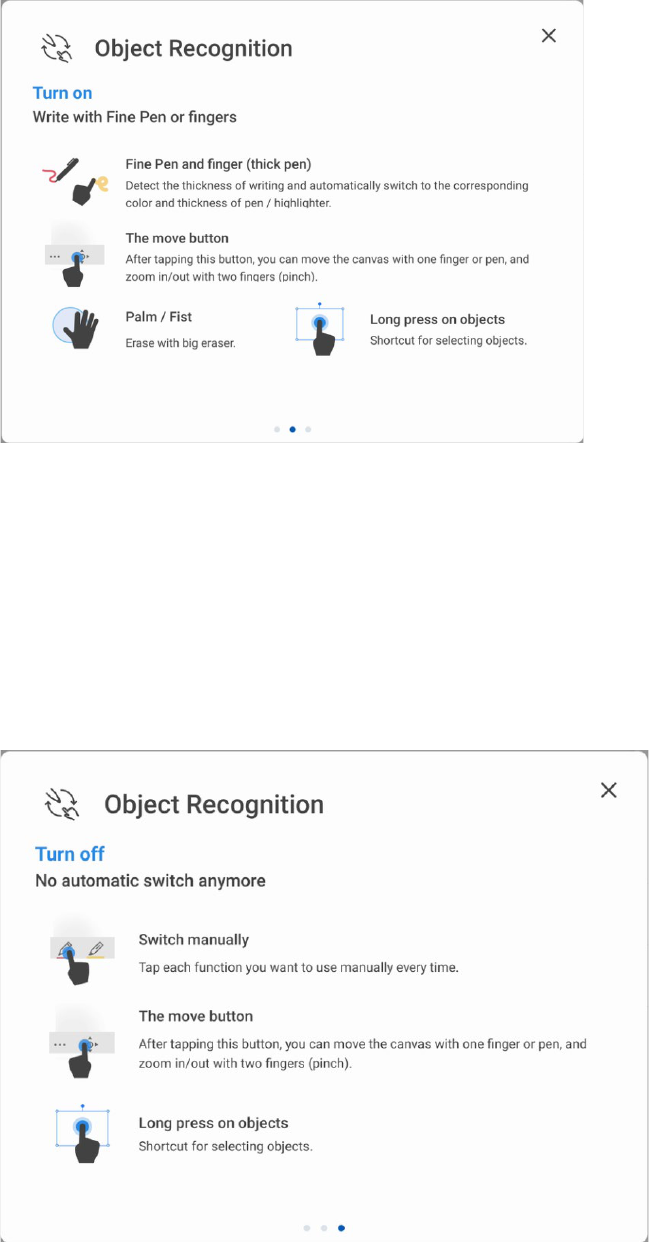
51
Fine Pen and finger (thick pen): User Fine Pen or finger (thick pen) to write. System will
detect the thickness of writing and automatically switch to the corresponding color and
thickness of pen/highlighter.
The move button: after tapping this button, you can move the canvas with one finger or
pen, and zoom in/out with two fingers (pinch).
Palm/Fist: Erase with big eraser.
Long press on objects: shortcut for selecting objects.
Example 3:Turn off object recognition
Switch manually: Tap each function you want to use manually every time.
The move button: after tapping this button, you can move the canvas with one finger or
pen, and zoom in/out with two fingers (pinch).
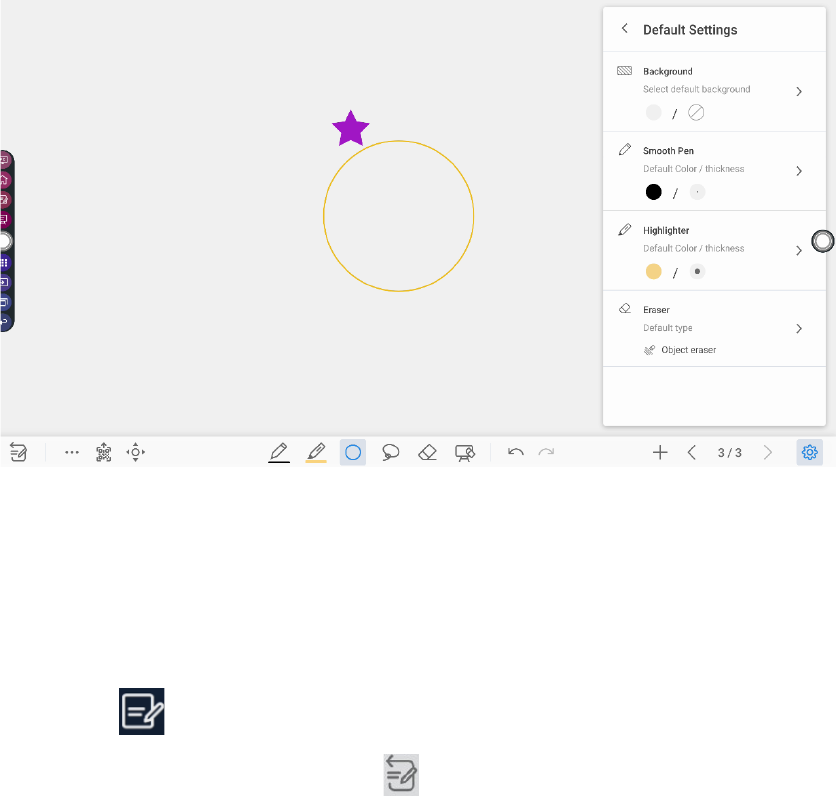
52
Long press on objects: shortcut for selecting objects.
Action hint: Drag the slider to enable the action hint.
Default settings: Tap the button to enter default setting page, users can set whiteboard page
background, change the color and thickness of Smooth Pen and Highlighter, change the
default type of eraser, both object eraser and partial eraser can be set.
4.8 Annotation
In annotation mode, the system generates a transparent layer at the top of the screen, and users
can add annotations to the transparent layer until the annotation mode is exited.
The user can enter the annotation mode through the following two methods:
Tap the “ ” icon in the sidebar;
In the “Whiteboard” interface, tap the “ ” icon.
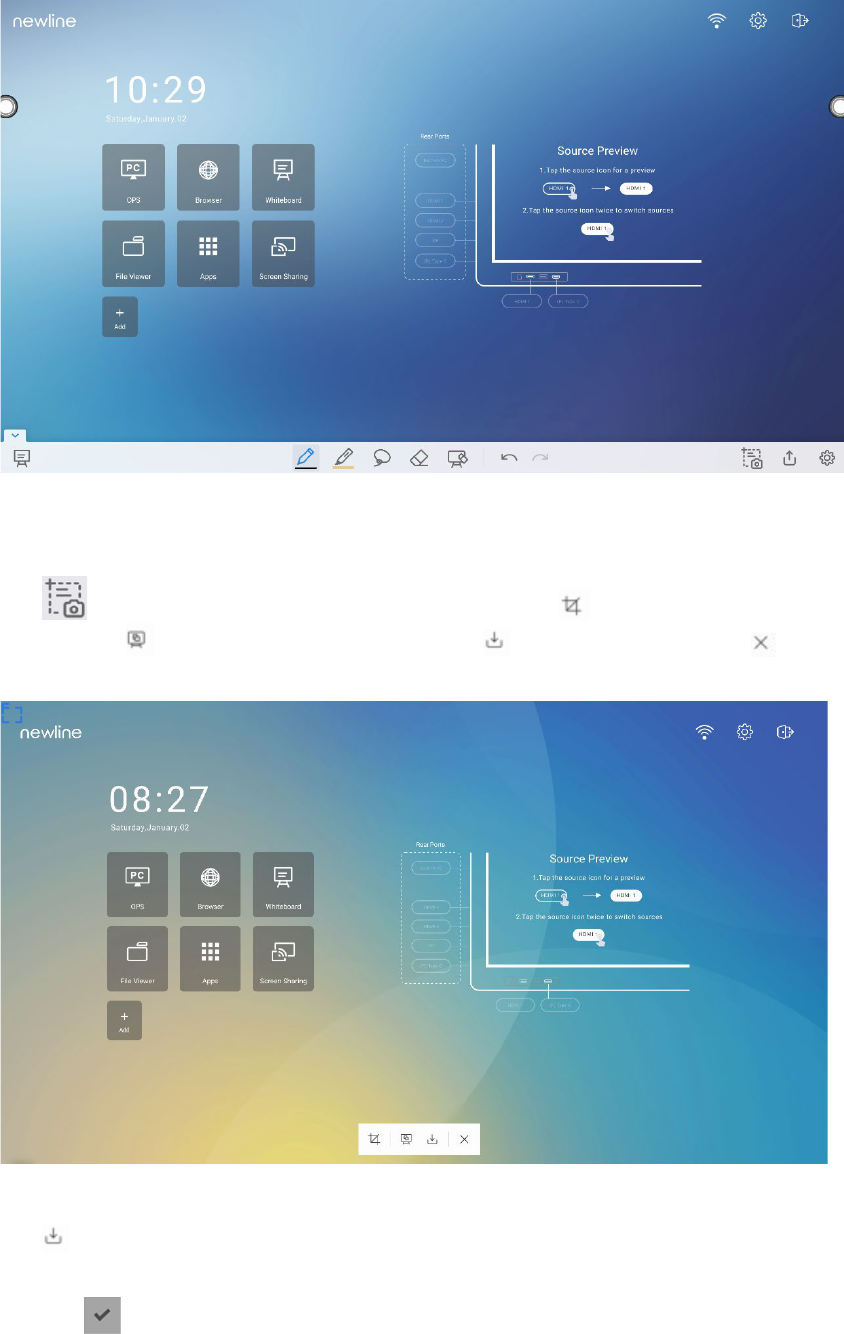
53
Take a Screenshot
Tap icon to enter take a screenshot interface, users can tap icon to take a
screenshot; tap icon to switch to whiteboard mode; tap icon to save screenshot, tap
icon to exit screenshot.
Save screenshot
Tap icon to pop up save screenshot interface, you can save or share screenshot as
following:
Tap to select all pages.
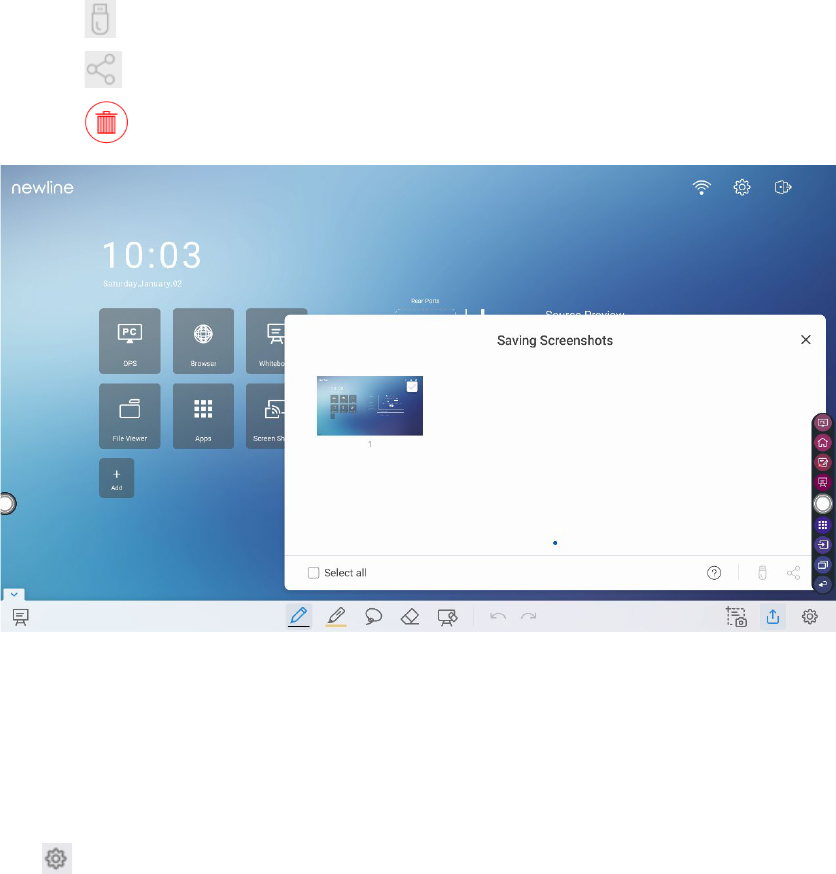
54
Tap to save the annotation pages to USB flash device.
Tap to share the annotation pages to local file or AquaMail.
Tap to delete selected pages.
Notes:
You can select "Internal storage > Pictures > Screenshots > image" folder to view or get
screenshots.
Settings
Tap icon to pop up settings interface, you can turn on/off object recognition, Action hint
and Auto screenshot. If auto screenshot setting is on, System will automatic take a screenshot
when exiting the annotation mode.
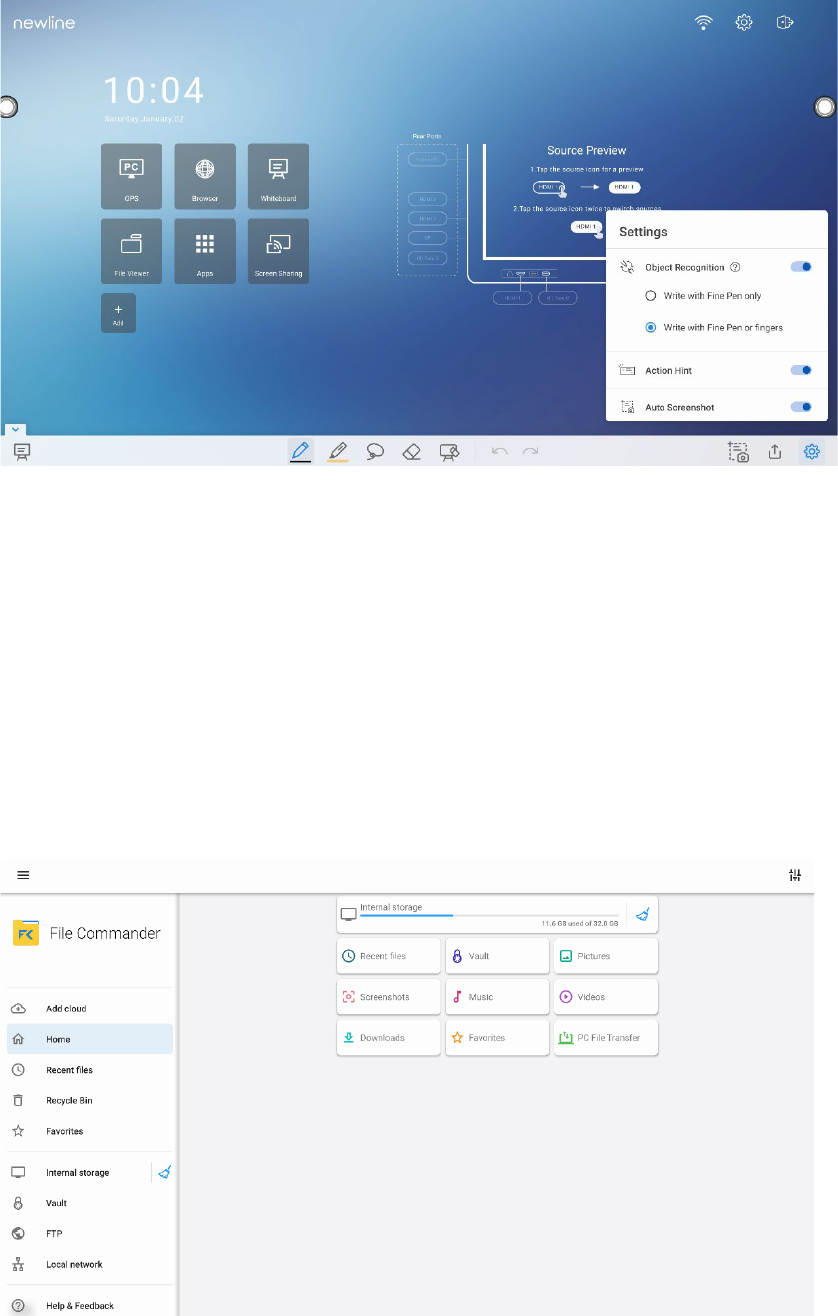
55
Notes:
If you need more details instruction, please refer to whiteboard setting.
4.9 File Management
The product supports connection to USB flash memory. In File Viewer application, you can
preview all files in the internal storage and storage devices connected via USB ports and
select, copy, paste, delete and search for files.
4.9.1 File Viewer Page
On the Home page, tap File Viewer to enter file commander interface, you can tap the icon to
view pictures or files, as shown in the following figure:
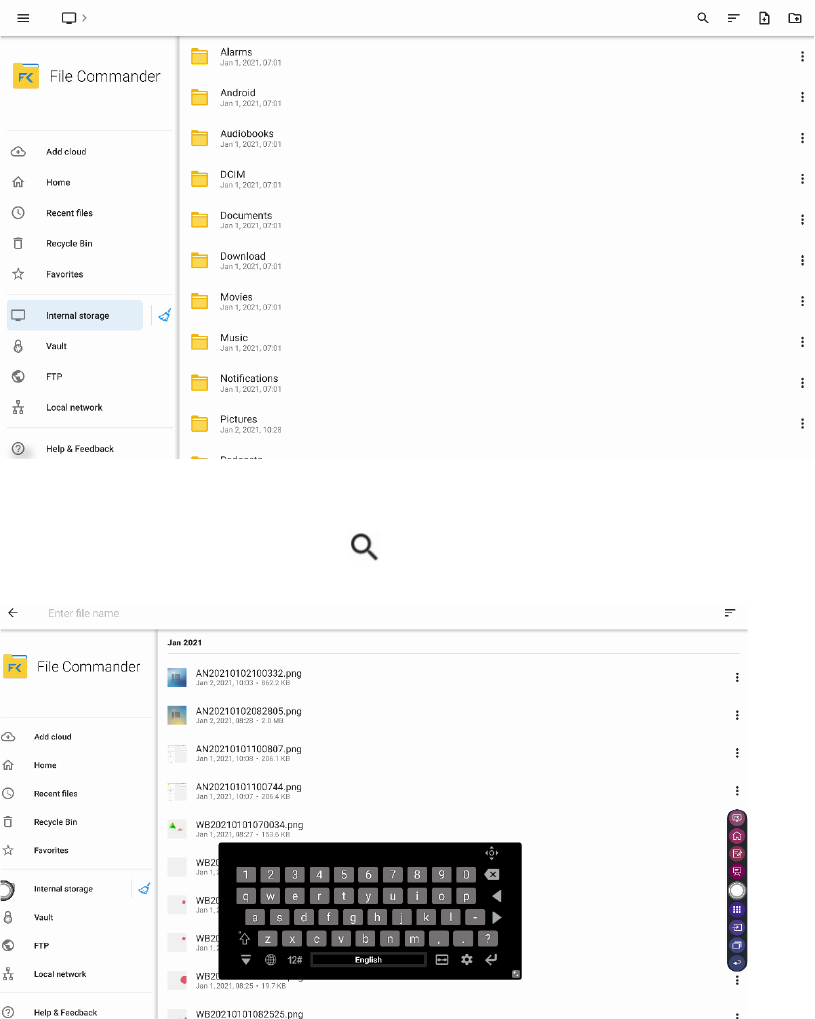
56
4.9.2 File Preview
Using the File Viewer application, you can tap the submenu on the left side to preview what
files are on internal storage, external storage devices connected via the USB ports, cloud
stored files, FTP uploaded files, and local network files, as shown in the following figure.
4.9.3 File Search
Enter the File Viewer application and tap . In the dialog box, enter the keywords in the
search box. The system will display a list of files that match the searched for keywords.
4.9.4 File Filtering
You can tap the menu on the left side to display files by type, for example, whether the files is
a document, a picture, music, a video, archived or was downloaded.
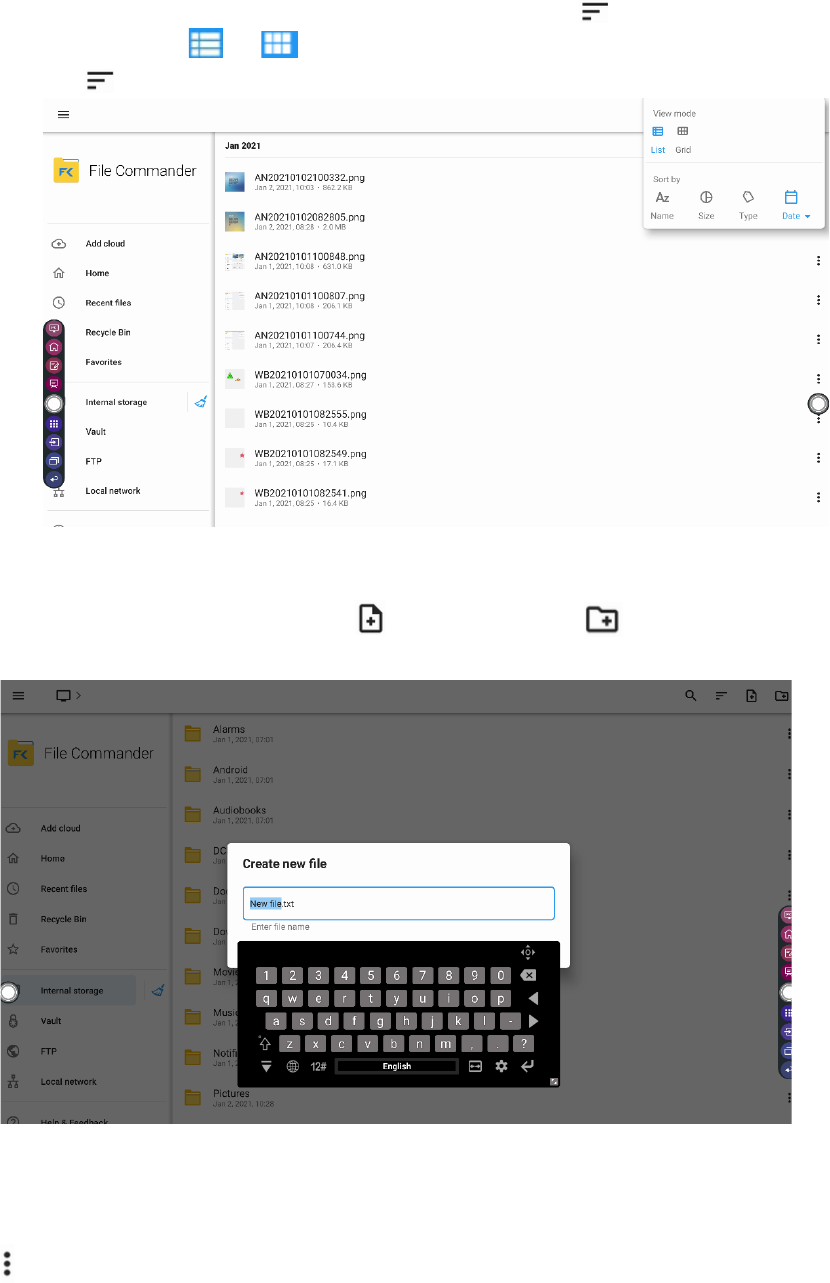
57
The system supports two view modes: list and grid. You can tap on the top right
corner to switch or view modes.
Tap to display files based on name, type, size, and modification.
4.9.5 New Folder
Enter the File Viewer application, and tap to create new file or tap to create new
folder, as shown in the following figure.
4.9.6 File Operation
Enter the File Viewer application. You can create folders according to requirements, select
files by long pressing, and set wallpaper/copy/paste/delete. For details on other operation, tap
in the upper right corner for more operation.
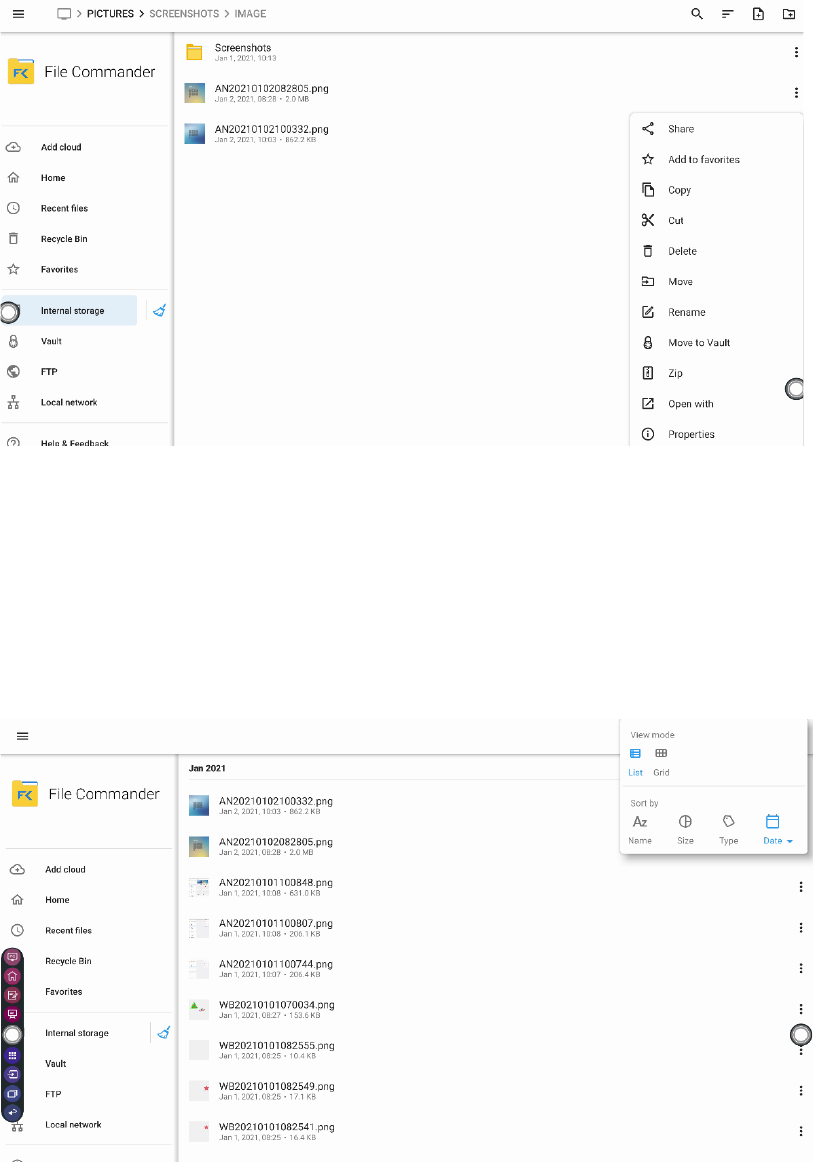
58
4.9.7 File Name
Under the "Internal storage > Pictures > Screenshots " folder in the File Manager, remote
control screenshots of this meeting are saved.
Screenshots include annotation page screenshots, screenshot pages in the discussion mode are
saved in the "Internal storage > Pictures > Screenshots > image" folder. Depending on the
screenshots mode, picture naming is different. Picture files are named in the following of
prefix + creation file.
Prefix name rule: WB (discussion mode page), AN (annotation page screenshot).
4.10 Browser
On the Home page, tap Browser to view web page, as shown in the following figure:
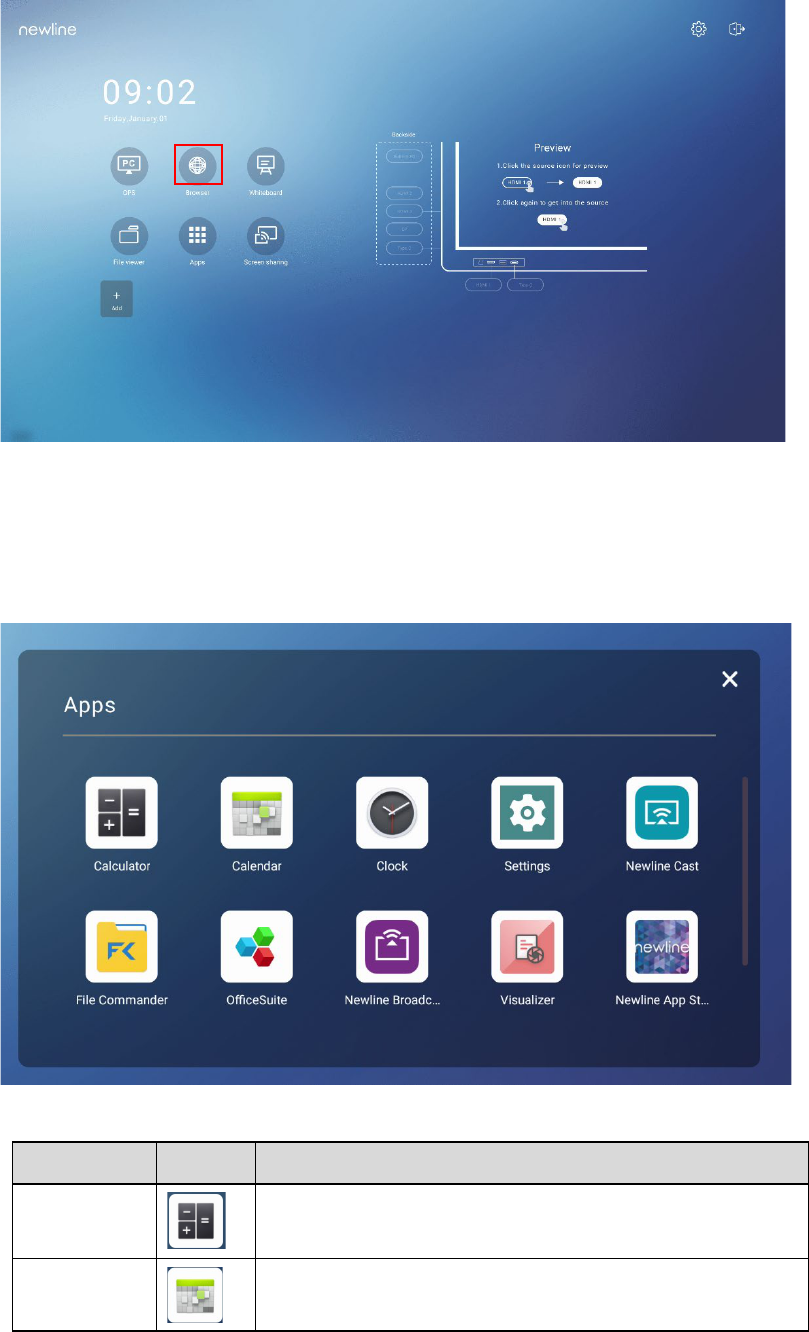
59
4.11 Apps folder
On the Home page, tap Apps. On the page that is displayed, all applications can be viewed. The
following figure shows applications that the system is delivered with
.
Name Icon Functions
Calculator
Tap this icon to enter the calculator application.
Calendar
Tap this icon to enter the calendar application.
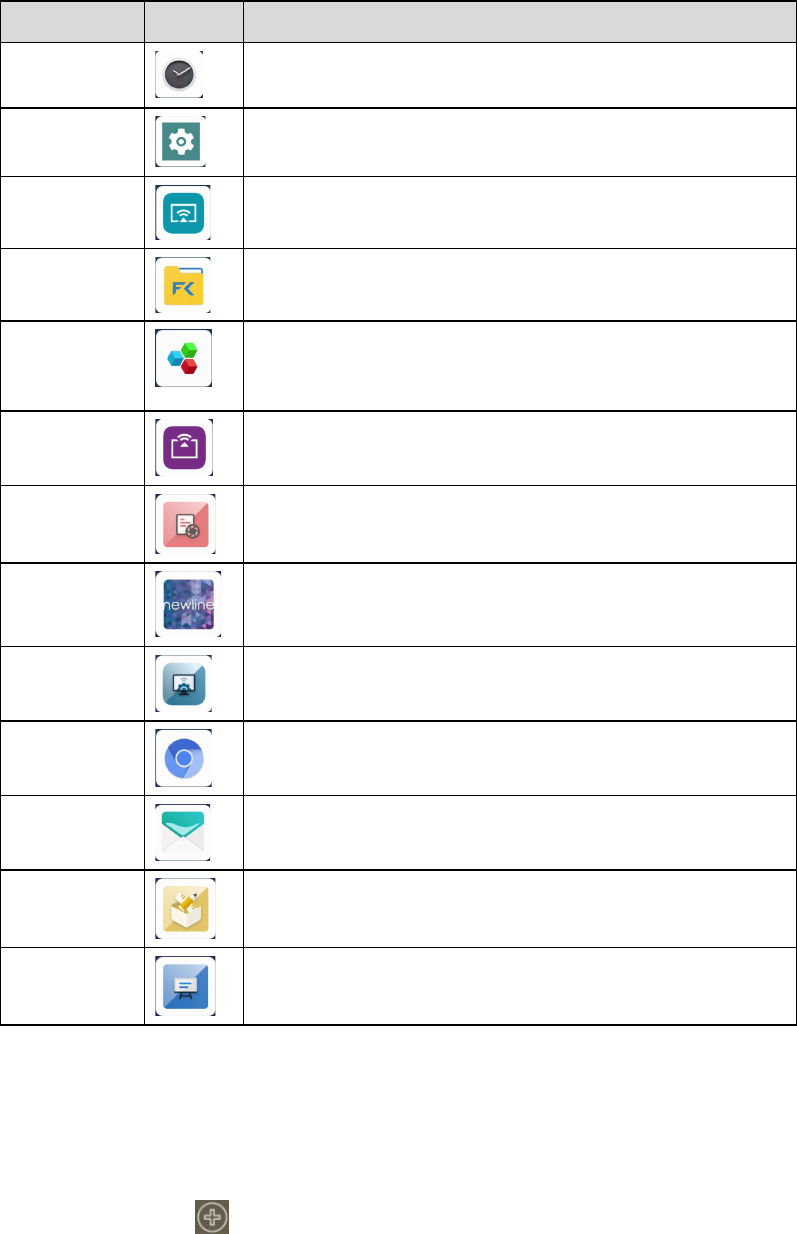
60
Name Icon Functions
Clock
Tap this icon to enter the clock application.
Settings
Tap this icon to enter the settings application.
Newline Cast
Tap this icon to enter the Newline Cast application.
File viewer
Tap this icon to open the File Manager and you can explore all
internal and external files on the screen.
Office suite
Tap this icon to enter the Office suite application. In this
application, you can view office files, including excel, word,
power point, and PDF files.
Newline
Broadcast
Tap this icon to enter the Newline Broadcast application.
Visualizer
Tap this icon to enter the visualizer application.
Newline app
store
Tap this icon to enter the newline app store application.
Newline
display
Tap this icon to enter the Display diaplay application.
chromium
Tap this icon to enter the chromium application.
Aqual mail
Tap this icon to enter the email application and send files.
Before sending files, you need to add an email account.
Newline
classroom
Tap this icon to enter the newline classroom application.
Whiteboard
Tap this icon to enter the whiteboard application.
4.12 Add Shortcut
4.12.1 Add Shortcuts to Home Page
Step 1 On Home page, tap the icon in the lower right corner to access the interface for adding
shortcuts.
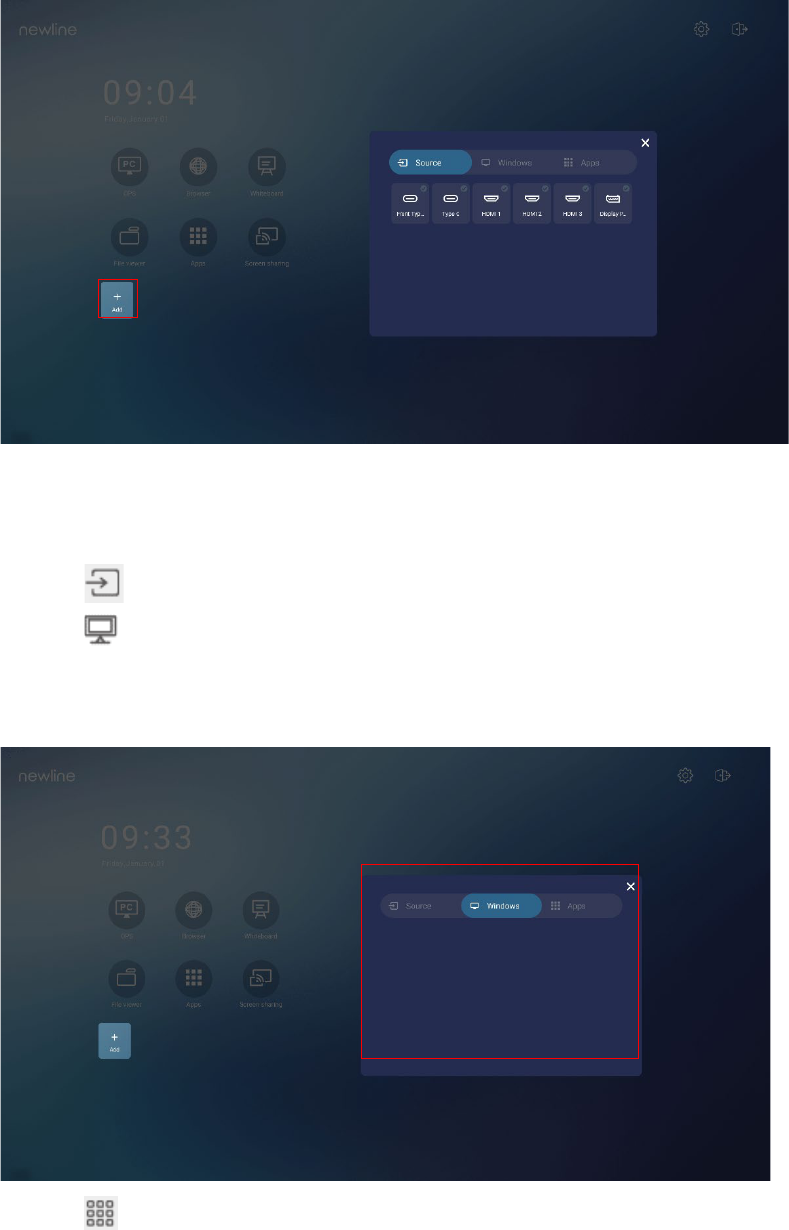
61
Step 2 Tap the icons across the top to switch the list between external signal sources, Windows
software shortcuts and pre-installed apps.
Tap to view signal sources in Connection.
Tap to view the Windows software shortcuts that the Newline Assistant uploads to
the embedded operating system. For details, see “Add Quick Start Windows Programs in
Smart System”.
Tap to view all applications.
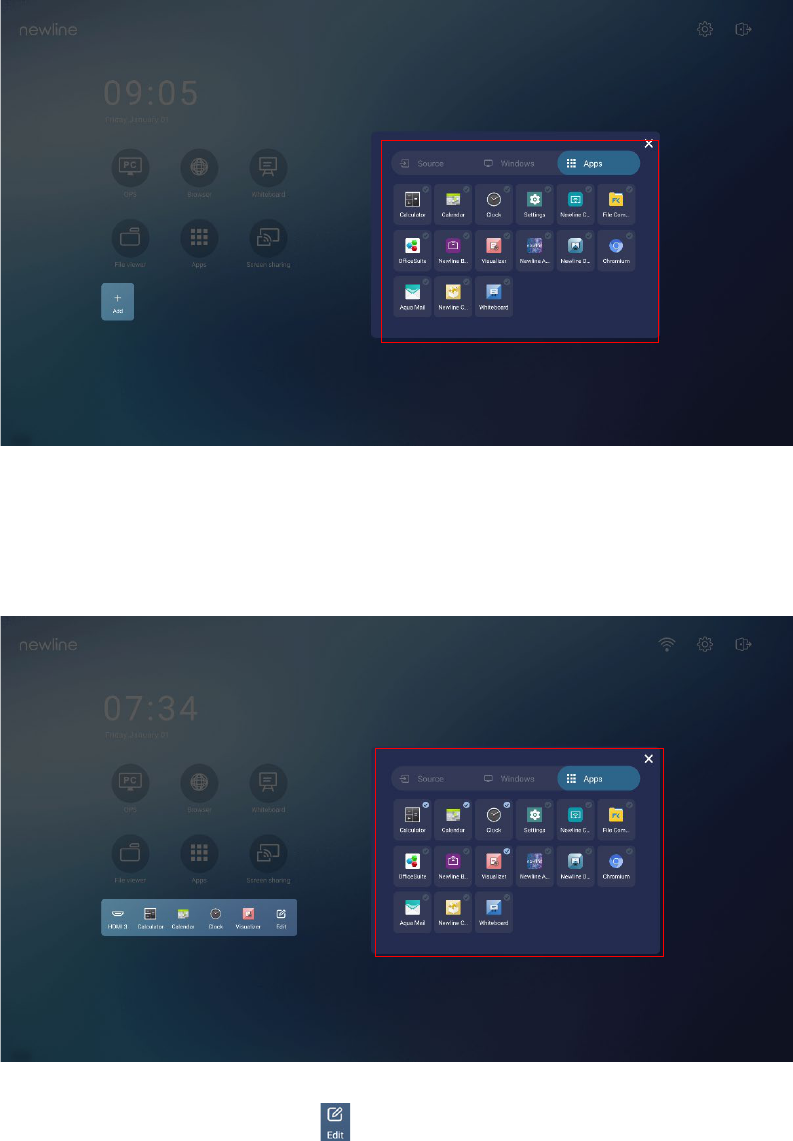
62
Step 3 Add or delete applications on the tab.
In the list, tap the icon to add it as a shortcut on the Home page. A check icon will appear
at the upper right corner of the shortcut icons. Up to 5 shortcuts can be added.
Tap the icon with the check mark again. The check icon will disappear and the shortcut
will be removed from the Home page.
Step 4 On the Home page, tap the shortcut icon and you can start the program/application or change
to the external signal source. Tap the icon to view adding shortcuts interface.
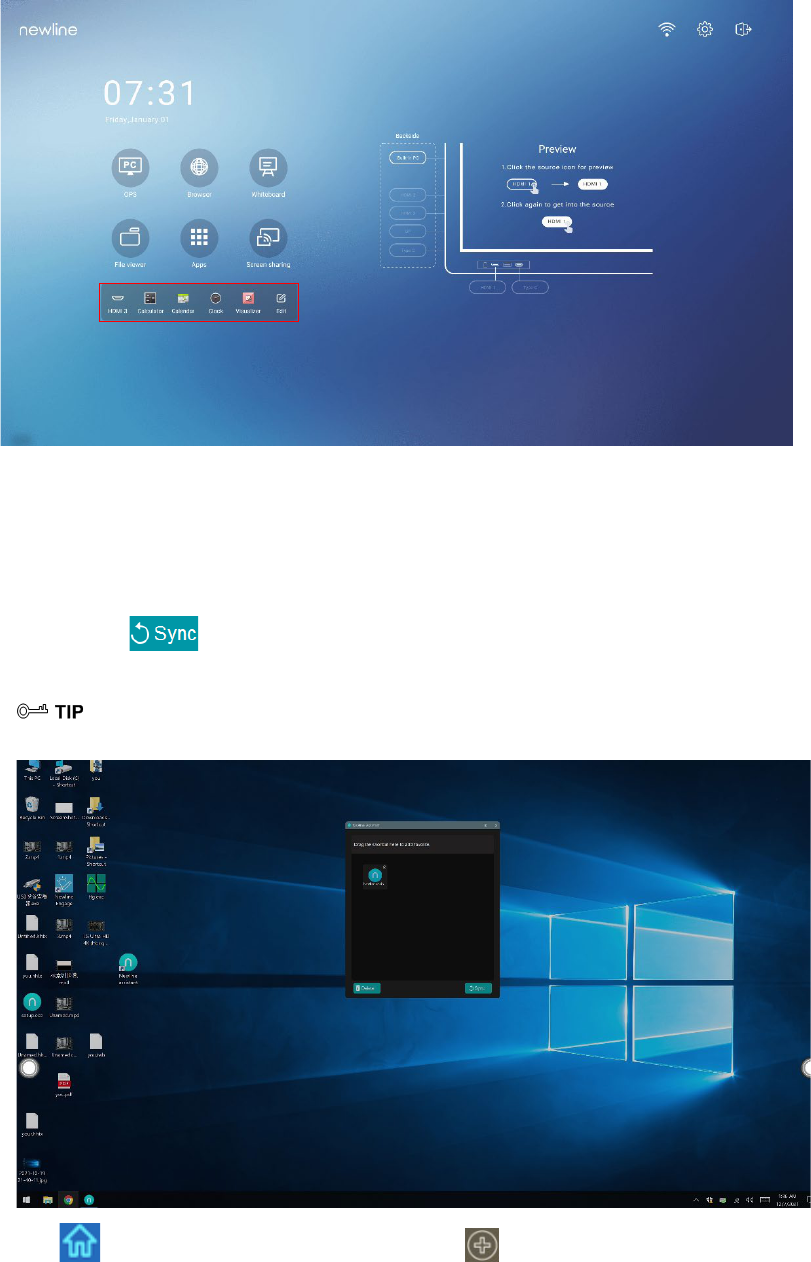
63
4.12.2 Add Quick Start Windows Programs in Smart System
Step 1 In Windows, run the Newline Assistant program and drag the software icons or folder
shortcut icons that you want to add from the desktop or menu to the Newline Assistant
window. The applications added or deleted through the Windows system will be
automatically updated when the upload progress reaches 100%. If an application is not
updated, tap icon in the upper right corner to manually update the Newline assistant
window on the embedded operating system.
Only folders and .exe file are supported.
Step 2 Tap icon to return to the Home Page. Tap the icon to view the shortcuts interface.
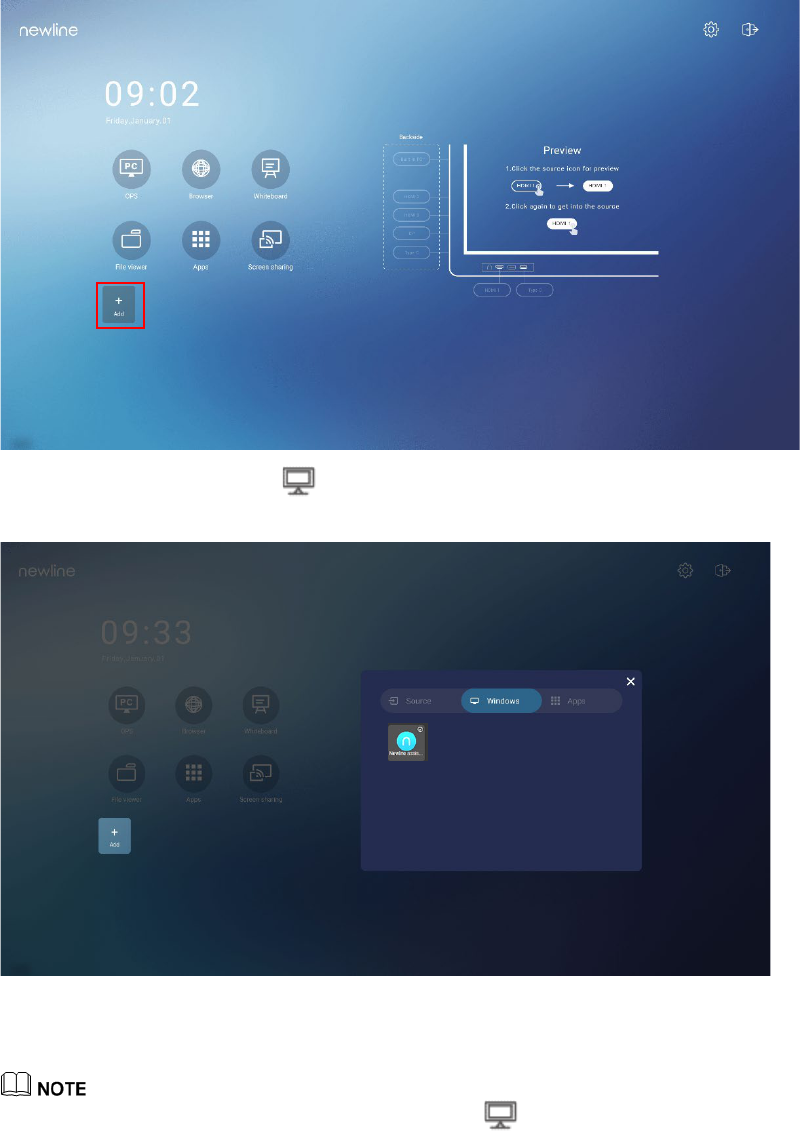
64
Step 3 On the shortcut setting page, tap icon to view all the Windows software shortcuts added
by the Newline Assistant in Step 1.
By default, the Newline Assistant application is added on the tab.
Step 4 Tap the icon to add the shortcut on the Home page or tap again to remove it.
Step 5 Return to Home page. Tap the added shortcut to launch the Windows application.
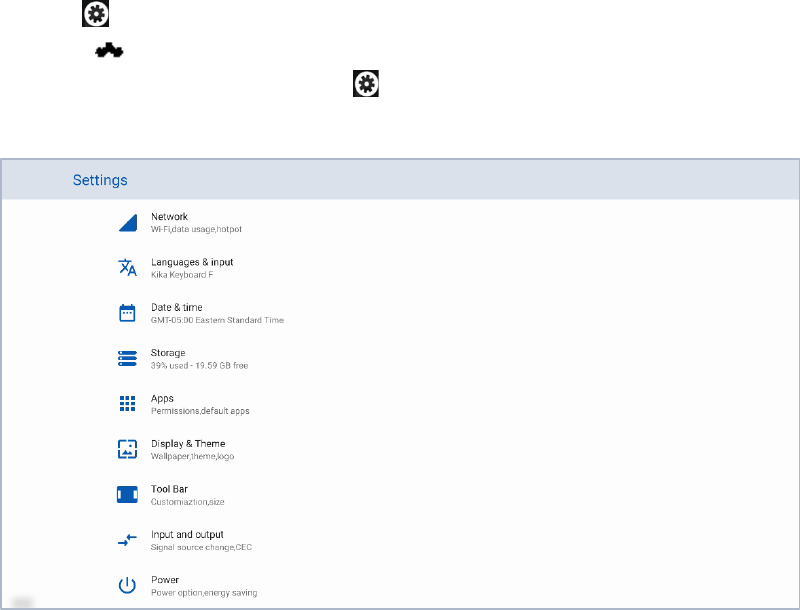
65
4.13 Automatically Power Off
If the screen is left un-operated for a specified duration, it will be locked to guarantee your privacy.
Choose Settings> Power Setting to set the duration. For details on the setting method, see "
Power
Setting
".
After the screen is locked, if it is operated again within 120 seconds, the screen is unlocked.
Otherwise, the screen enters the power off mode
.
4.14 System Settings
Enter the system setting page using one of the following methods:
Tap on the Home page.
Press on the remote control.
In the Quick Setting Menu, tap the icon.
4.14.1 Network Settings
Enter the Network submenu to enable Wi-Fi or Ethernet, view network information, and
enable the Wake on LAN function.
Wi-Fi: Tap the corresponding button to enable the Wi-Fi function.
Ethernet: When the RJ45 port is properly connected to the network cable, tap the
corresponding button to enable the Ethernet function. User can View the MAC address,
IP address, gateway, subnet mask, and DNS information. The user can customize settings
to automatically obtain an IP address of the LAN or set a static IP address as needed.
Hotspot & tethering: The user can customize relevant settings for portable Wi-Fi
hotspot.
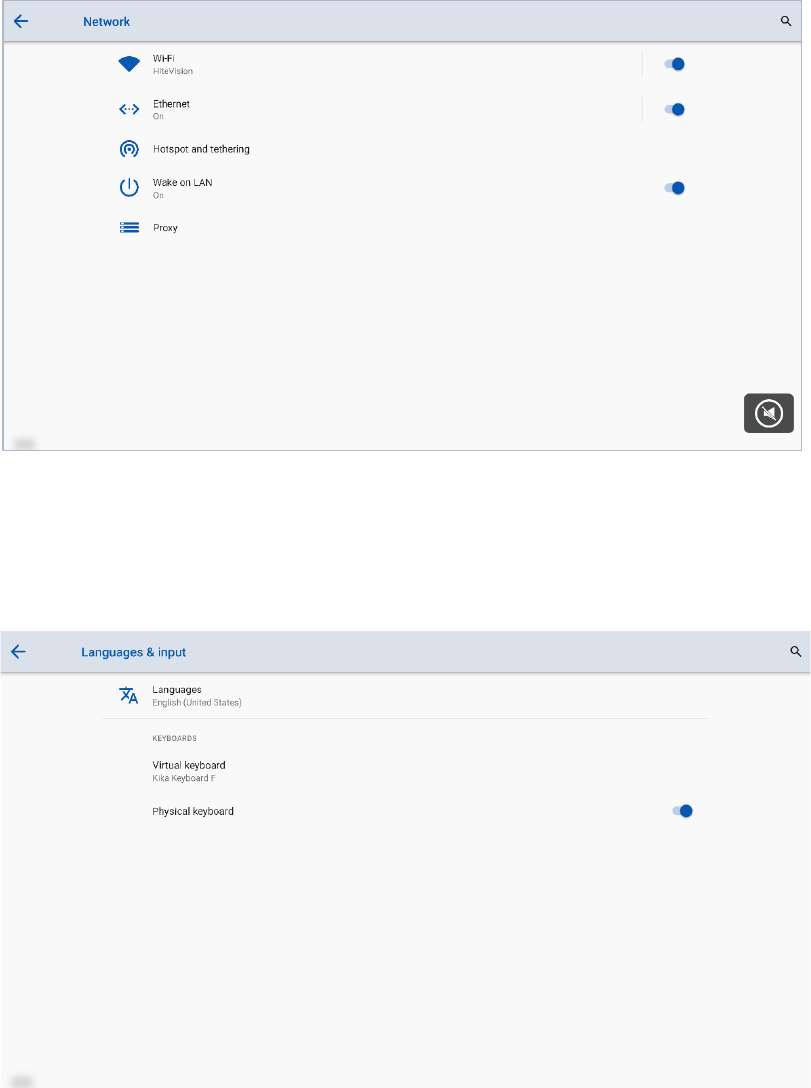
66
Wake on LAN: Tap the corresponding button to enable Wake on LAN function.
Proxy: Tap the item to view proxy server.
4.14.2 Language and Input
Enter the Language & Input submenu to set language and keyboard. The default input
method of the system is Kika Keyboard F, and Physical keyboard must be enabled.
Setting kika keyboard F
Tap Virtual keyboard at the left side, select kika keyboard F to set a language in the
keybaord dialog box.
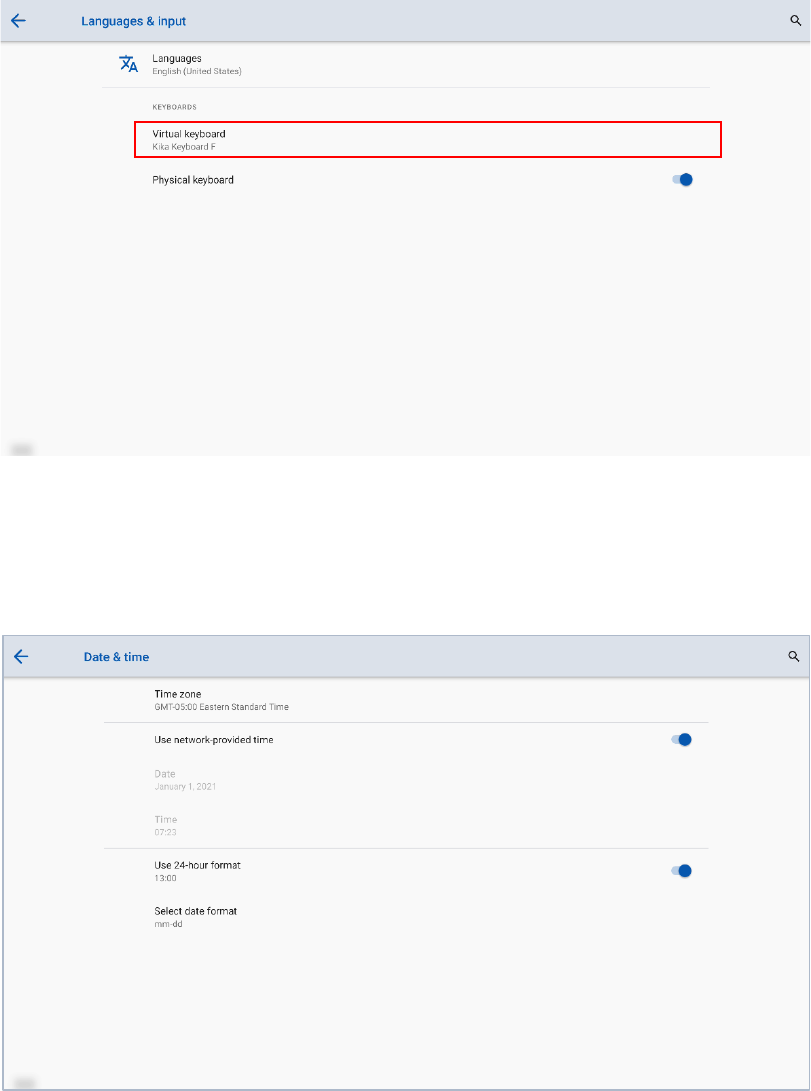
67
4.14.3 Date and Time Settings
Enter the Date & Time submenu to set the date and time. Before setting the date and time,
users should tap Time zone to select local time zone.
Setting a Date
You can automatically obtain the system date or customize a date.
To automatically obtain a date, select Use network provided time.
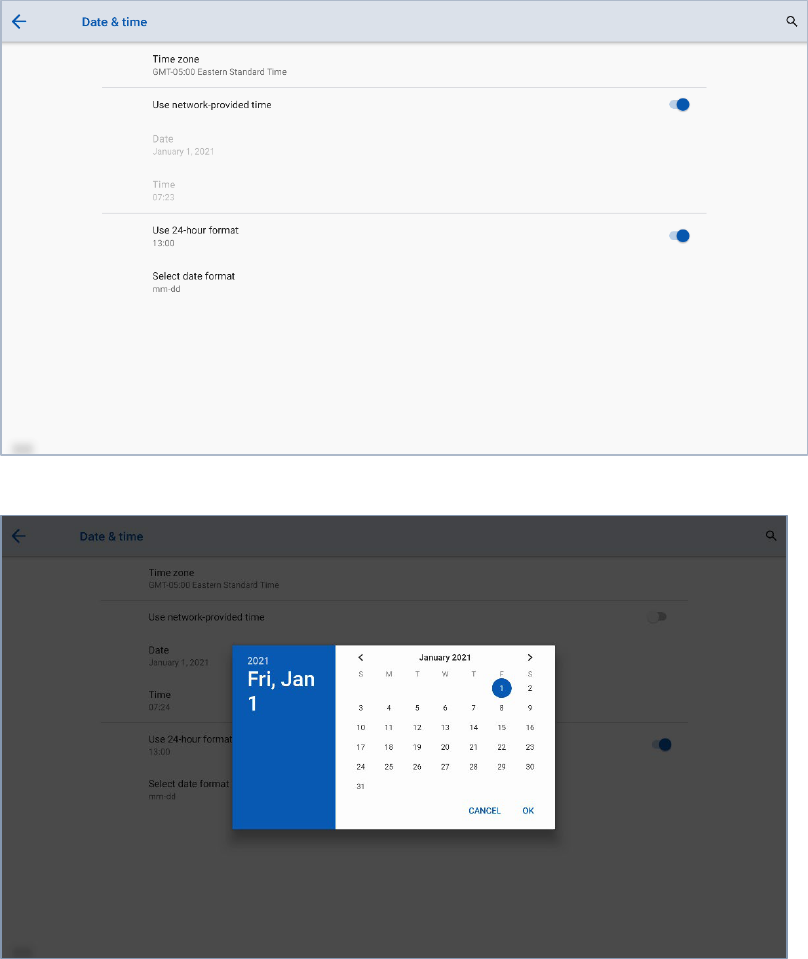
68
To customize a date and date format, set them in date and Select date format.
Setting Time
You can automatically obtain the system time or customize time.
To automatically obtain time, select Use network provided time.
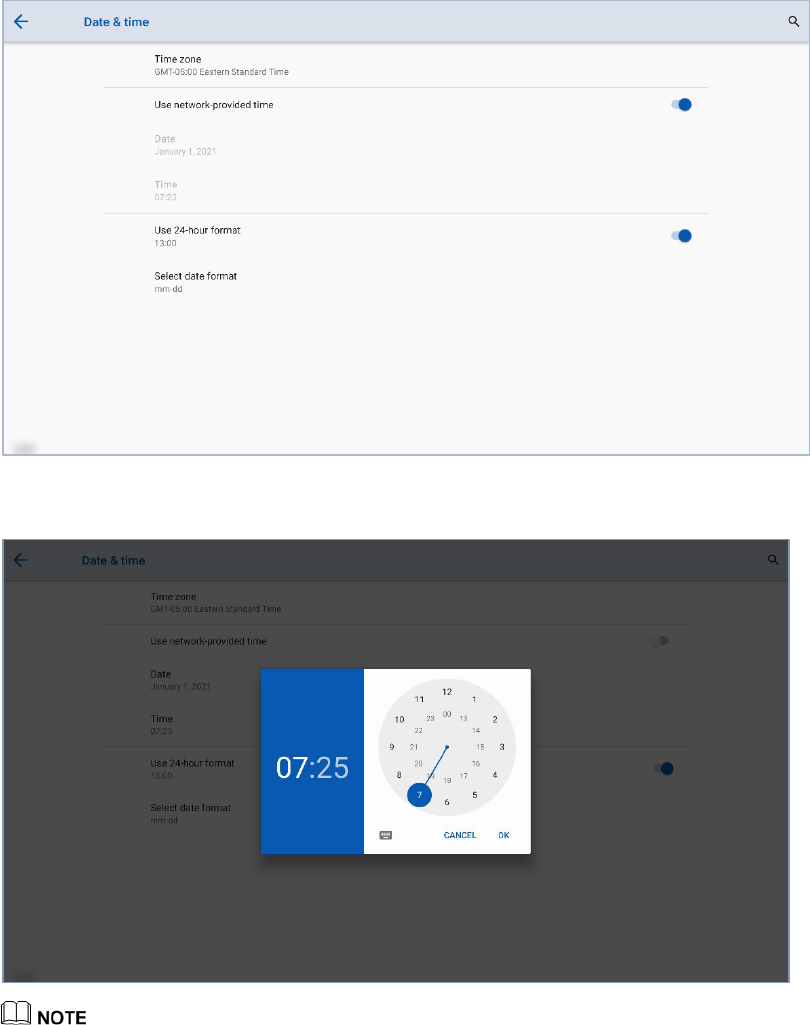
69
To customize time and time format, set them in time and Use 24-hour format.
Time format will be 24-hours mode only when the Use 24-hour format is selected, othersize
time format will be 12 hours mode.
4.14.4 Storage
Enter the Storage submenu to view space distribution of the internal storage.
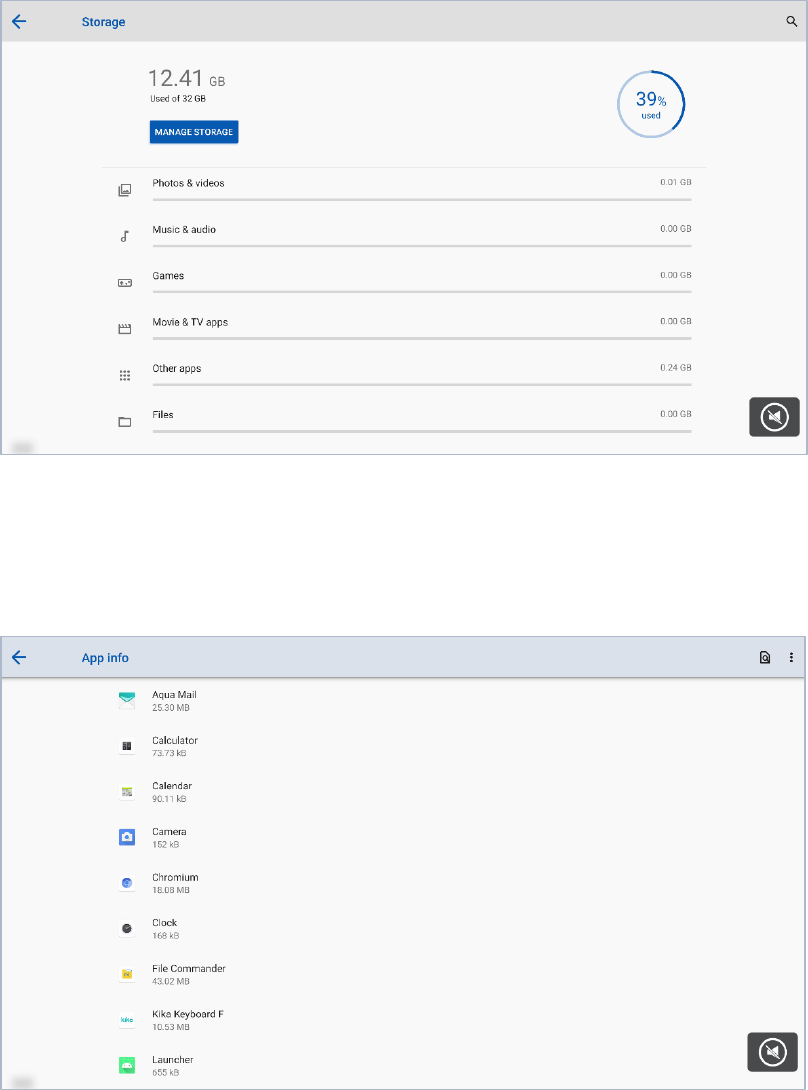
70
4.14.5 Applications
Enter the Apps submenu to view downloaded applications by type, running applications, and
all applications.
4.14.6 Display & Theme
Enter the Display & Theme submenu to set the theme, wallpaper, logo and font size.
Theme: Standard, abstract, galaxy, forest, classic, five themes can be chosen;
Wallpaper: Users can use default wallpaper, customize the wallpaper from file viewer;
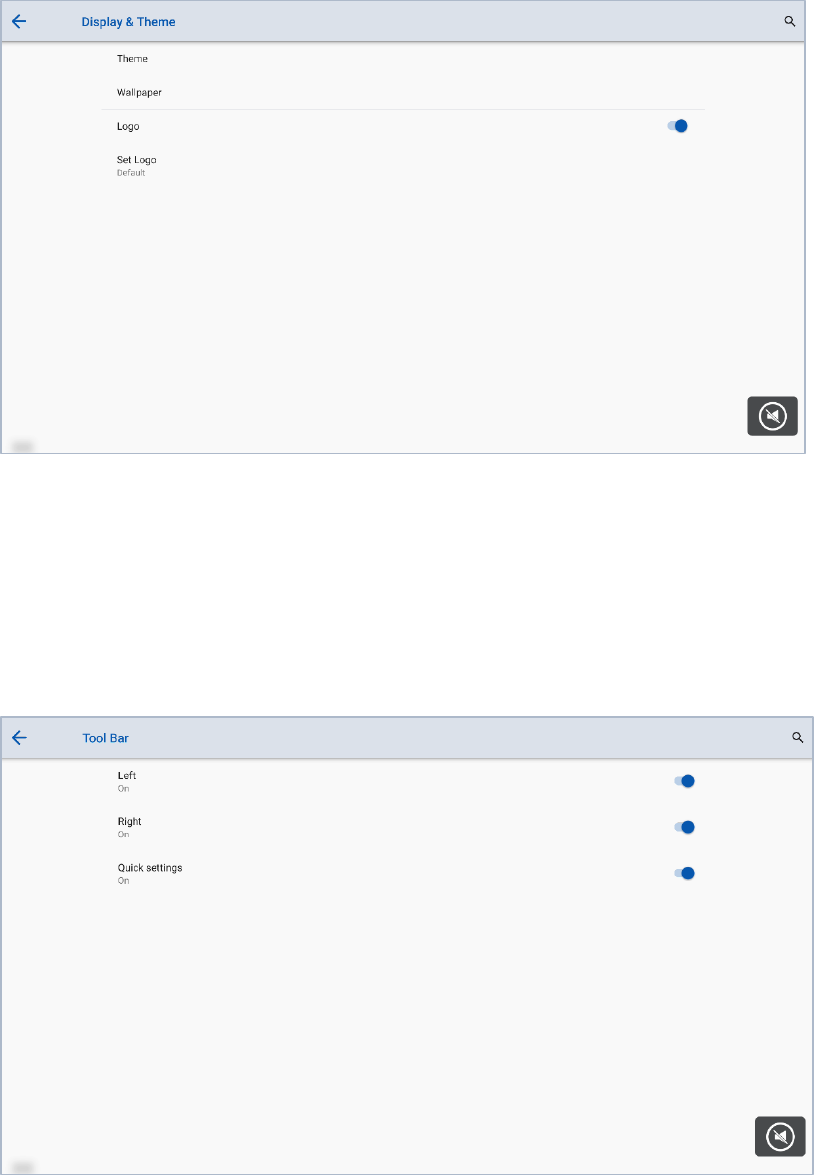
71
Logo: Tap the button to turn on/off the logo on the Home page;
Set logo: Users can use default logo or customize the logo from file viewer;
4.14.7 Tool Bar
Enter the Tool Bar submenu to set whether to display the tool bar.
Left: Tap to turn on/off the left tool bar.
Right: Tap to turn on/off the right tool bar.
Quick settings: Tap to turn on/off the tool bar on the Quick settings.
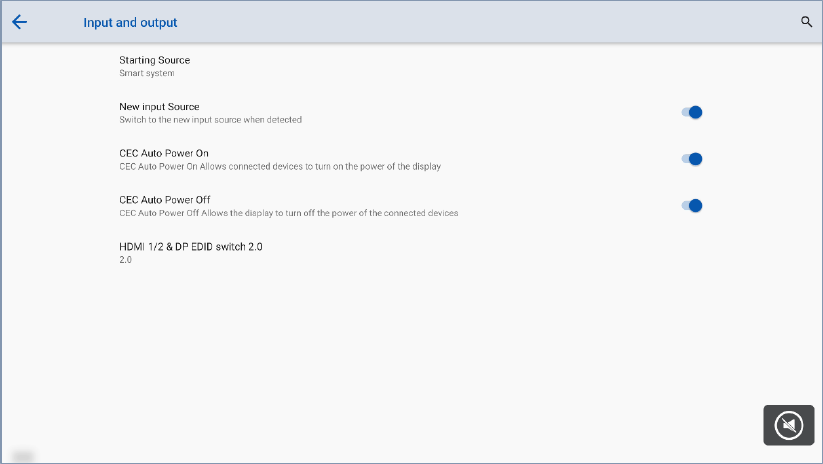
72
4.14.8 Input and Output Setting
Enter the Input and Output submenu to set the Home source and USB connection, enable
new input source and CEC auto.
Starting source: Customize settings to connect to the signal source after power on.
New input source: After the New input source function is enabled, the system can
automatically switch to the screen of the newly connected signal source.
CEC Auto Power On: “CEC Auto Power On” is enabled, When the HDMI port of the
panel is connected to a CEC device (such as a DVD), and both the CEC device and the
panel are turned off, if the CEC device is turned on, the panel automatically turns on
after receiving command from the CEC.
CEC Auto Power Off: “CEC Auto Power Off” is enabled, When the HDMI port of the
panel is connected to a CEC device, and both the CEC device and the panel are turned
on, if the panel is turned off, the CEC device automatically turns off after receiving the
command; if the CEC device is turned off, the panel automatically turns off after
receiving the command.
HDMI 1/2 & DP EDID switch 2.0: Tap the button to choose the HDMI1.4 or HDMI
2.0.
4.14.9 Power Setting
Enter the Power submenu to set power on or power off as following:
Auto power on/off: Tap the button to enable the function, users can set the power on/ off
on time.
Power on/off on time: Set the power on/ off time, system will automatic power on/off
on the customize time.
Energy saving: Set a duration after which the screen enters the lock mode if the screen
is left un-operated.
Power option: Set the system enter power off or sleep mode when users press power
button.
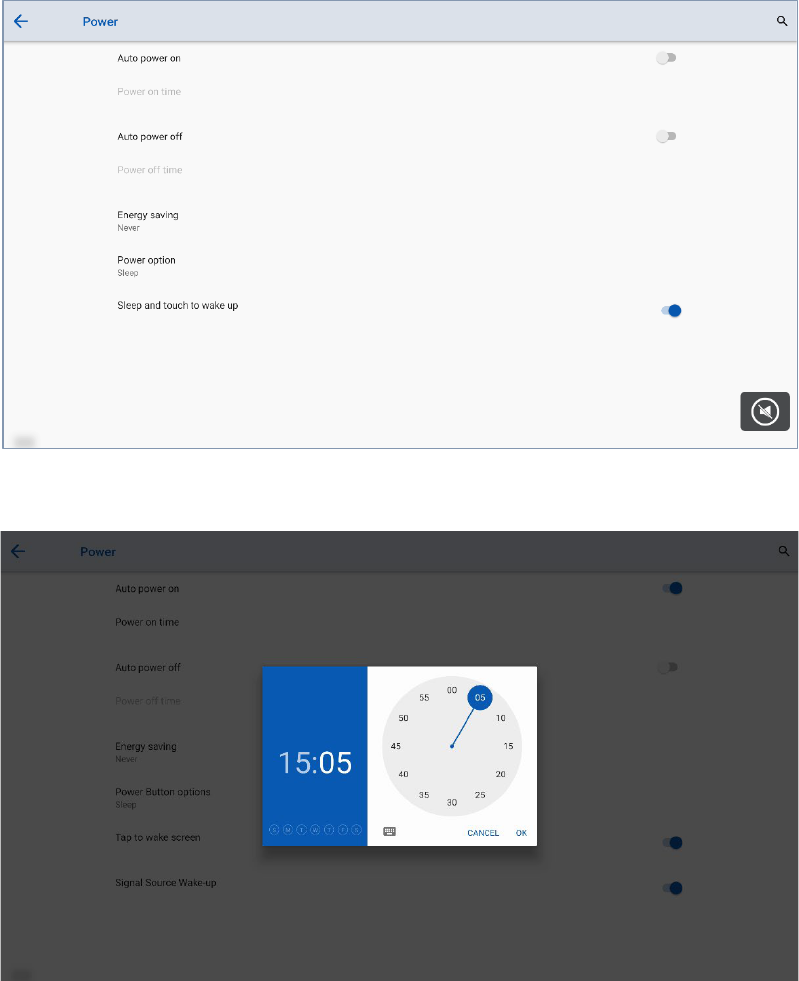
73
Sleep and touch to wake up: Tap the button to enable the function, users can touch the
screen to wake up the system from sleep mode.
To set the automatic power on time, select Auto power on, and set the power on time in
Power on time, as shown in the following figure.
To set the automatic power off time, select Auto power off, and set the power off time in
Power off time, as shown in the following figure.
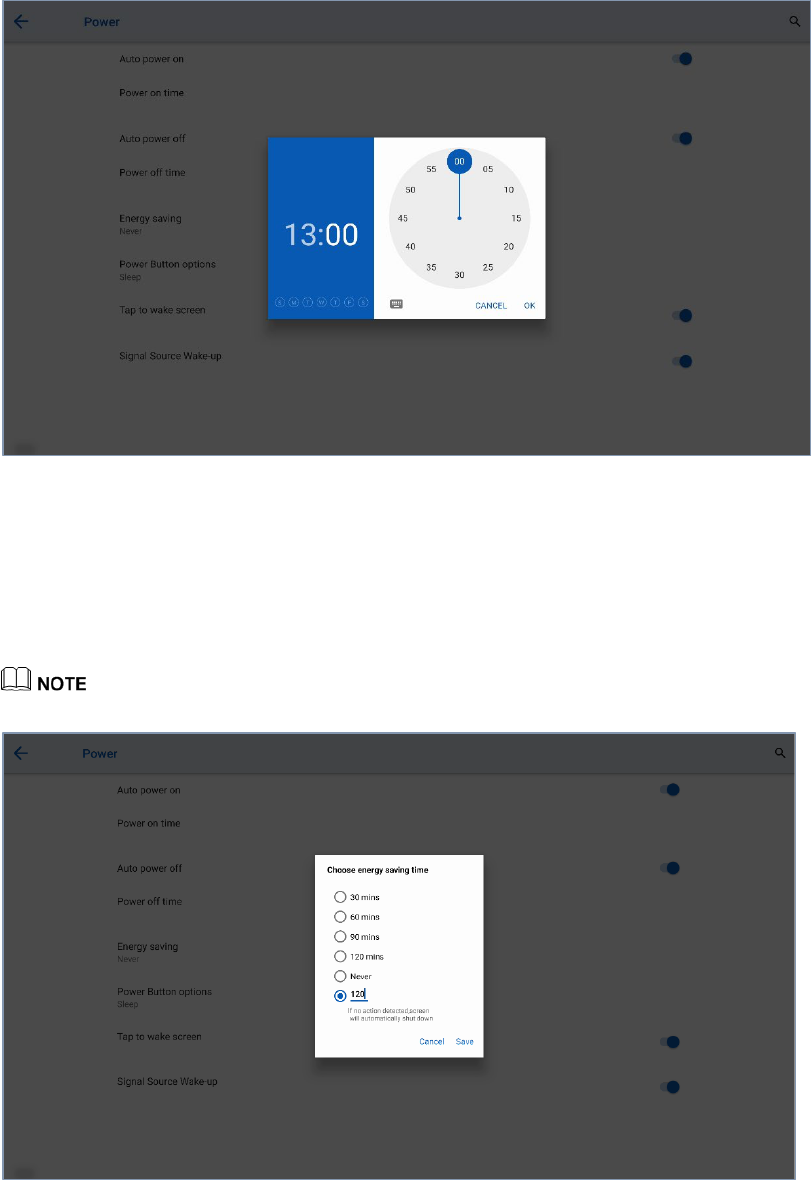
74
To set the energy saving time, tap Energy saving. In the dialog box that is displayed, set
a duration after which the screen enters the lock mode if the screen is left un-operated.
After the screen is locked, if the user does not operate the screen within 120s, the screen
enters the power off mode. The duration can be set to 30 MIN, 60 MIN, 90 MIN, or
NEVER. You can also customize this duration and the range is 3 minutes to 480
minutes.
NEVER indicates that the automatic power off mode function is not enabled.
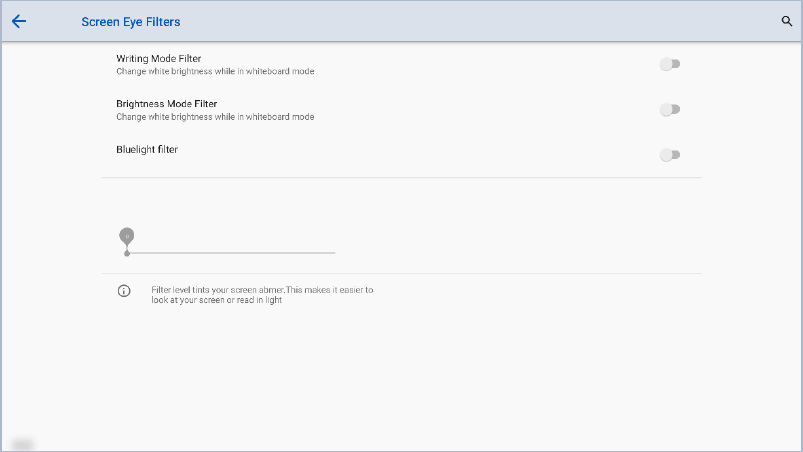
75
4.14.10 Screen Eye Filters
Enter the Screen Eye Filters submenu to set Writing Mode Filter, Brightness Mode Filter
and Bluelight filter. If only the Bluelight filter setting is on, the Filter level can be set.
When Writing Mode Filter is on, the display will change whiteboard brightness under
writing mode. When Brightness Mode Filter is on, the display will change screen brightness
based on ambient light. When Bluelight filter is on, the filter level tints your screen abmer,
this makes it easier to look at your screen or read in light.
Note:
Studies have shown that just as the ultra-violet rays can cause eye damage, the shortwave-length blue light
rays from displays can cause eyestrain, retina damage, and affect vision over time. Newline Blue Light filter is
an eye protection feature that can reduce the blue light. TT-6521Q /TT-7521Q /TT-8621Q has obtained this
certification.
For protecting your eyes against prolonged display use, we highly recommend you to do the
following:
Let your eyes rest for 10 minutes after 2 hours of continues use.
Roll your eyes upward towards your eyebrows, and then roll your eyes in a large circle
every few hours.
For every 20 minutes of display viewing, look into the distance for 20 seconds.
When your eyes get sore, close your eyes for a minute.
Using Low Blue Light
Decreasing the blue light emitting by the Interactive Flat panel display reduces the blue light
exposure to your eyes.
The Interactive Flat panel display use a low blue light panel default setting mode, that when
used in the default setting mode, is certified by TUV to reduce blue light output and create a
more relaxing and less stimulating image while reading content on the screen.
The hardware solution was developed to control the blue light range emission. Instead of
reducing the total blue range, the selected range reduction does not impact CCT and display
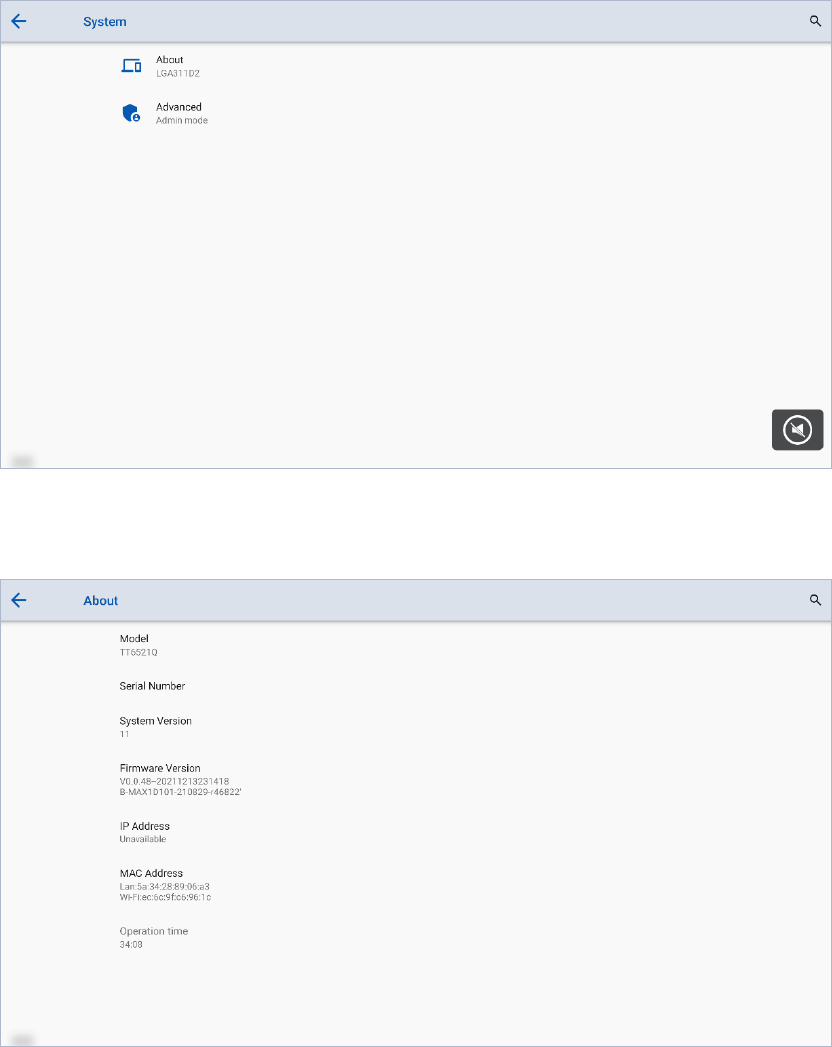
76
color. It exposes users to less blue light emission while letting them enjoy good color on the
display.
4.14.11 System
Enter the System submenu to see system version information and admin mode.
About
Enter About to check the system info such as Model, serial number, firmware version…etc.
Advanced
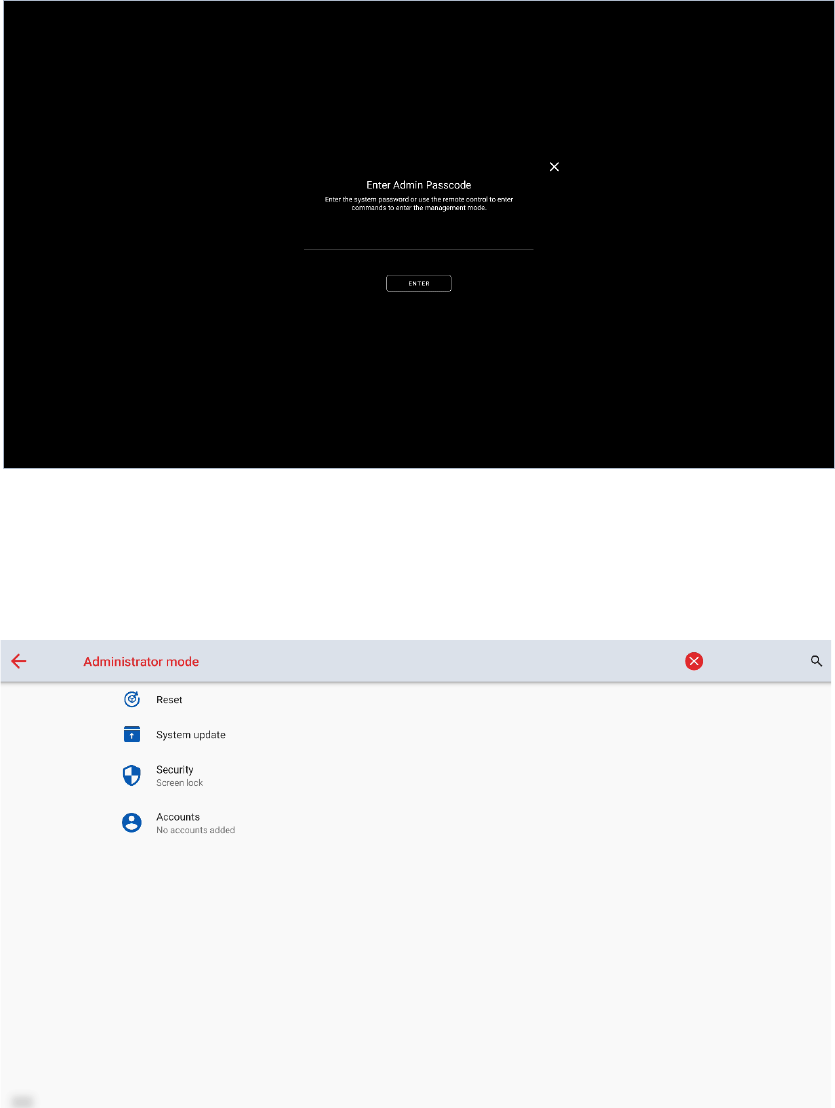
77
For enhance the security, and the better user experience, we collect the settings about the
security to the admin mode.
There are two ways to enter the admin mode:
Go to Settings → System → advanced, tap the admin mode, then use the floating
keyboard on the screen, enter the passkey 2364606633 to get into the admin mode.
Use remote control and press: UP> DOWN> UP> DOWN> LEFT> RIGHT> LEFT>
RIGHT> Brightness+> Brightness-, then you will see the admin mode pops up.
You can press the X button at the top of the right corner to exit it, or it will close
automatically if no operation detected after 5 minutes.
1. Reset
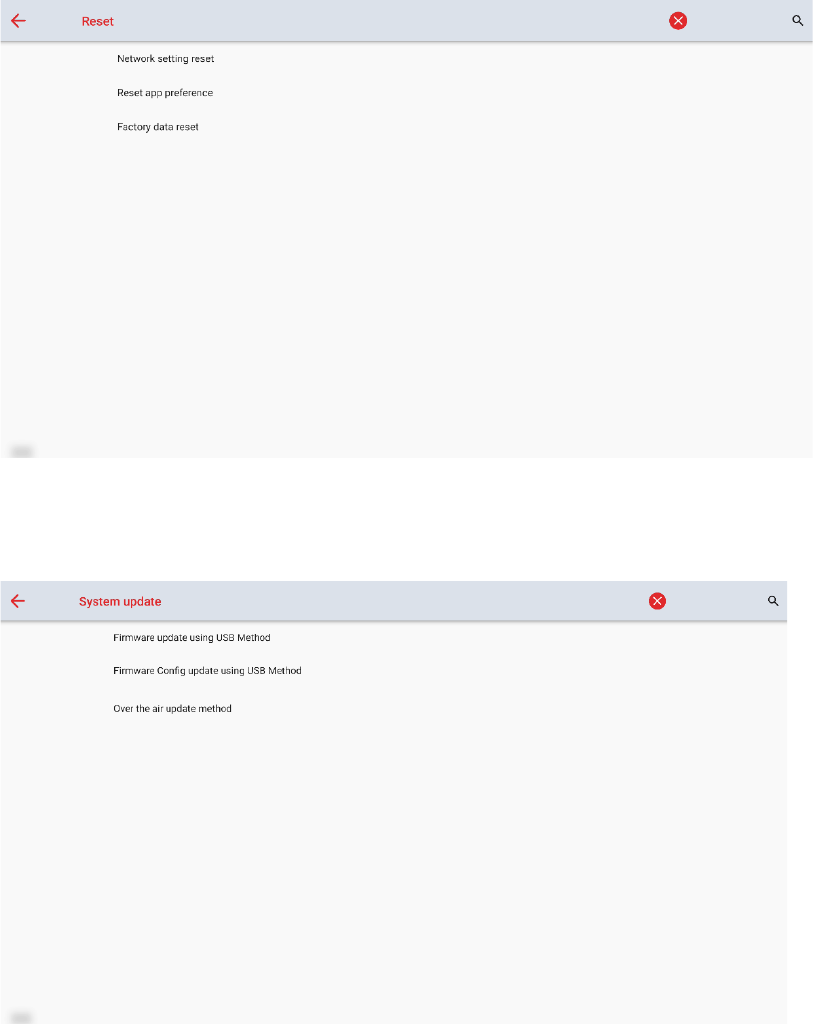
78
Enter the Reset submenu to set about the network settings reset, reset app preference and
factory data reset.
2. System update
Enter the System update submenu to set about Firmware update using USB method,
Firmware config update using USB method and over the air update method.
3. Security
Enter the Security submenu to set about whiteboard and screenshot data removal frequency
or USB lock.
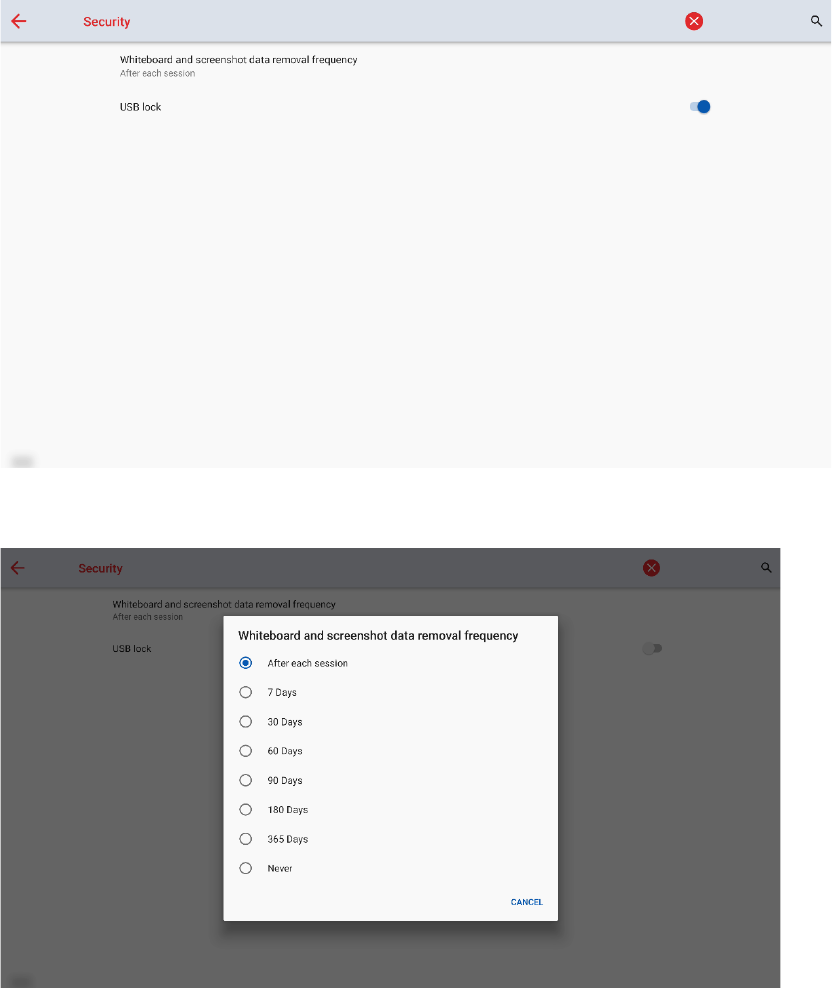
79
Whiteboard and screenshot data removal frequency: You can set the data clearance time
period, the default setting is never.
USB lock: When you enable the USB lock, under the smart system, only USB disk will
be locked, user will not able to read the data from the USB disk, but USB mouse and
keyboard could be used. Under the external source, all the USB devices will be blocked.
4. Accounts
Enter the Accounts setting to check the owner accounts, rename owner or reset account
passkey.
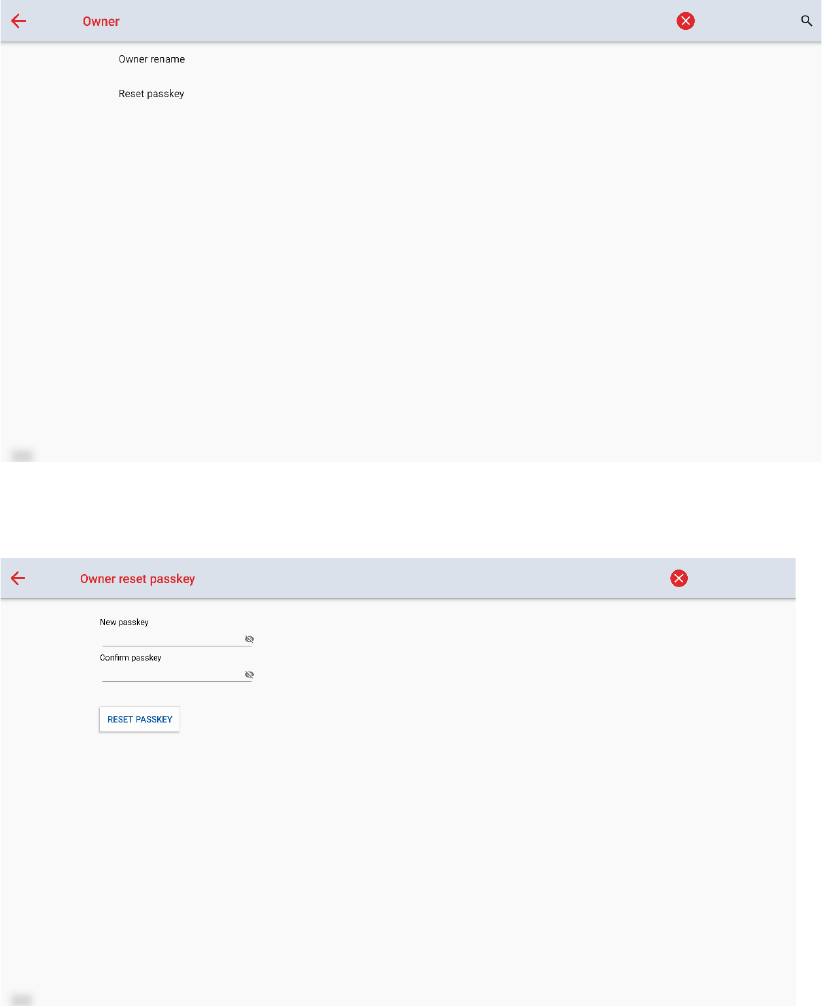
80
Owner rename: If you would like to change owner name, you can rename it here.
Reset passkey: If you would like to reset passkey, you can reset it here.
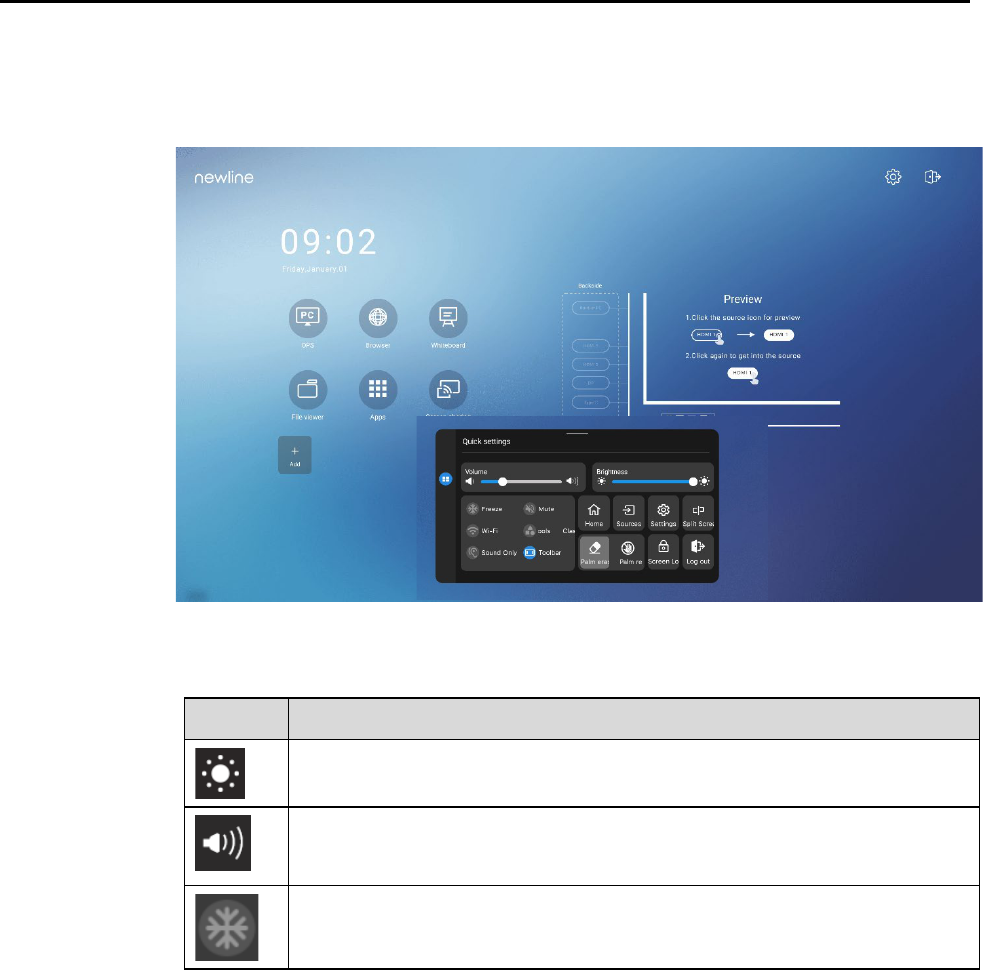
81
5 Quick Setting Menu
Using two fingers and swipe up from the bottom of the screen to access the Quick Settings
menu, as shown in the following figure.
Icon Functions
Drag the slider to adjust the brightness.
Drag the slider to adjust the volume.
Tap the icon to enable the Freeze Function.
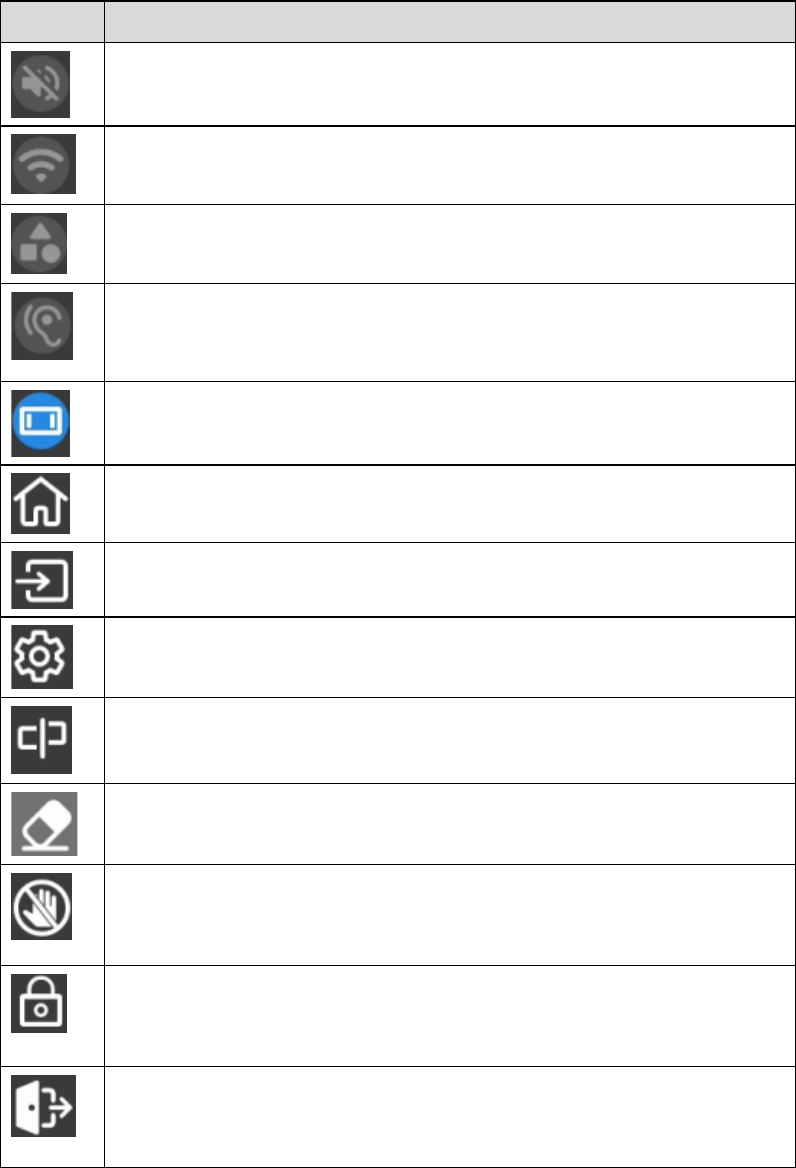
82
Icon Functions
Tap the icon to mute/unmute.
Tap the icon to enable or disable the embedded operating system Wi-Fi.
Tap the icon to launch the Newline Classroom Tools.
Tap the icon to enable sound only mode.
In sound only mode, the screen LCD displays and LED backlight turns off,
other functions will continue to work as normal.
Tap the icon to eable or disable the left toolbar.
Tap the icon to return to Home page.
Tap the icon to view the external signal sources.
Tap the icon to enter the settings page.
Tap the icon and choose an app to use in split screen.
Tap the icon to enable the palm eraser function.
Tap the icon to enable the palm rejection.
Tap the icon to lock/unlock the screen.
Tap the icon to log out of your profile.
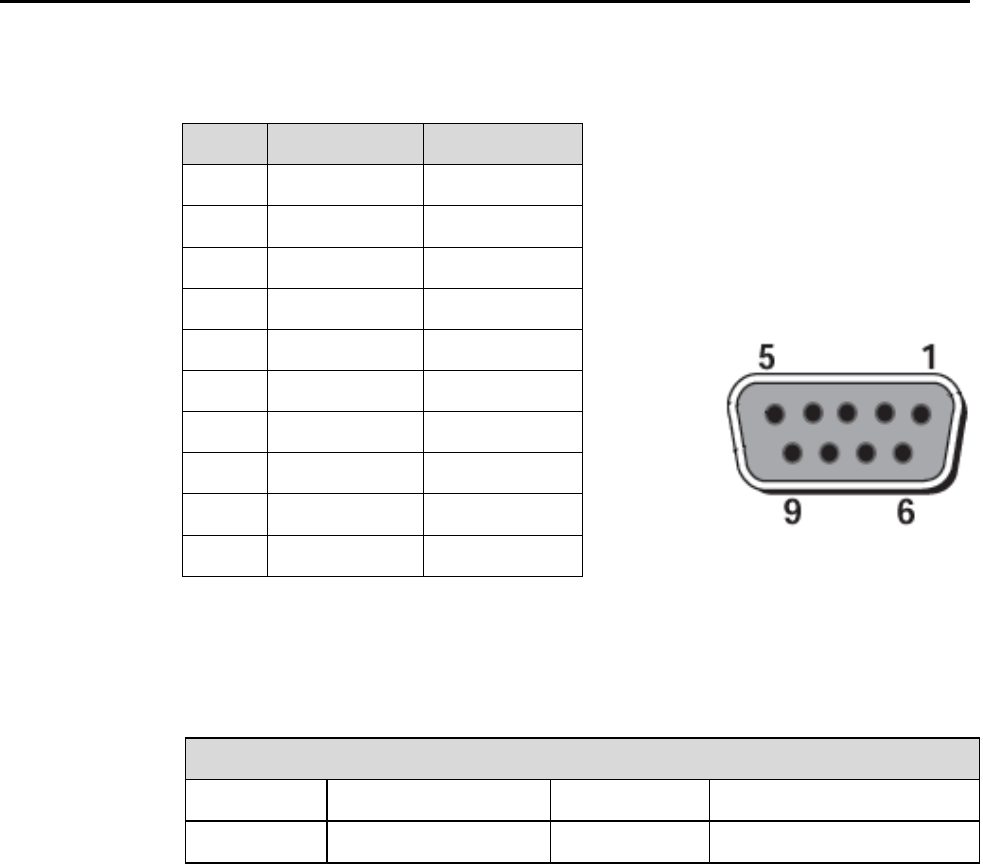
83
6 Serial Port Control
RS232 communication cable (please use cross data cables)
PIN This Device Computer
1 NC NC
2 RXD0 TXD0
3 TXD0 RXD0
4 NC NC
5 GND GND
6 NC NC
7 NC NC
8 NC NC
9 NC NC
Cover GND GND
Connect RS-232 port to the PC or controlling product. Enable RS-232 serial port connection
and complete the following configuration.
Port: COM1 (Set according to PC or controlling product’s port number)
Baud rate 115200 Odd/even check None
Data bits 8 Stop bit 1
The following tables list controlling codes, querying codes and return codes.
RS232 port of panel
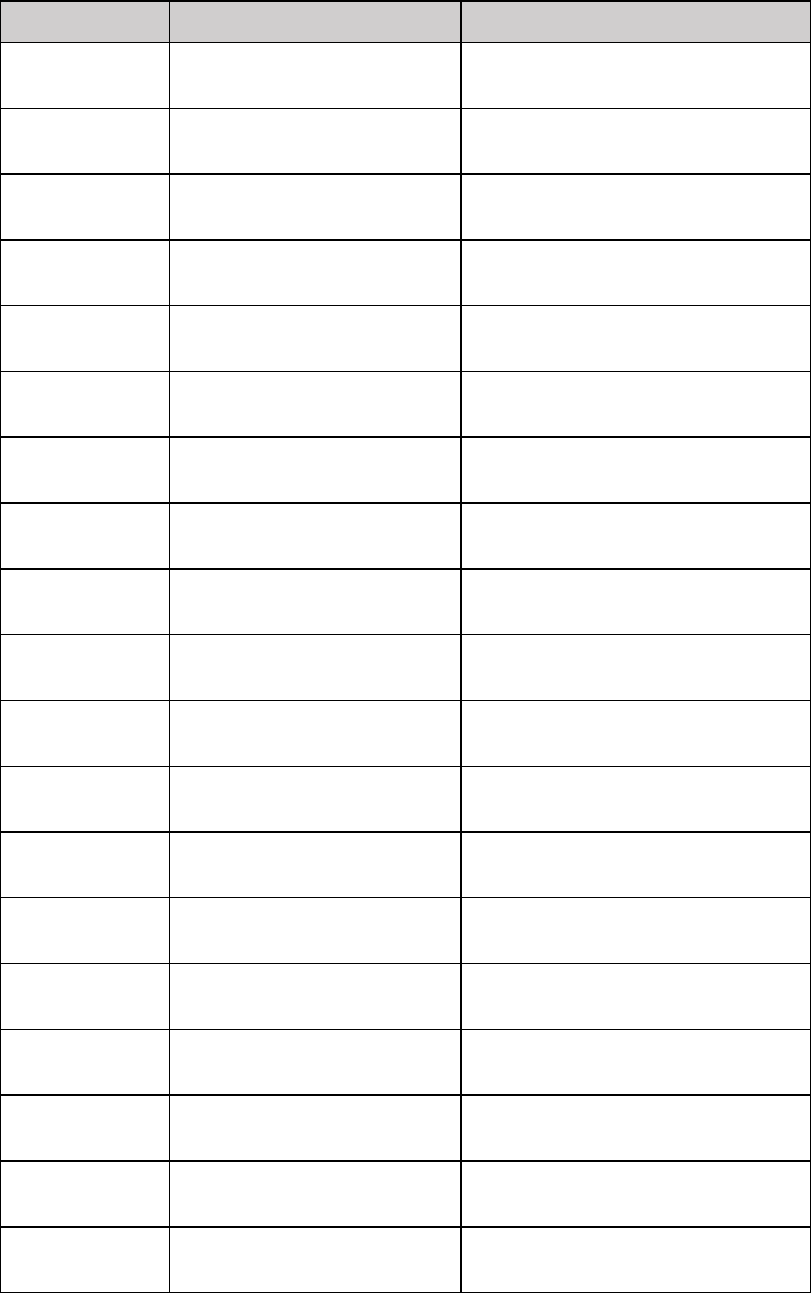
84
Function Controlling codes Return codes
Power on 7F 08 99 A2 B3 C4 02 FF 01
00 CF
7F 09 99 A2 B3 C4 02 FF 01 00 01
CF
Power off 7F 08 99 A2 B3 C4 02 FF 01
01 CF
7F 09 99 A2 B3 C4 02 FF 01 01 01
CF
Mute/Unmute 7F 08 99 A2 B3 C4 02 FF 01
02 CF
7F 09 99 A2 B3 C4 02 FF 01 02 01
CF
Signal source 7F 08 99 A2 B3 C4 02 FF 01
06 CF
7F 09 99 A2 B3 C4 02 FF 01 06 01
CF
Enable
whiteboard
7F 08 99 A2 B3 C4 02 FF 01
07 CF
7F 09 99 A2 B3 C4 02 FF 01 07 01
CF
Display status
7F 08 99 A2 B3 C4 02 FF 01
09 CF
7F 09 99 A2 B3 C4 02 FF 01 09 01
CF
HDMI front /
HDMI 1
7F 08 99 A2 B3 C4 02 FF 01
0A CF
7F 09 99 A2 B3 C4 02 FF 01 0A 01
CF
HDMI rear 1 /
HDMI 2
7F 08 99 A2 B3 C4 02 FF 01
52 CF
7F 09 99 A2 B3 C4 02 FF 01 52 01
CF
HDMI rear 2 /
HDMI 3
7F 08 99 A2 B3 C4 02 FF 01
53 CF
7F 09 99 A2 B3 C4 02 FF 01 53 01
CF
VGA / USB-C
(Front)
7F 08 99 A2 B3 C4 02 FF 01
54 CF
7F 09 99 A2 B3 C4 02 FF 01 54 01
CF
USB-C (Rear) 7F 08 99 A2 B3 C4 02 FF 01
55 CF
7F 09 99 A2 B3 C4 02 FF 01 55 01
CF
Internal PC 7F 08 99 A2 B3 C4 02 FF 01
38 CF
7F 09 99 A2 B3 C4 02 FF 01 38 01
CF
Internal SDM 7F 08 99 A2 B3 C4 02 FF 01
39 CF
7F 09 99 A2 B3 C4 02 FF 01 39 01
CF
DP 7F 08 99 A2 B3 C4 02 FF 01
56 CF
7F 09 99 A2 B3 C4 02 FF 01 56 01
CF
Page up 7F 08 99 A2 B3 C4 02 FF 01
13 CF
7F 09 99 A2 B3 C4 02 FF 01 13 01
CF
Page down
7F 08 99 A2 B3 C4 02 FF 01
14 CF
7F 09 99 A2 B3 C4 02 FF 01 14 01
CF
VOL - 7F 08 99 A2 B3 C4 02 FF 01
17 CF
7F 09 99 A2 B3 C4 02 FF 01 17 01
CF
VOL + 7F 08 99 A2 B3 C4 02 FF 01
18 CF
7F 09 99 A2 B3 C4 02 FF 01 18 01
CF
Menu 7F 08 99 A2 B3 C4 02 FF 01
1B CF
7F 09 99 A2 B3 C4 02 FF 01 1B 01
CF
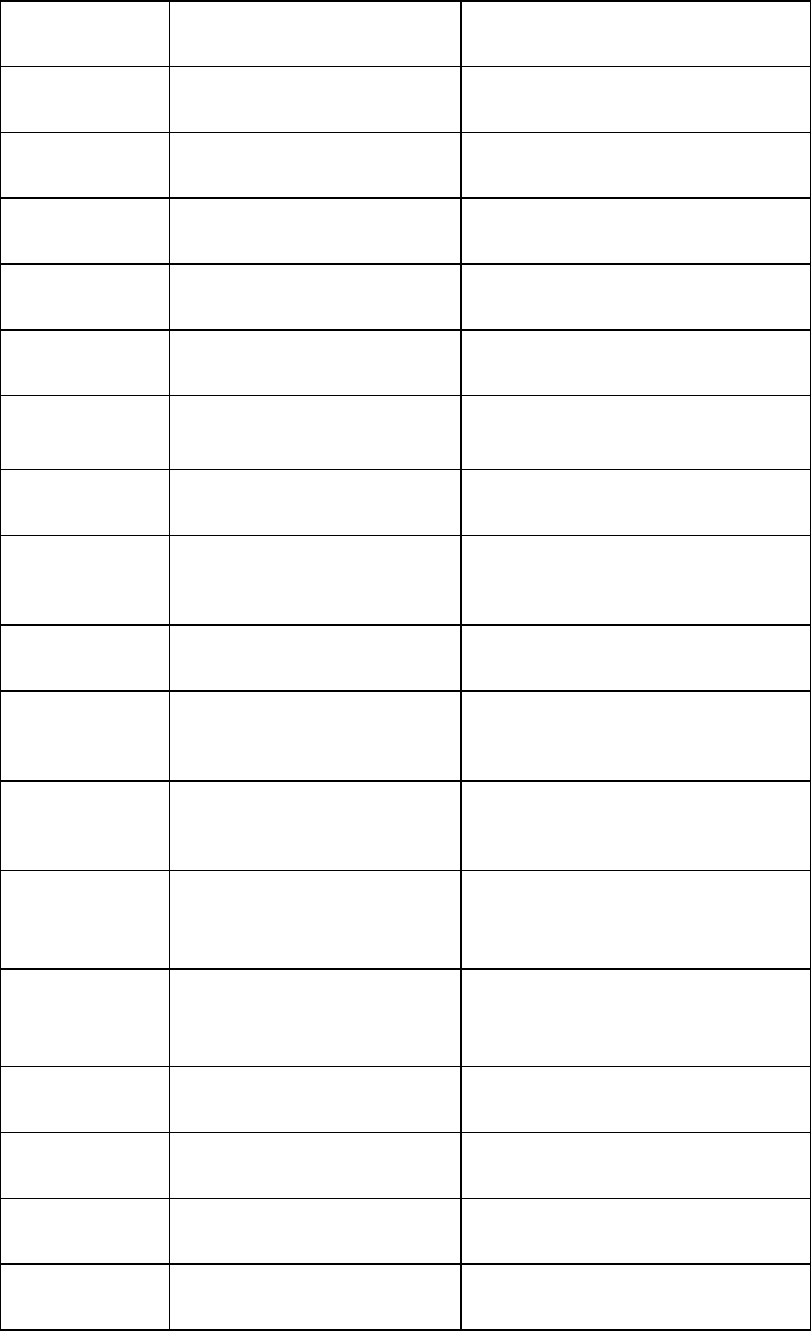
85
Home page 7F 08 99 A2 B3 C4 02 FF 01
1C CF
7F 09 99 A2 B3 C4 02 FF 01 1C 01
CF
Return (exit) 7F 08 99 A2 B3 C4 02 FF 01
1D CF
7F 09 99 A2 B3 C4 02 FF 01 1D 01
CF
OK
7F 08 99 A2 B3 C4 02 FF 01
2B CF
7F 09 99 A2 B3 C4 02 FF 01 2B 01
CF
← 7F 08 99 A2 B3 C4 02 FF 01
2C CF
7F 09 99 A2 B3 C4 02 FF 01 2C 01
CF
→ 7F 08 99 A2 B3 C4 02 FF 01
2D CF
7F 09 99 A2 B3 C4 02 FF 01 2D 01
CF
↑ 7F 08 99 A2 B3 C4 02 FF 01
2E CF
7F 09 99 A2 B3 C4 02 FF 01 2E 01
CF
↓
7F 08 99 A2 B3 C4 02 FF 01
2F CF
7F 09 99 A2 B3 C4 02 FF 01 2F 01
CF
Set volume 7F 08 99 A2 B3 C4 02 FF 05
XX CF
7F 09 99 A2 B3 C4 02 FF 05 XX 01
CF
Query the
firmware version
number
7F 08 99 A2 B3 C4 02 FF 01
3D CF
7F 09 99 A2 B3 C4 02 FF 01 3D XX
CF
Set display mode
7F 08 99 A2 B3 C4 02 FF 06
XX CF
7F 09 99 A2 B3 C4 02 FF 06 XX 01
CF
Enable the
annotation
function
7F 08 99 A2 B3 C4 02 FF 01
40 CF
7F 09 99 A2 B3 C4 02 FF 01 40 01
CF
Increase
backlight
brightness
7F 08 99 A2 B3 C4 02 FF 01
47 CF
7F 09 99 A2 B3 C4 02 FF 01 47 01
CF
Decrease
backlight
brightness
7F 08 99 A2 B3 C4 02 FF 01
48 CF
7F 09 99 A2 B3 C4 02 FF 01 48 01
CF
Set the value of
backlight
brightness
7F 08 99 A2 B3 C4 02 FF 09
XX CF
7F 09 99 A2 B3 C4 02 FF 09 XX 01
CF
Switch backlight 7F 08 99 A2 B3 C4 02 FF 01
15 CF
7F 09 99 A2 B3 C4 02 FF 01 15 XX
CF
Switch to screen
lock
7F 08 99 A2 B3 C4 02 FF 01
57 CF
7F 09 99 A2 B3 C4 02 FF 01 57 01
CF
Screenshot 7F 08 99 A2 B3 C4 02 FF 01
1F CF
7F 09 99 A2 B3 C4 02 FF 01 1F 01
CF
Settings 7F 08 99 A2 B3 C4 02 FF 01
20 CF
7F 09 99 A2 B3 C4 02 FF 01 20 01
CF

86
Freeze ON/OFF
toggle
7F 08 99 A2 B3 C4 02 FF 01
3B CF
7F 09 99 A2 B3 C4 02 FF 01 3B 01
CF
Freeze On 7F 09 99 A2 B3 C4 02 FF 0B
00 CF
7F 09 99 A2 B3 C4 02 FF 0B 00 01
CF
Freeze Off
7F 09 99 A2 B3 C4 02 FF 0B
01 CF
7F 09 99 A2 B3 C4 02 FF 0B 01 01
CF
Mute On 7F 09 99 A2 B3 C4 02 FF 0F
00 CF
7F 09 99 A2 B3 C4 02 FF 0F 00 01
CF
Mute Off 7F 09 99 A2 B3 C4 02 FF 0F
01 CF
7F 09 99 A2 B3 C4 02 FF 0F 01 01
CF
Switch Safety
Lock On
7F 09 99 A2 B3 C4 02 FF 0D
01 CF
7F 09 99 A2 B3 C4 02 FF 0D 01 01
CF
Switch Safety
Lock Off
7F 09 99 A2 B3 C4 02 FF 0D
00 CF
7F 09 99 A2 B3 C4 02 FF 0D 00 01
CF
Switch Backlight
On
7F 09 99 A2 B3 C4 02 FF 0E
01 CF
7F 09 99 A2 B3 C4 02 FF 0E 01 01
CF
Switch Backlight
Off
7F 09 99 A2 B3 C4 02 FF 0E
00 CF
7F 09 99 A2 B3 C4 02 FF 0E 00 01
CF
Set Display
message on the
OSD
7F 09 99 A2 B3 C4 02 FF 1A
XX CF
7F 09 99 A2 B3 C4 02 FF 1A 00 XX
CF
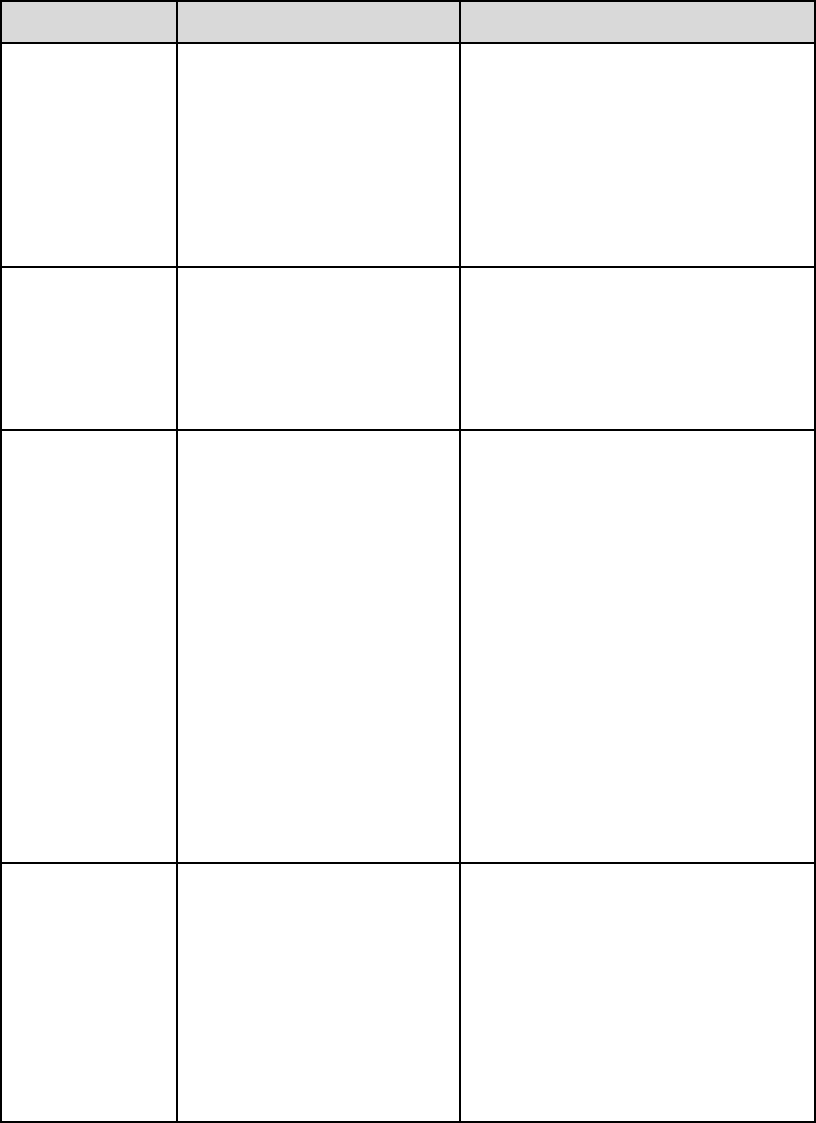
87
Function Querying codes Return codes
Power supply
7F 08 99 A2 B3 C4 02 FF 01
37 CF
7F 09 99 A2 B3 C4 02 FF 01 37 XX
CF
Notes:
XX indicates the power on/off state.
XX = 01: power on state;
XX = 00: power off state.
Speaker
7F 08 99 A2 B3 C4 02 FF 01
82 CF
7F 09 99 A2 B3 C4 02 FF 01 82 XX
CF
Notes:
01: mute;
00: non-mute.
Current signal
source
7F 08 99 A2 B3 C4 02 FF 01
50 CF
7F 09 99 A2 B3 C4 02 FF 01 50 XX
CF
Notes:
Smart system = 30;
PC = 17;
DP = 20;
HDMI rear 1 = 1F;
HDMI Rear 2 = 1E;
VGA = 00;
HDMI Front = 19;
Type C = 22.
Speaker volume
7F 08 99 A2 B3 C4 02 FF 01
33 CF
7F 09 99 A2 B3 C4 02 FF 01 33 XX
CF
Notes:
XX indicates current volume value
(XX is a hexadecimal value, range:
00~64).
For example, XX = 20 indicates
current volume value is 32 (decimal
value), XX = 00 indicates mute state.
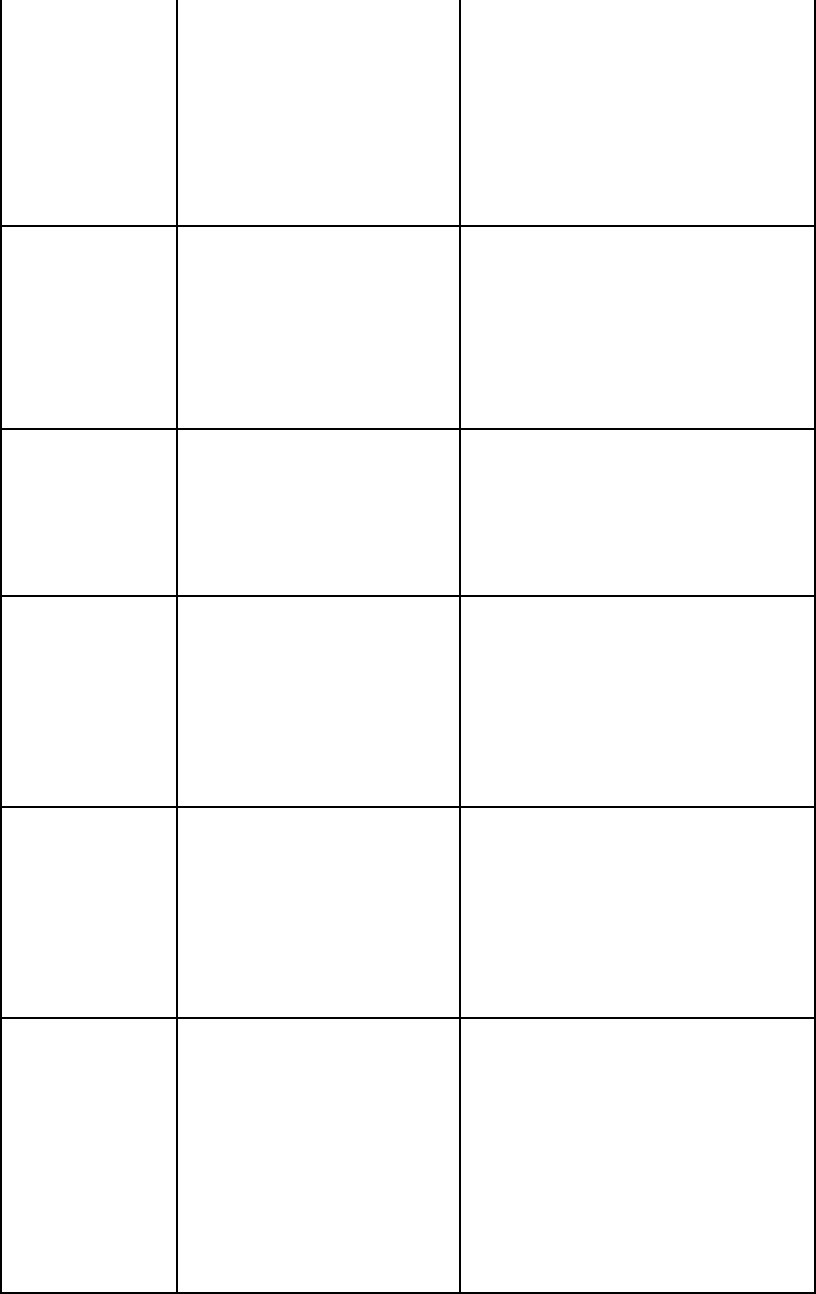
88
D.Mode
7F 08 99 A2 B3 C4 02 FF 01
35 CF
7F 09 99 A2 B3 C4 02 FF 01 35 XX
CF
Notes:
XX indicates the mode.
XX = 00-standard;
XX = 01-ECO mode;
XX = 02-auto.
Backlight
brightness
7F 08 99 A2 B3 C4 02 FF 01
49 CF
7F 09 99 A2 B3 C4 02 FF 01 49 XX
CF
Notes:
XX indicates the value of backlight
brightness (0 - 100), corresponding to
the hexadecimal number system (00 -
64).
Backlight status
7F 08 99 A2 B3 C4 02 FF 01
81 CF
7F 09 99 A2 B3 C4 02 FF 01 81 XX
CF
Notes:
XX = 00 indicates the backlight is on.
XX = 01 indicates the backlight is off.
Screen lock status
7F 08 99 A2 B3 C4 02 FF 01
84 CF
7F 09 99 A2 B3 C4 02 FF 01 84 XX
CF
Notes:
XX = 01 indicates the child safety lock
is on.
XX = 00 indicates the child safety lock
is off.
Whiteboard state
7F 08 99 A2 B3 C4 02 FF 01
83 CF
7F 09 99 A2 B3 C4 02 FF 01 83 XX
CF
Notes:
XX = 01 indicates the whiteboard
state.
XX = 00 indicates non-whiteboard
state.
Return to system
state of the
previous options
7F 08 99 A2 B3 C4 02 FF 0A
00 CF
7F 08 99 A2 B3 C4 02 FF 0A 00 AB
CD EF GH IJ OP QR ST UV CF
Notes:
AB: Power supply;
CD: Speaker;
EF: Current signal source;
GH: Speaker volume;
IJ: D.Mode;

89
OP: backlight brightness;
QR: backlight state;
ST: Whiteboard state;
UV: Screen lock state.
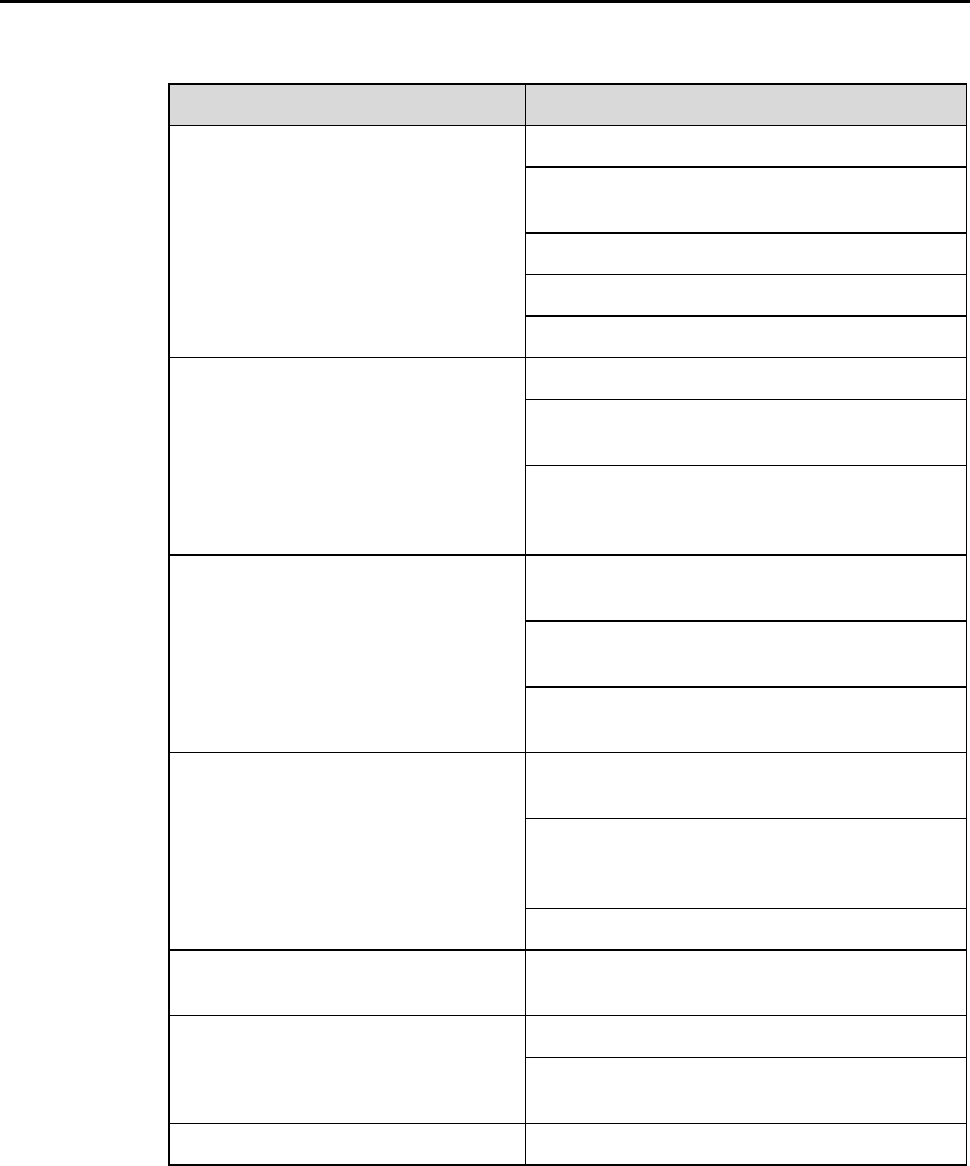
90
7 FAQs & Troubleshooting
Symptom Troubleshooting Methods
The screen cannot be powered on or
the power indicator light is off.
Check whether the power supply is connected.
Check whether the power supply plug is properly
connected.
Check whether the power outlet has electricity.
Check whether the rocker switch is enabled.
Press the reset switch and start the system again.
The remote control is not causing a
response.
Replace the batteries.
Check whether the polarity direction of the
batteries is correct.
Align the remote control with the IR receiver
window. For details, see section "Remote
Control".
The image is normal but there is no
sound.
Increase volume on both the screen and the
Windows system.
Check whether the screen and the Windows
system are muted.
If an external computer is connected, check
whether the connection cables are normal.
The system is automatically powered
on/off when no operation is being
performed.
Disable the automatic power-on/off function. For
details, see section "Power ON/OFF Setting".
Check whether the screen entered shut down
mode due to no operation for an extended period
of time.
Check whether the input power supply is stable.
The colors of images are abnormal. Check whether the HDMI cable is properly
connected or has any quality issue.
The touch function is abnormal or the
positioning is inaccurate.
Restart the screen.
In the Windows system, recalibrate the screen.
For details, see section "Calibration".
The touch function is unavailable when Switch between different external signal sources.
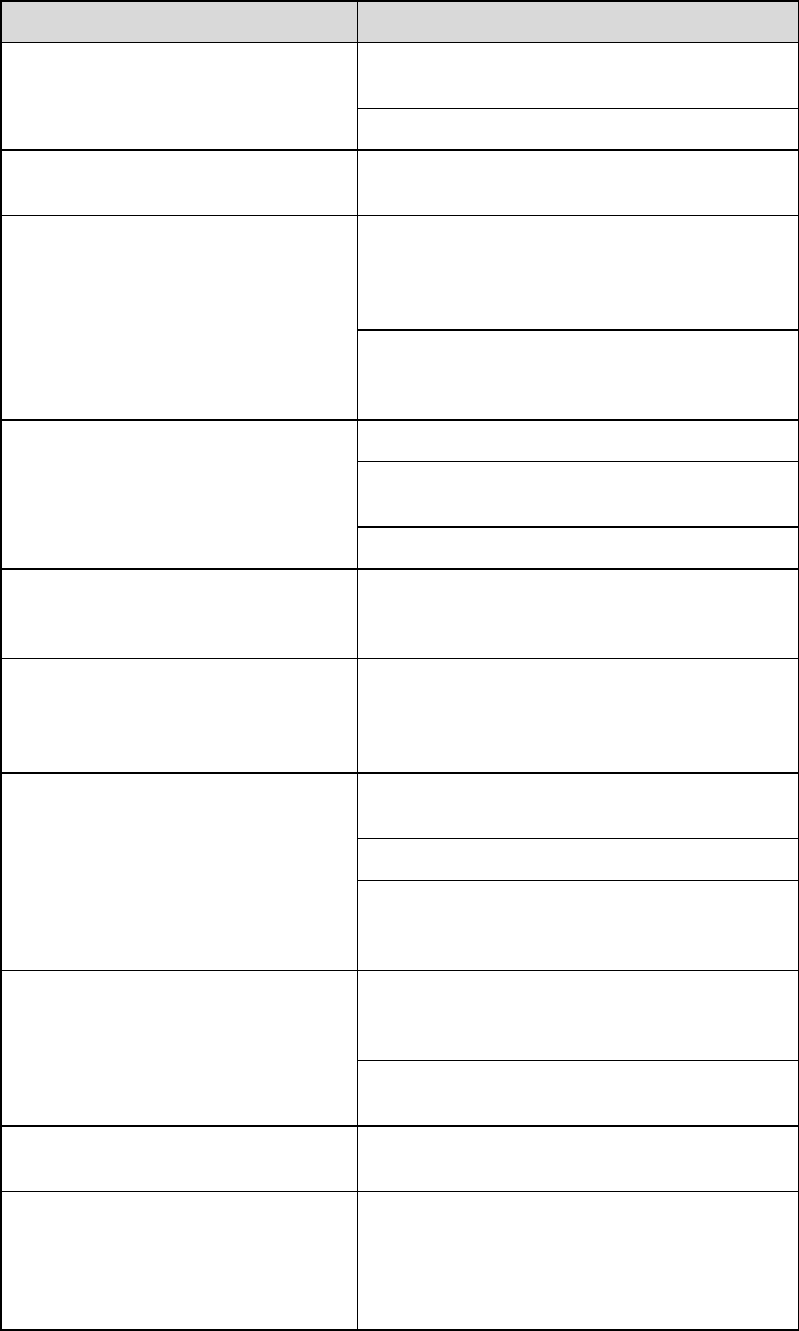
91
Symptom Troubleshooting Methods
the external signal source channel is
being used.
Ensure that the USB touch cable is connected to
the proper port. For details, see section "Ports".
Remove and insert the USB touch cable again.
There is no sound when the HDMI in
channel is used.
Remove and insert the HDMI cable again.
No image is displayed when the HDMI
out channel is used.
Generally, this issue is caused by the
compatibility of the external display product.
Replace the external display product and test
again.
The HDMI cable is too long or has a poor
quality. Replace the HDMI cable delivered with
the product.
The touch function on the front panel is
ineffective.
Touch the button using your full fingertip.
Check whether the finger is wet or has other
liquids on it.
Restart the screen.
The USB flash drive cannot be
identified.
Check whether the USB flash drive is inserted
into the correct USB port. For details, see section
"Ports."
The conference records cannot be
saved on the USB flash drive, and the
system prompts "The target storage
product has no write permissions."
Format the USB flash drive to the FAT32 format.
The OPS has no signal. Check whether the OPS is properly inserted in
the slot.
Check whether the OPS is in shut down mode.
Press the power button on the OPS (for details,
see the instructions of the OPS), and manually
start up the OPS.
In the embedded operating system or
Windows system, no wireless network
can be found or the wireless network
signal is weak.
Check whether the Wi-Fi antenna is properly
installed on the embedded operating system. For
details, see section "Ports".
Check whether the Wi-Fi antenna is properly
installed for the OPS.
The keyboard is not correctly
displayed.
Confirm that the hardware keyboard is enabled.
When you connect a handheld
microphone to a port on the front panel,
the distance from user to microphone
should be no less than 1 meter,
otherwise the sound may distort.
The front panel doesn’t support handheld
microphone, and needs to use the fixed
microphone. To make sure of the sound quality,
the distance from user to microphone should be
no less than one meter.

92
Symptom Troubleshooting Methods
When the touch screen connects to
CEC facilities and powers down, touch
screen will stay in shut down mode
after power restart. CEC facilities can’t
recall the touch screen.
Please use the remote control to start and turn off
the touch screen. Then you can use the CEC
facilities to recall it.
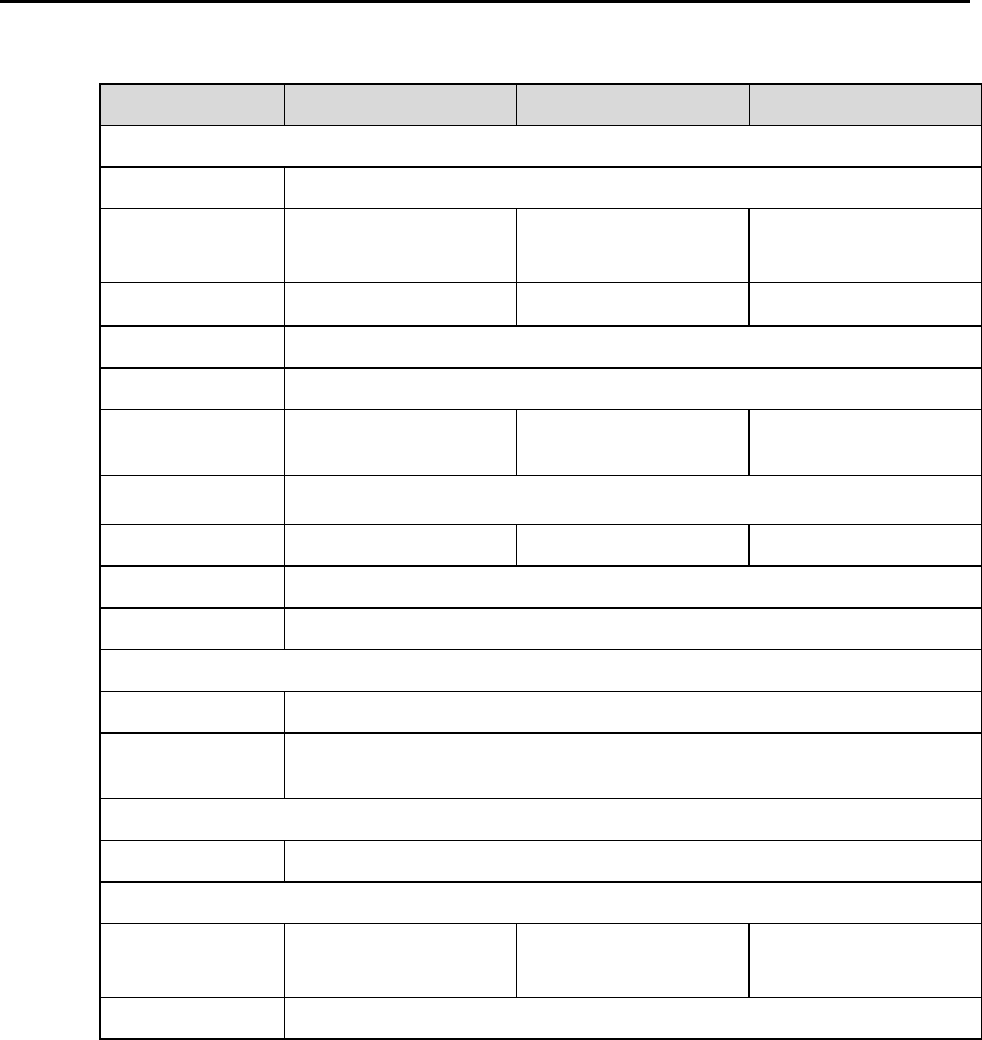
93
8 Specifications
Model
TT-6521Q TT-7521Q TT-8621Q
Display
Backlight LED
Display Area 56.24 x 31.63 in/
1432 x 807mm
64.97 in x 36.55 in/
1652 x 930mm
74.69 in x 42.05 in/
1893 x 1069mm
Active Screen Size 65 inch 75 inch 86 inch
Display Ratio 16:9
Resolution 3840 x 2160 Pixel
Display Colors 8 bit+FRC, 1.07 billion
colors
8 bit+FRC, 1.07 billion
colors
10 bit, 1.07 billion
colors
Brightness ≥ 400 cd/m
2
Contrast ≥5000:1 ≥5000:1 ≥5000:1
Response Time ≤ 8 ms
Life Time ≥50000 h (Min.)
Speaker
Speaker Position Forward
Max. Power
Output
2 x 15 W
Microphone
Type 3.5 mm interface
Electrical
Power
Consumption
Maximum ≤ 400 W
Standby Mode ≤ 0.5 W
Maximum ≤ 450 W
Standby Mode ≤ 0.5 W
Maximum ≤ 500 W
Standby Mode ≤ 0.5 W
Working Voltage AC 100 V – 240 V, 50 Hz / 60 Hz
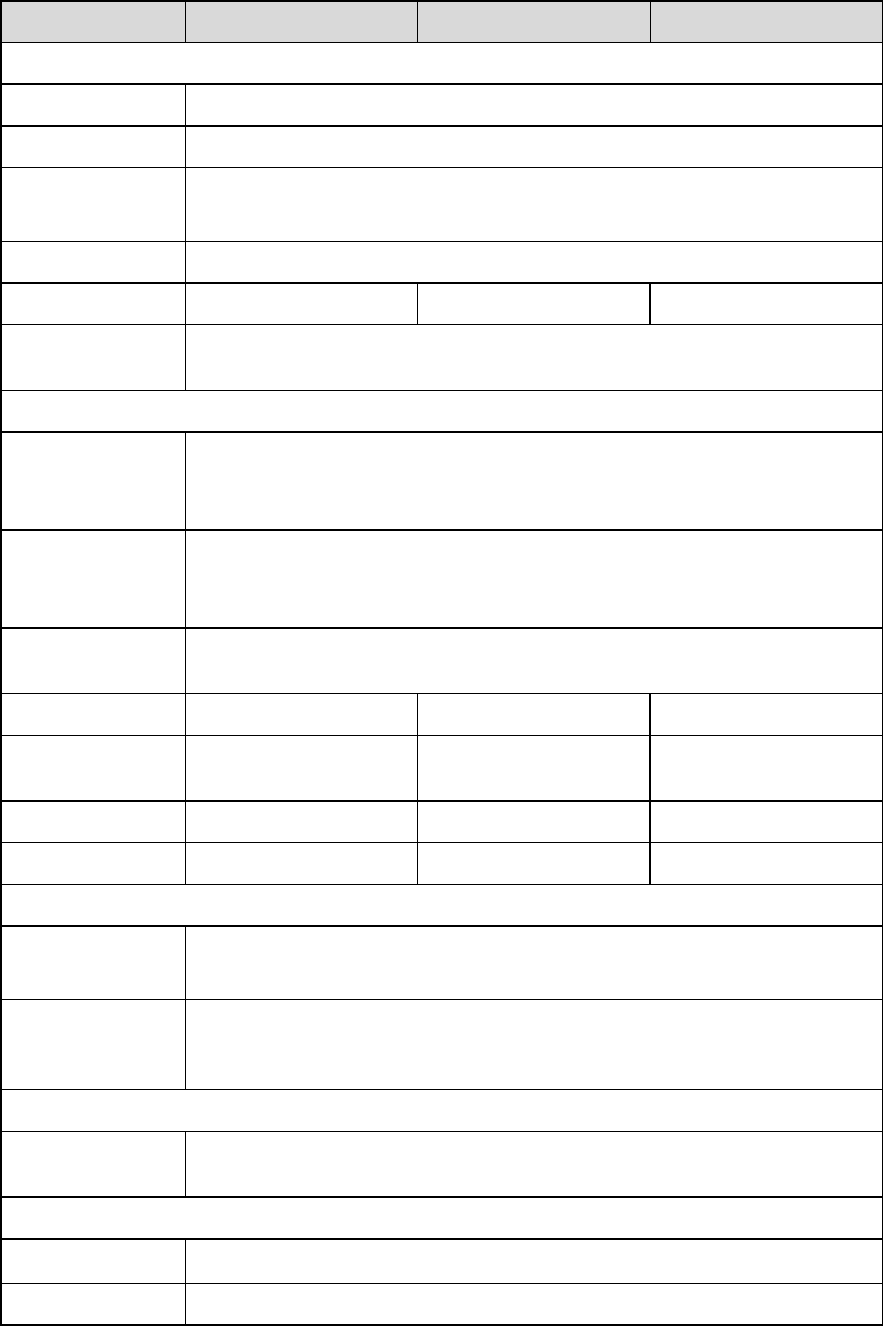
94
Model
TT-6521Q TT-7521Q TT-8621Q
Touch
Touch Surface Anti-glare tempered glass
Transparency 88%±3%
Touch Points
10 Points in Smart system
20 Points in Windows
Writing Tools Eraser, Stylus or Finger
Scan Speed ≤10ms ≤10ms ≤10ms
Communication
Interface
USB-A
Transportation/Storage
Storage
Temperature/
Humidity
-15℃~55℃/20~90%RH(Non coagulation)
Working
Temperature/
Humidity
0℃-40℃/20~80%RH(Non coagulation)
Mounting
(optional)
Wall-mounted/Floor Stand
Outline Dimension 1513x923x116mm 1735x1049x120mm 1981x1189x120mm
Packing
Dimension
1640*1036*207 mm 1859x1160x227 mm 2119x1290x250 mm
Net Weight approx. 39kg approx. 52kg approx. 65kg
Gross Weight 50±2kg 66±2kg 82±2kg
Ports
Front Interface
Inputs
HDMI In x 1, USB (Touch) x 1, USB 3.0 x 1, Microphone In x 1,
Type C x 1
Rear Interface
Inputs
RS-232 x 1, Line Out x 1, SPDIF out x 1, HDMI Out x 1, USB 3.0 (Public) x 2,
USB 3.0 (Android) x 1, Type C x 1, USB3.0 (Touch) x 3, HDMI 2/3 In x 2, DP
x 1, OPS Slots (4K@60Hz)
Other functions
Intelligent thermos
protector
Yes
Smart System
Chips
A311D2
RAM Standard with 4G(can be expanded to 8G)

95
Model
TT-6521Q TT-7521Q TT-8621Q
Flash 32GB build in + 64GB TF card
Multimedia File
Formats
Supports all major types of multi-media files
Pre-installed
applications
Refer to the actual panel display.

96
9 More Information
For More Information
Please visit our website (www.newline-interactive.com) for detailed instruction manual.
Contact Us for Support
Please email us at
support@newline-interactive.com.
Our company is devoted to product innovation and technology enhancement. Therefore, we
may change product specification and information without notice. Product pictures in the
manual are for reference only, please refer to actual products.
